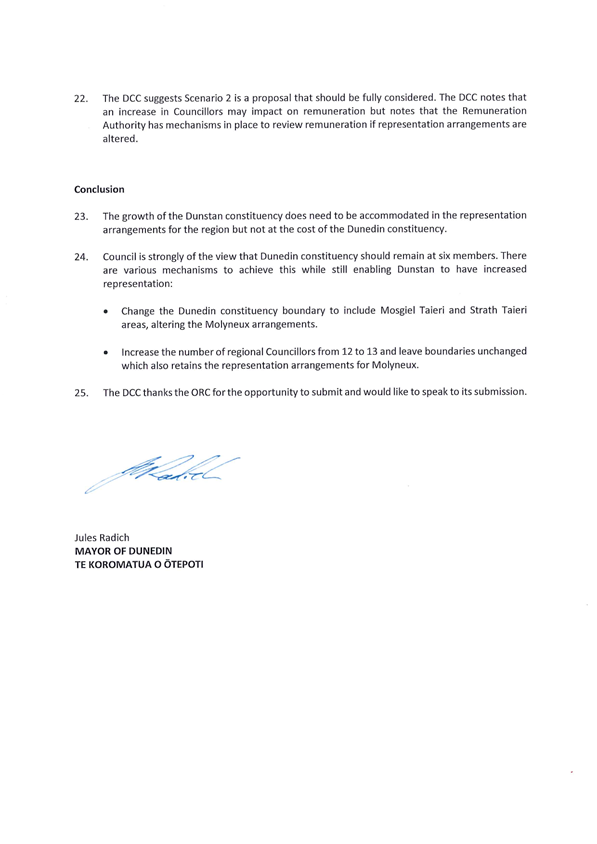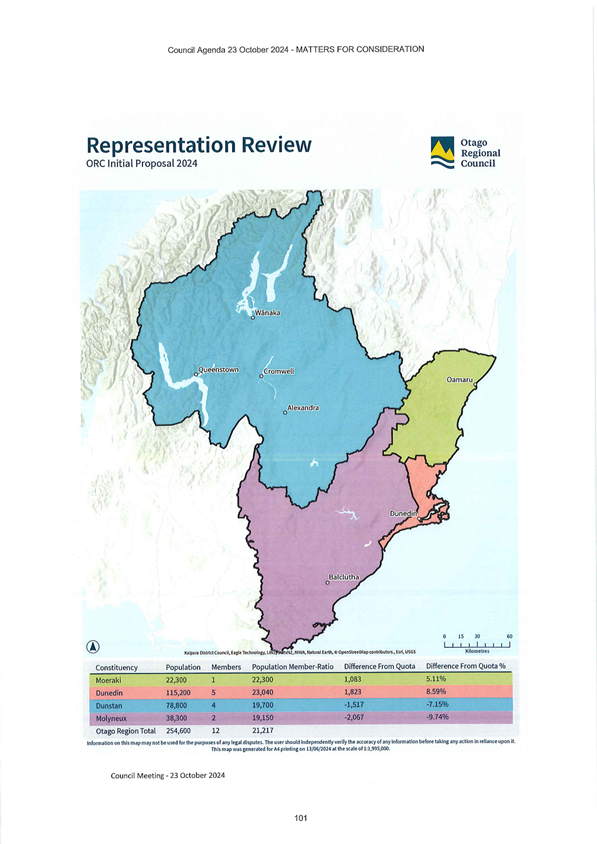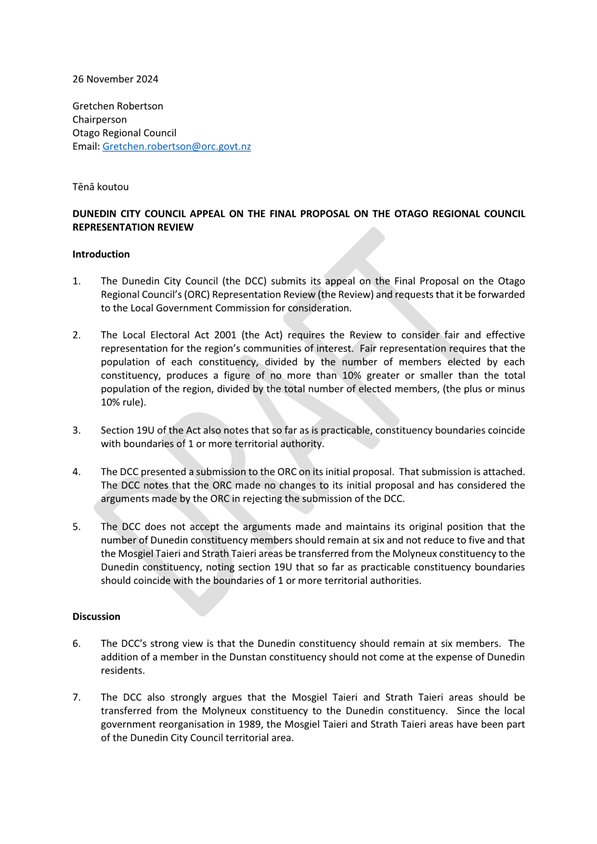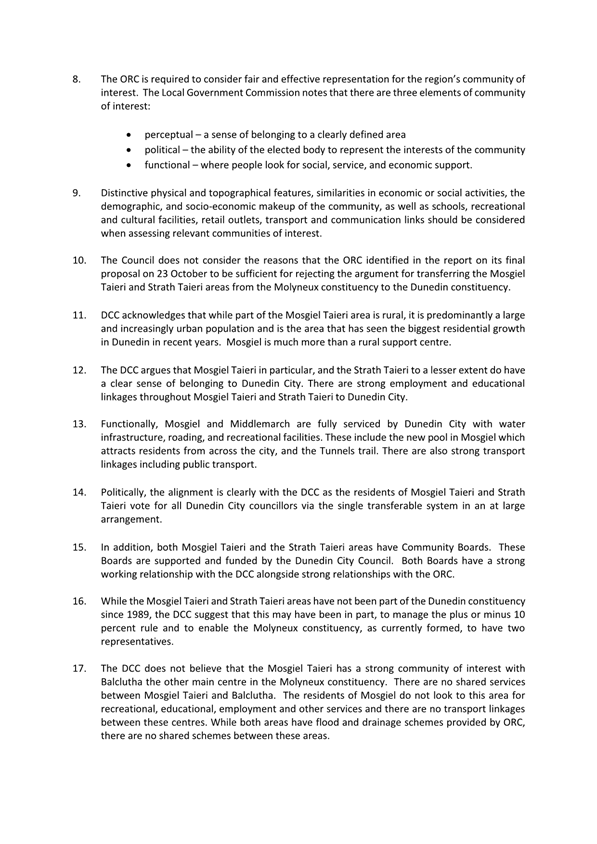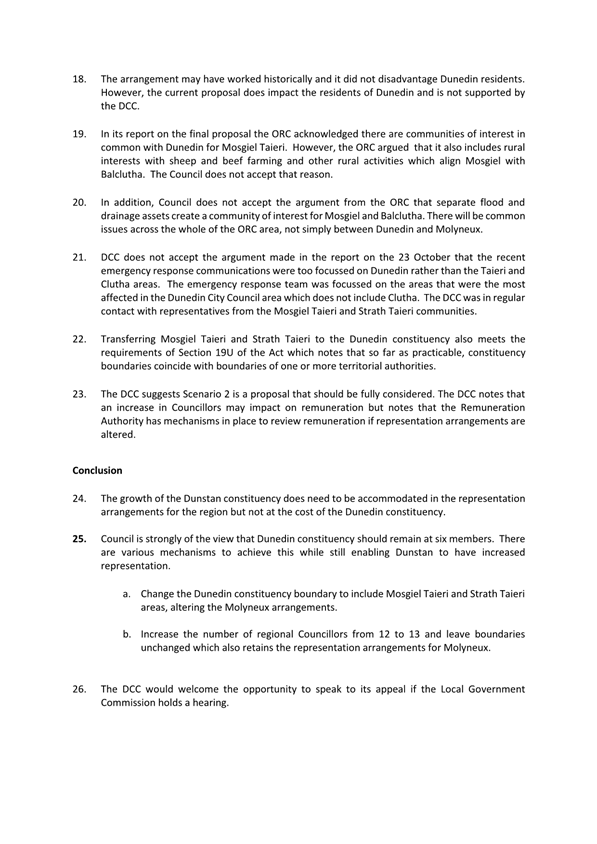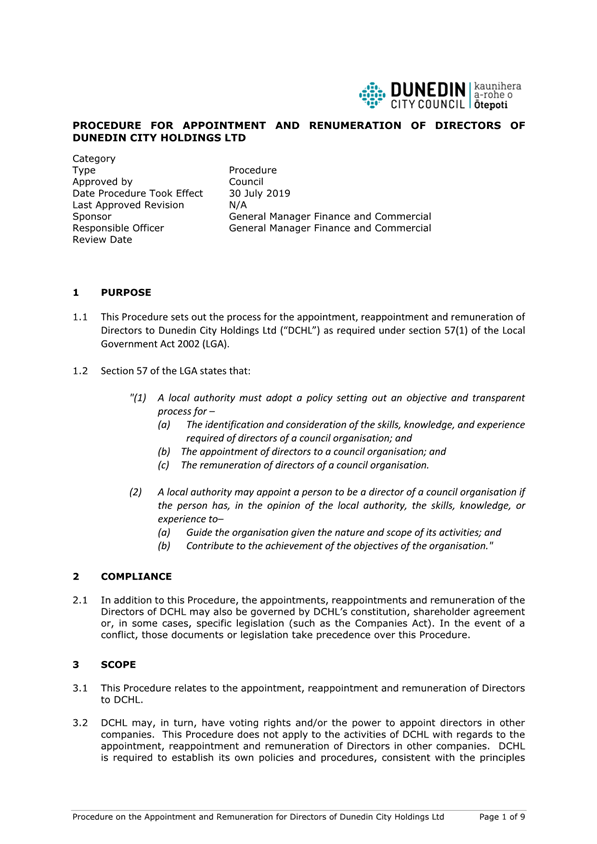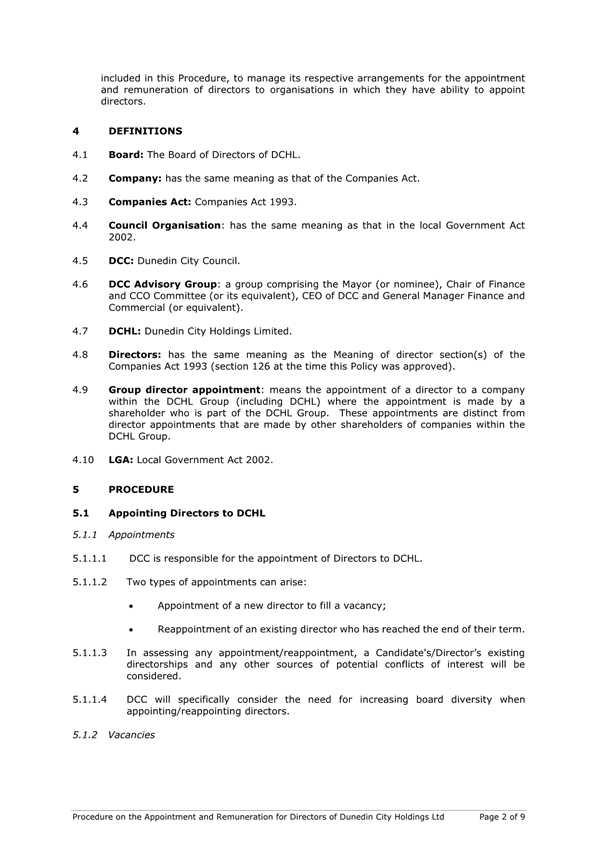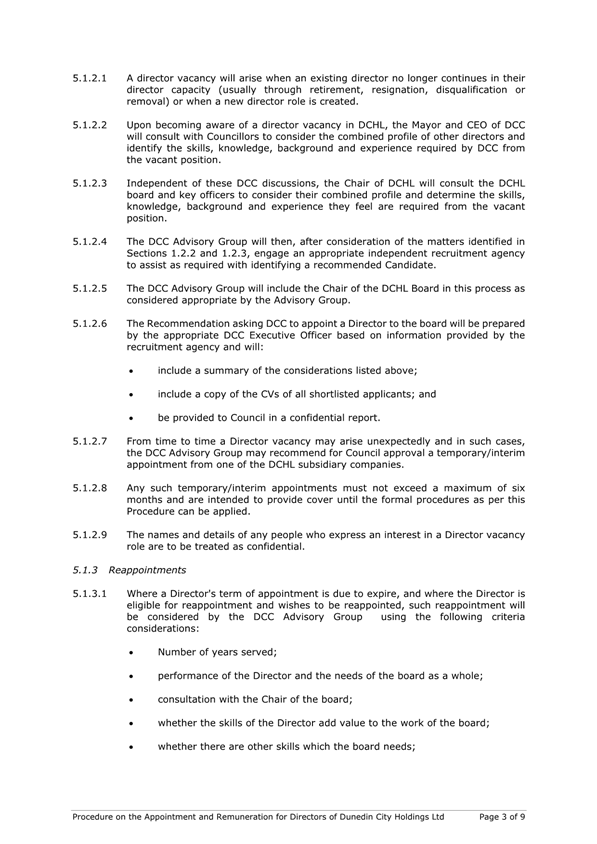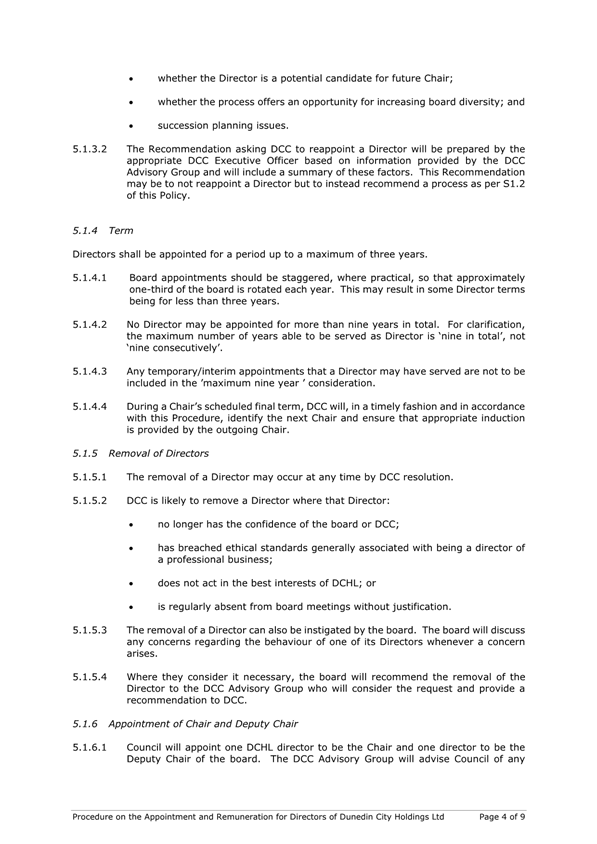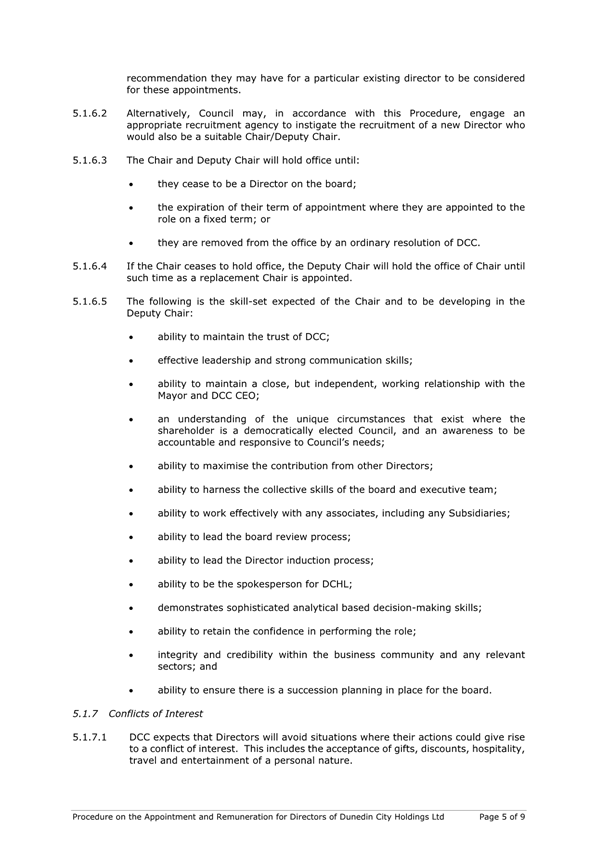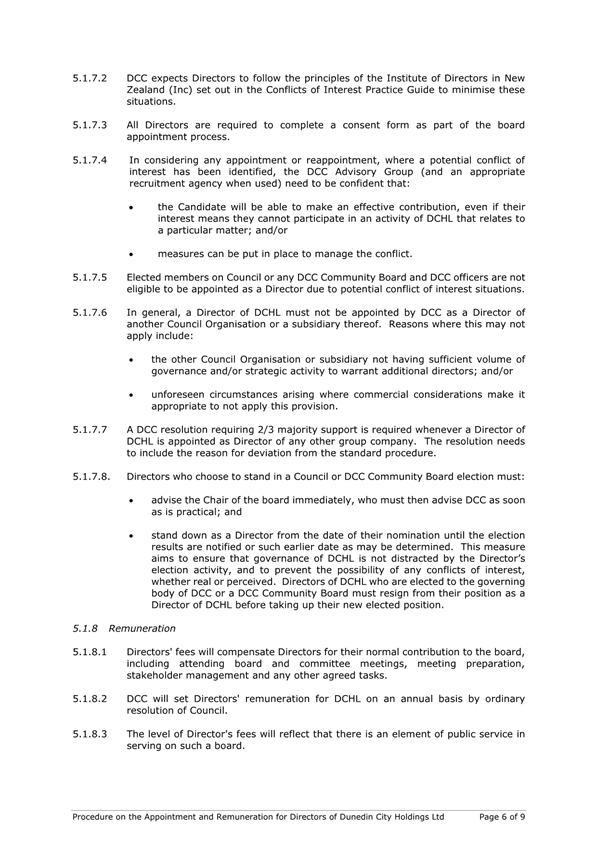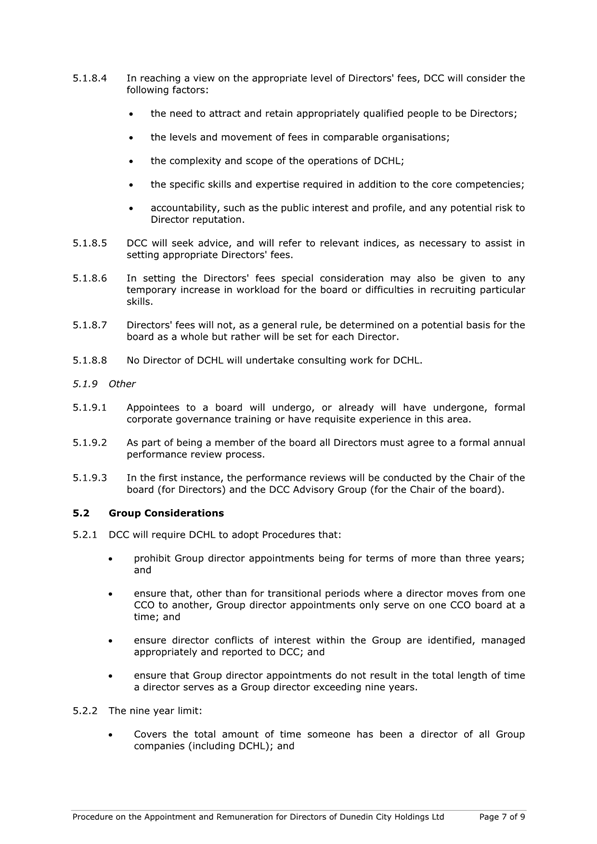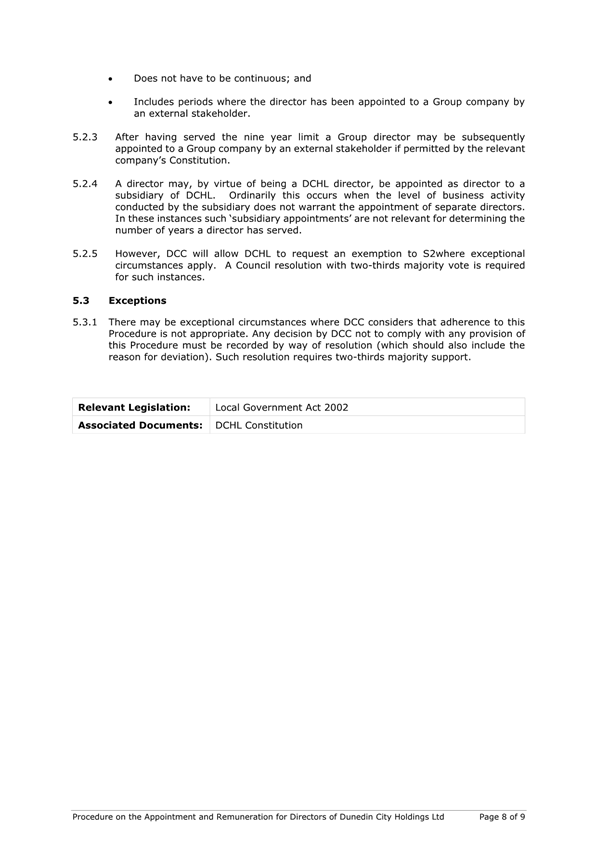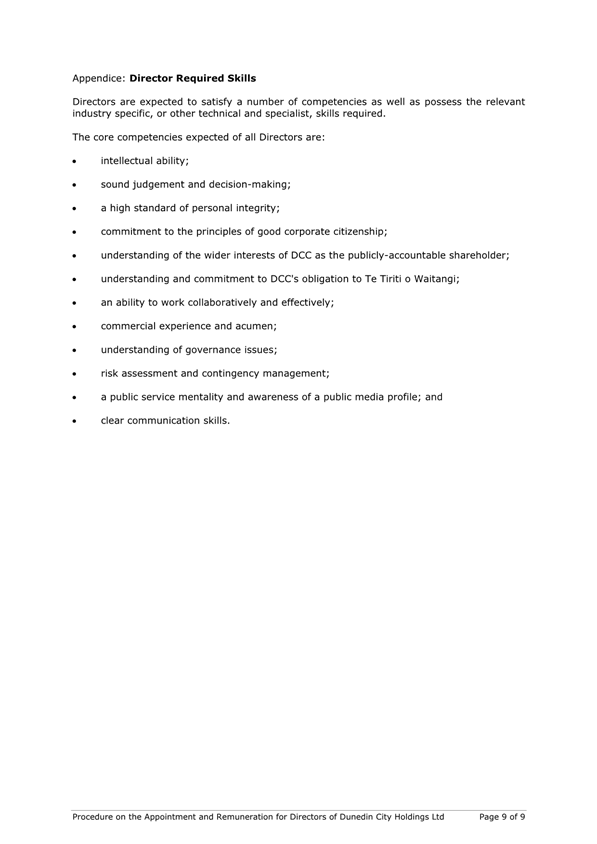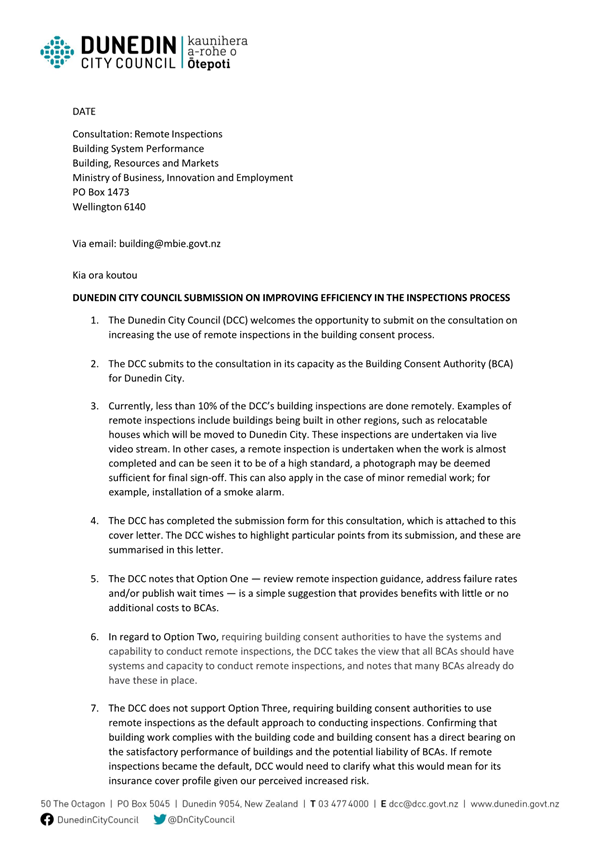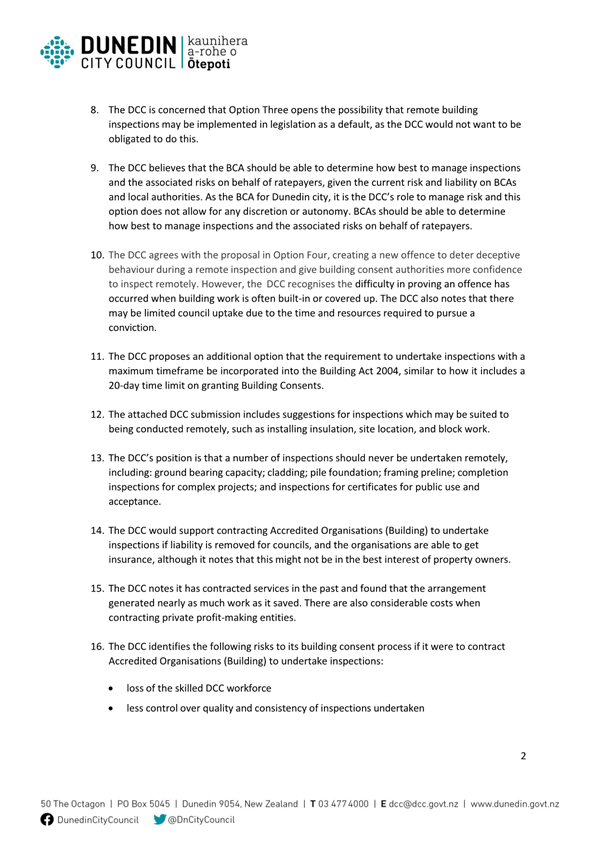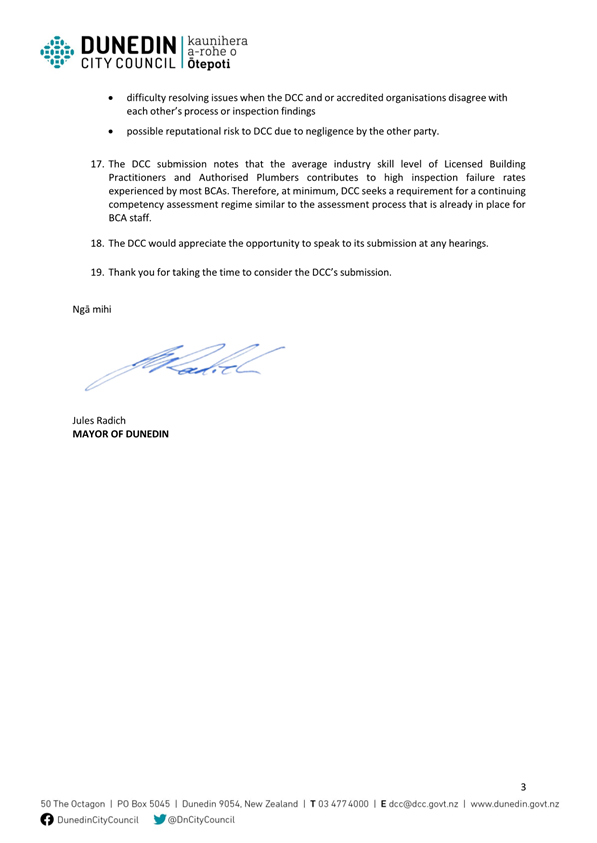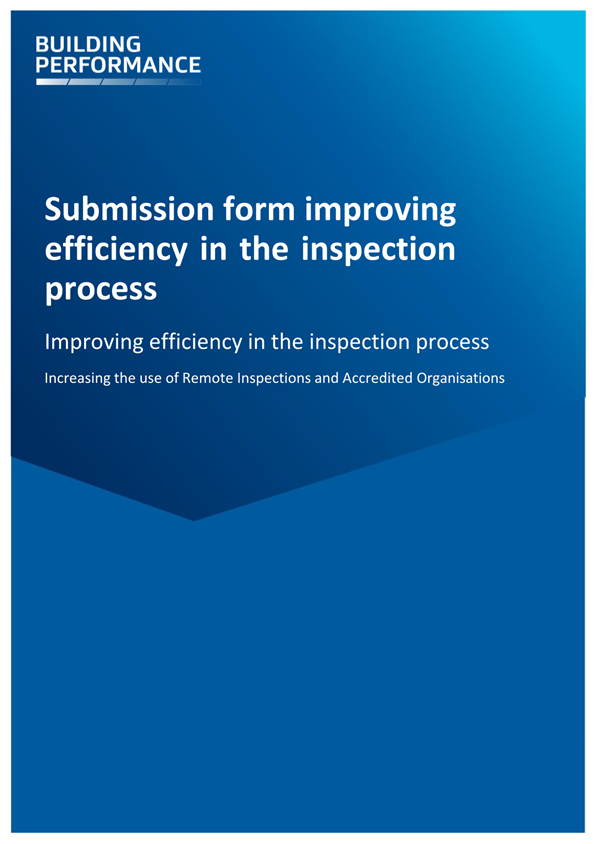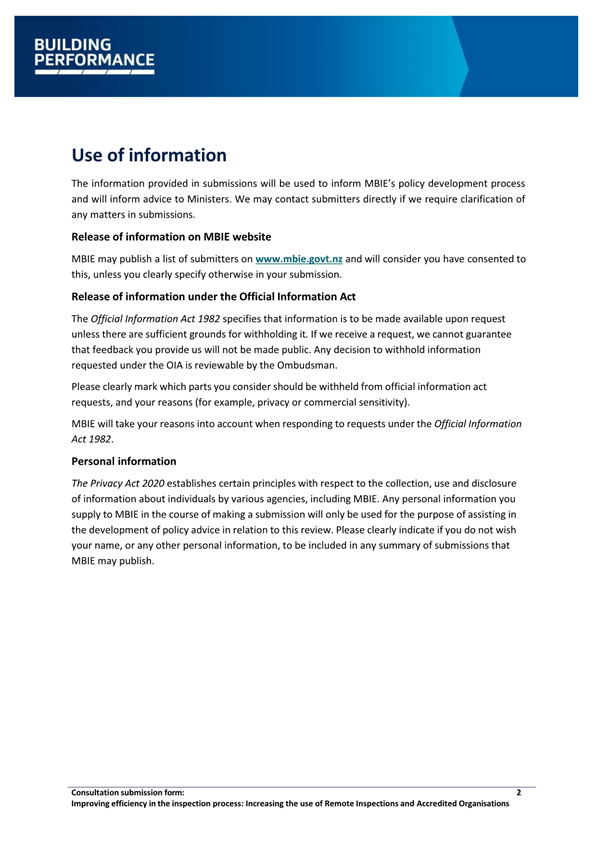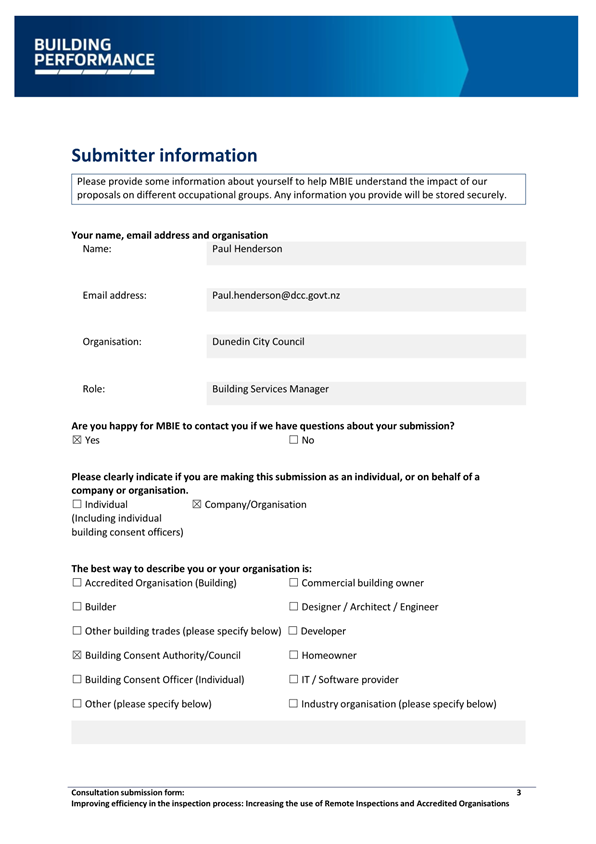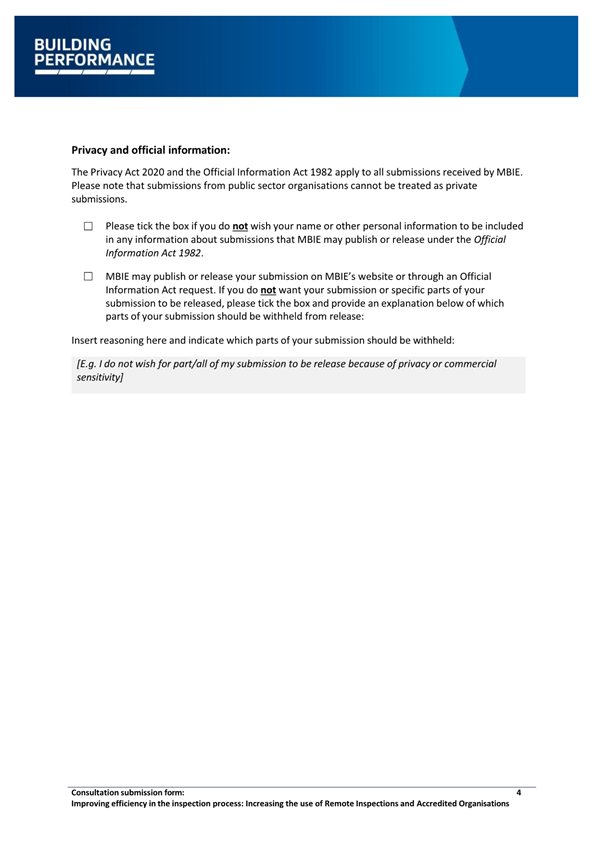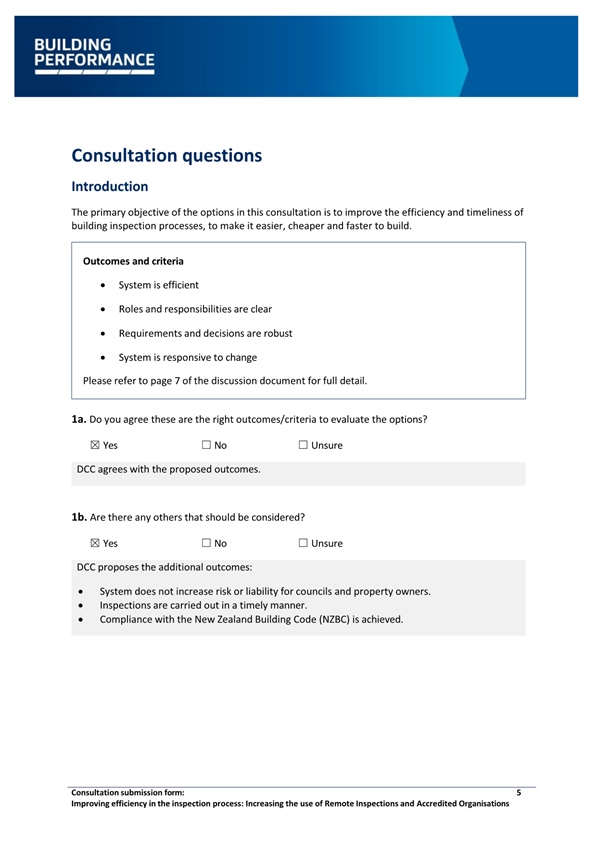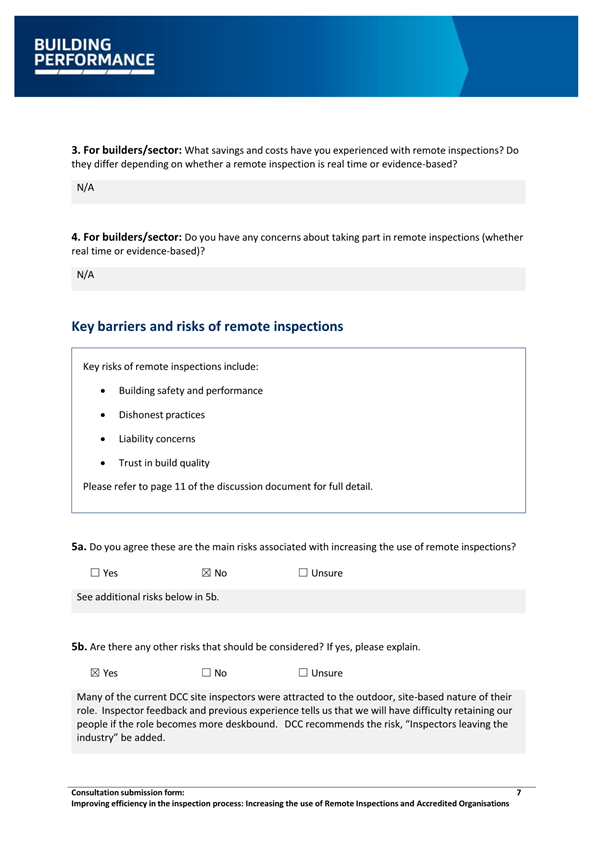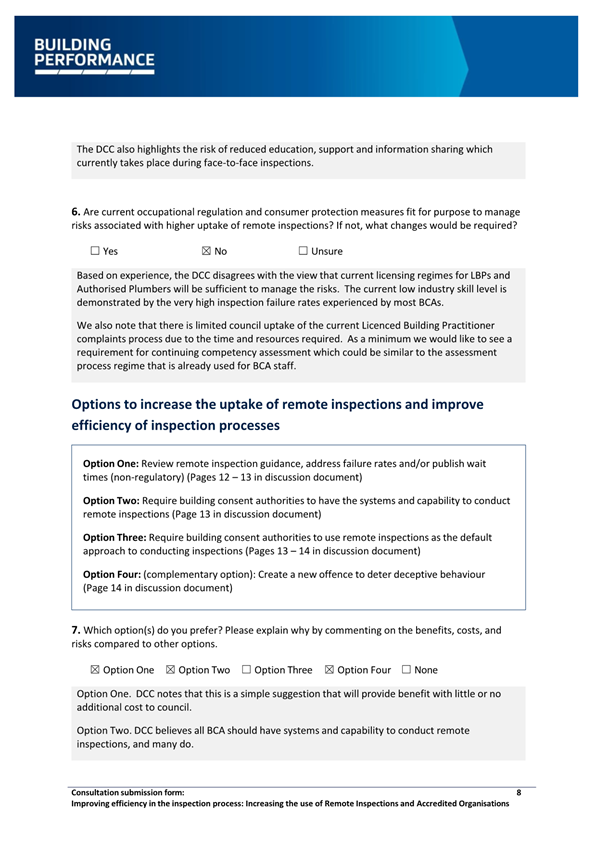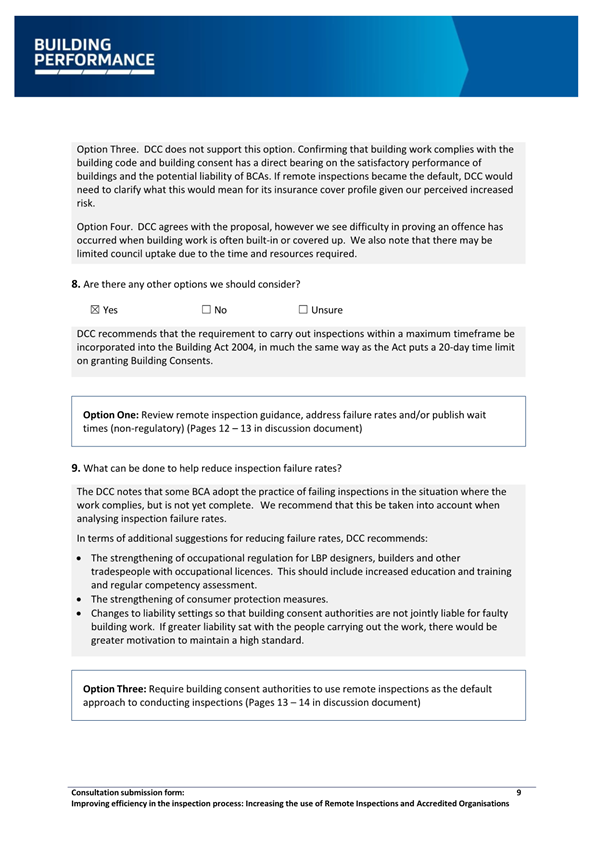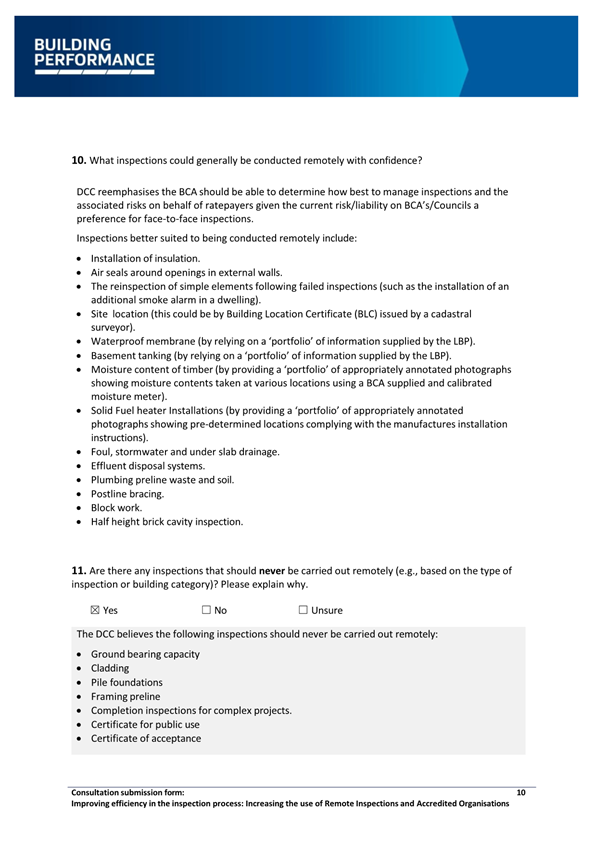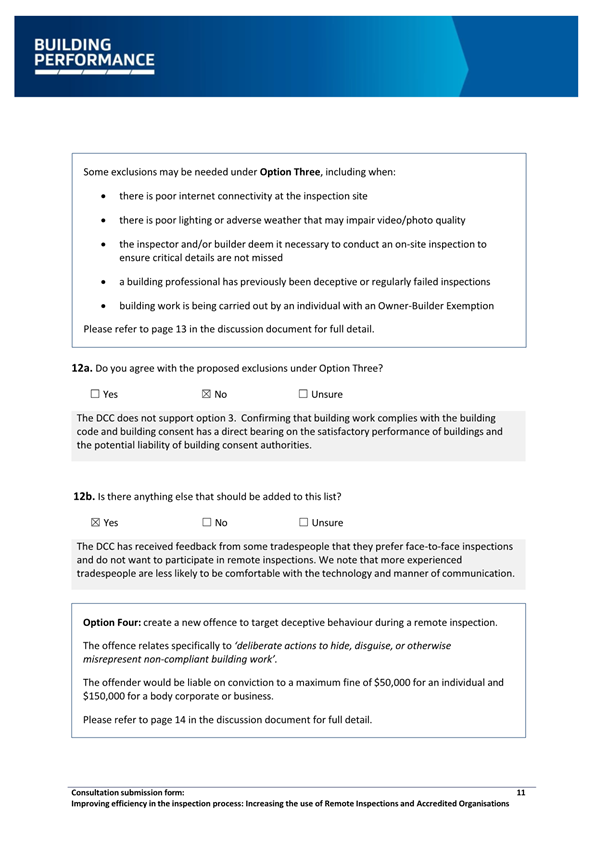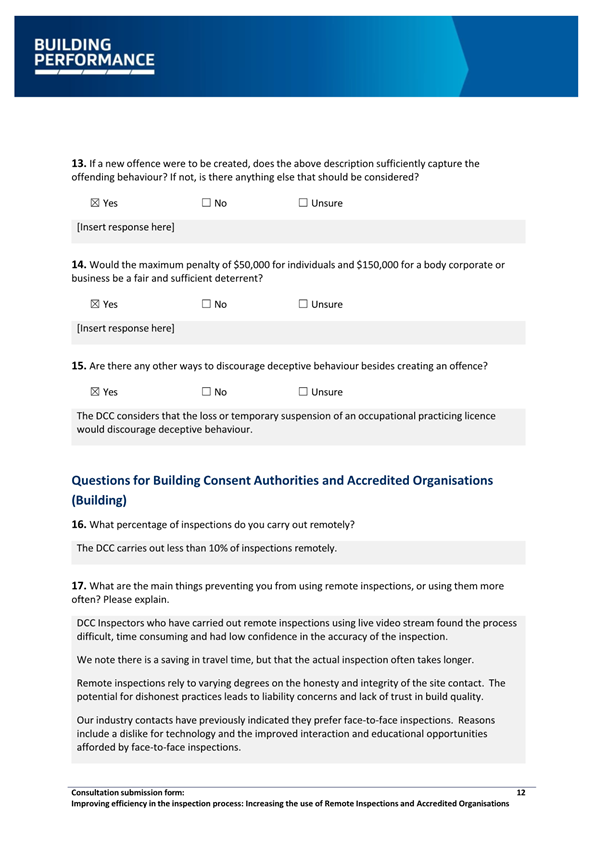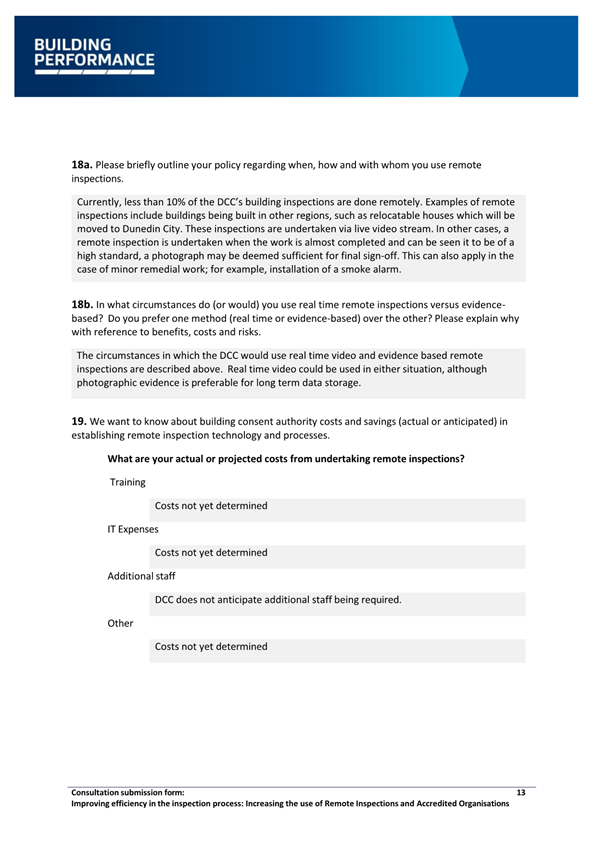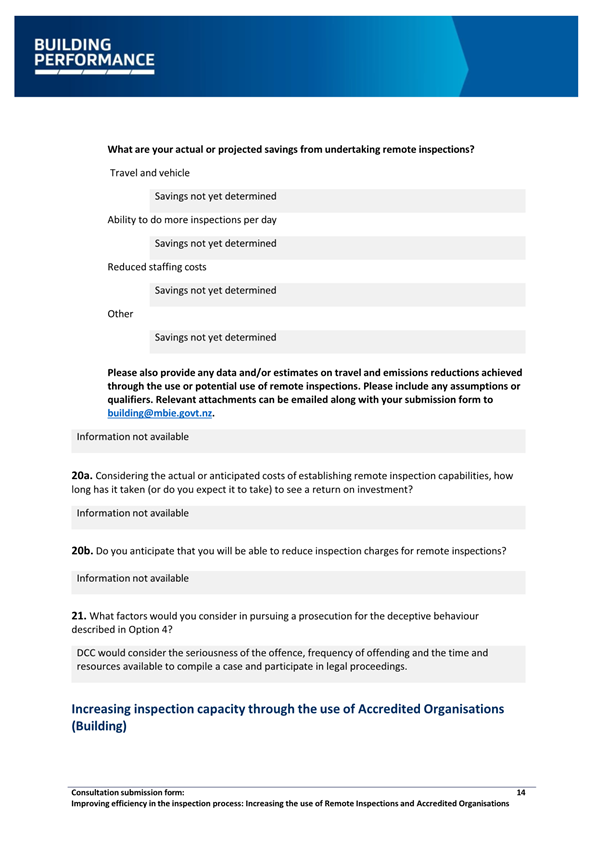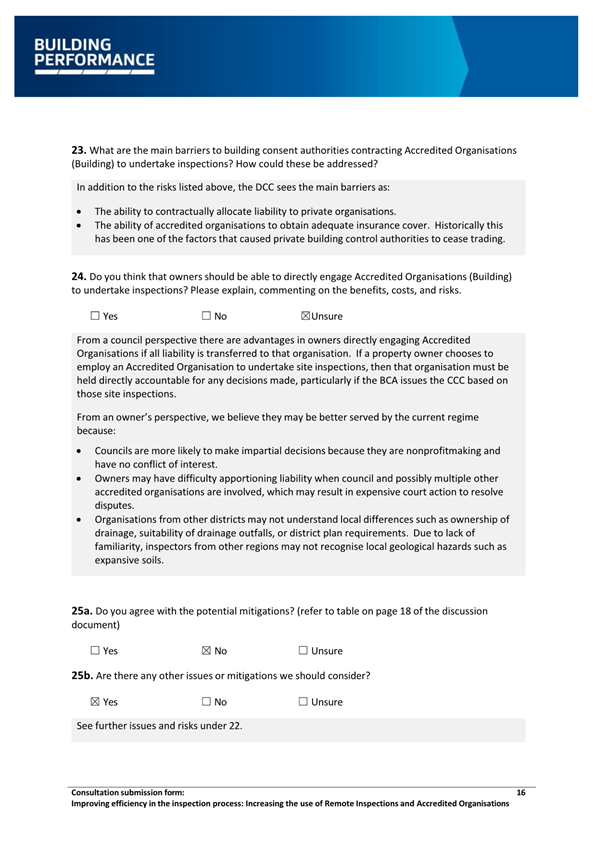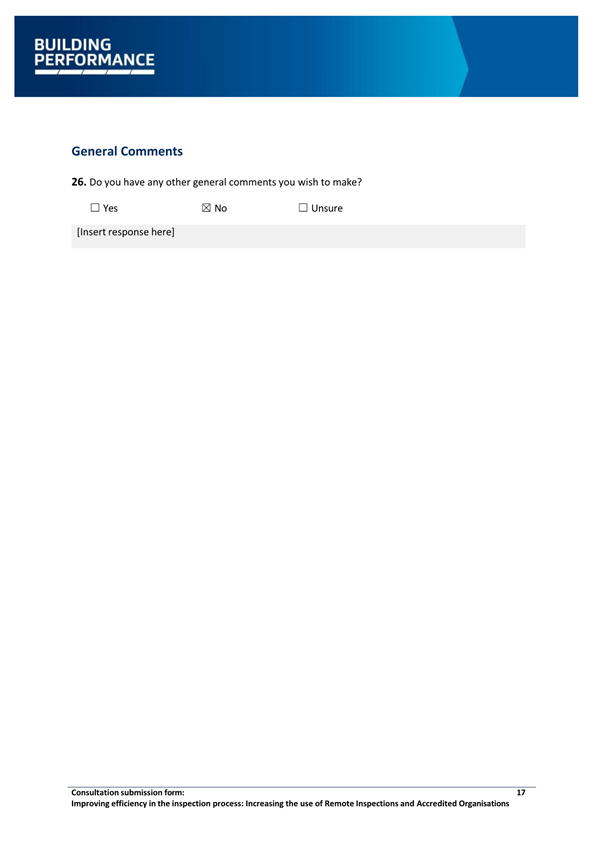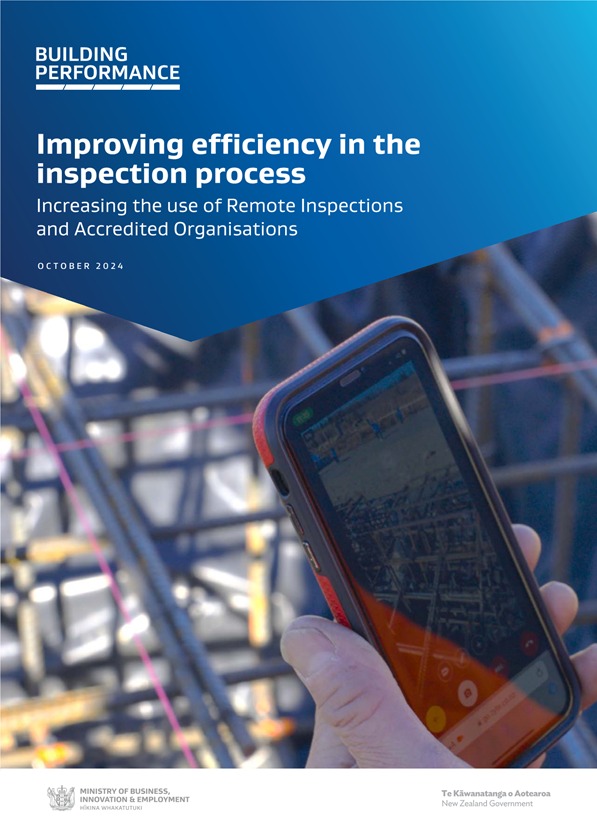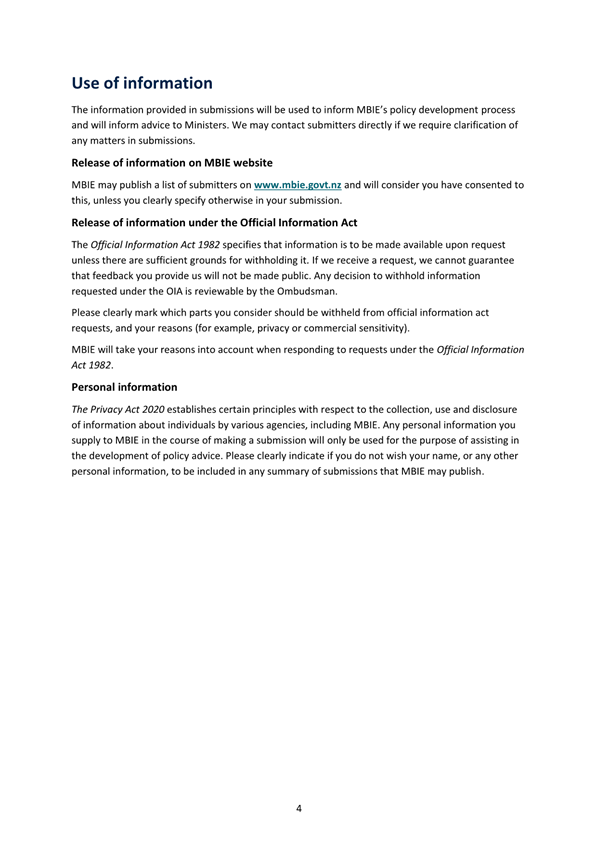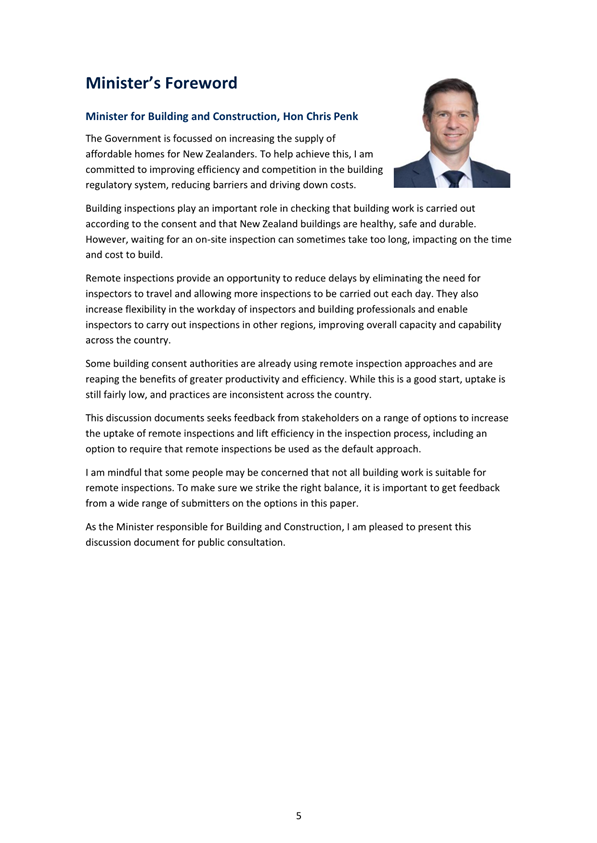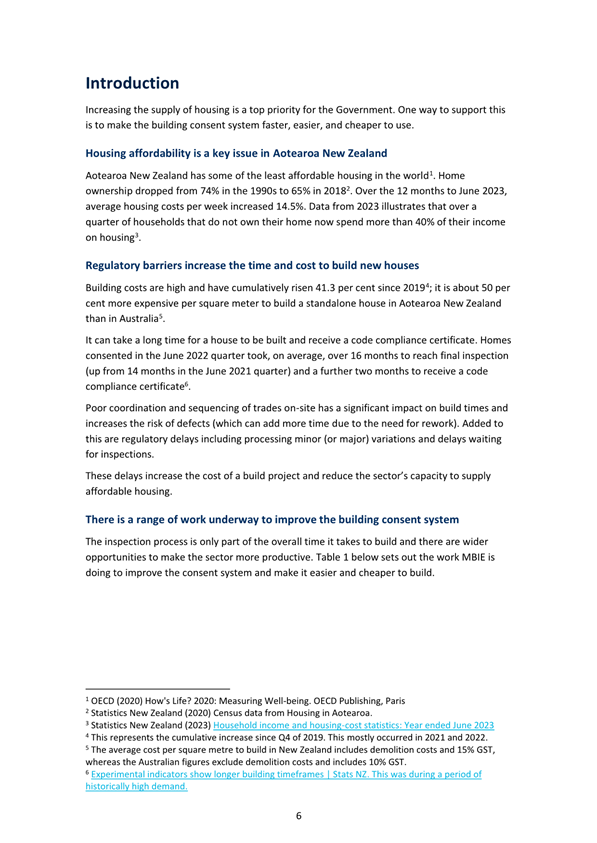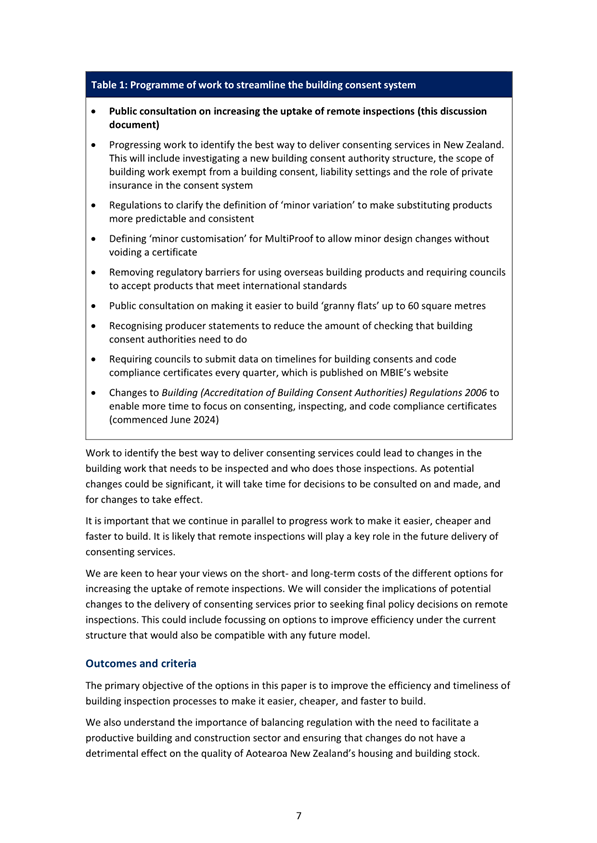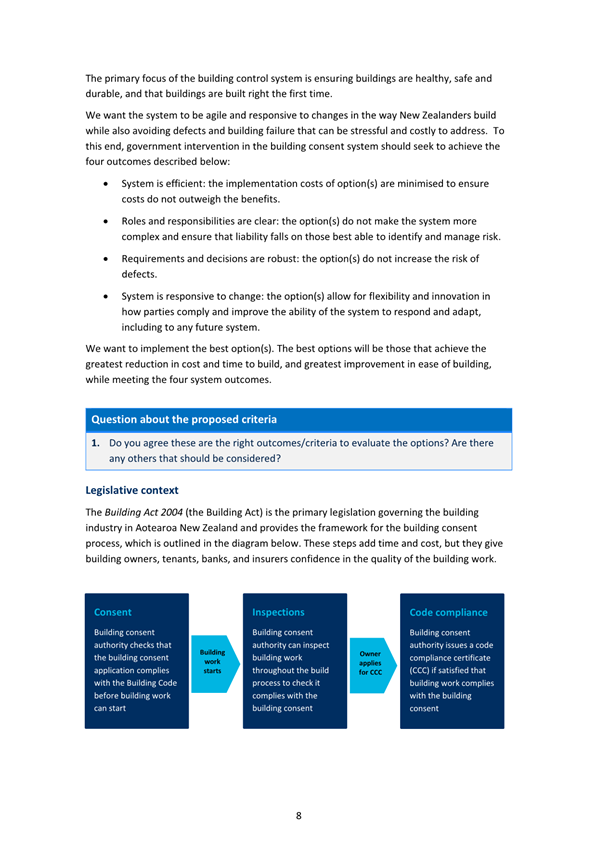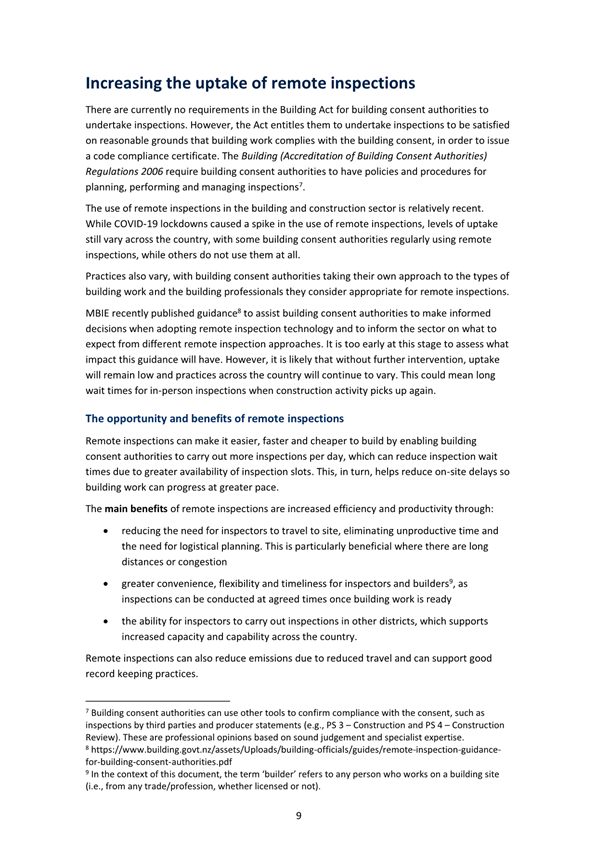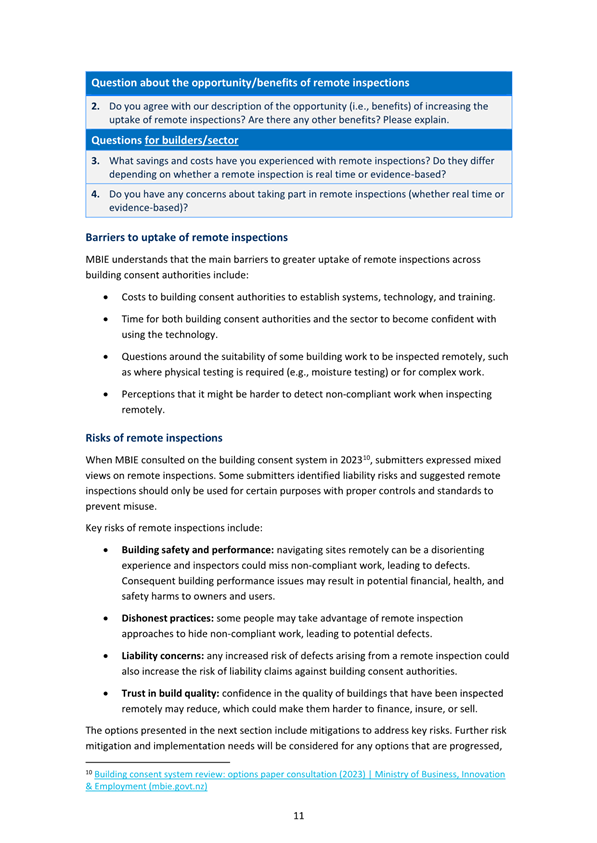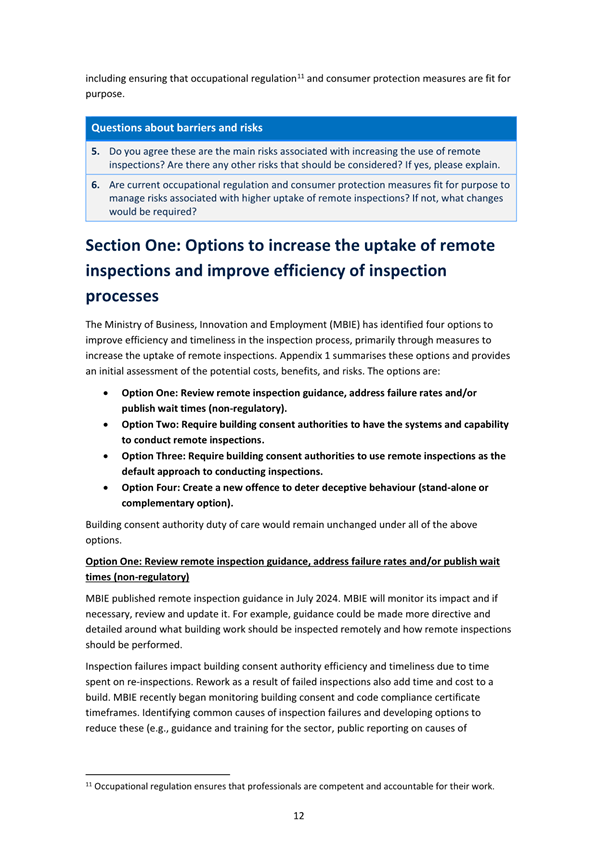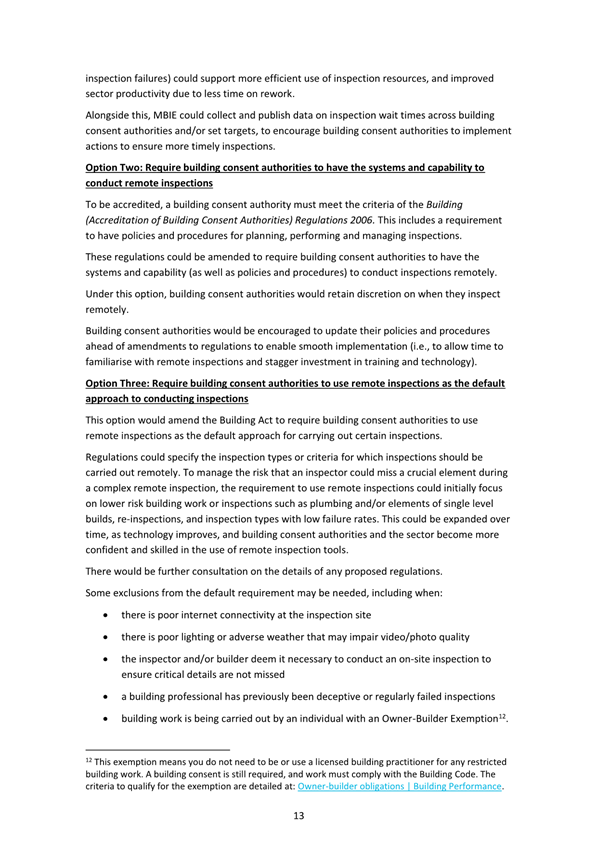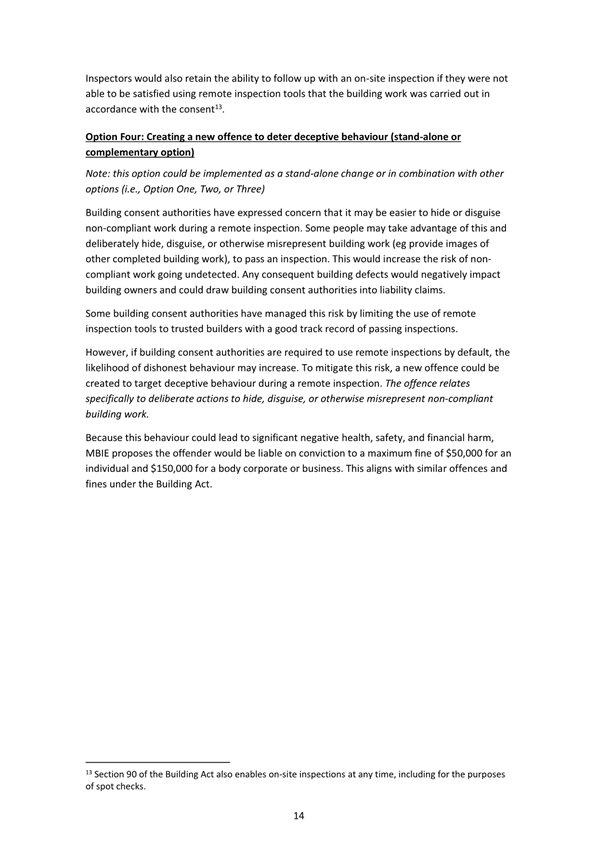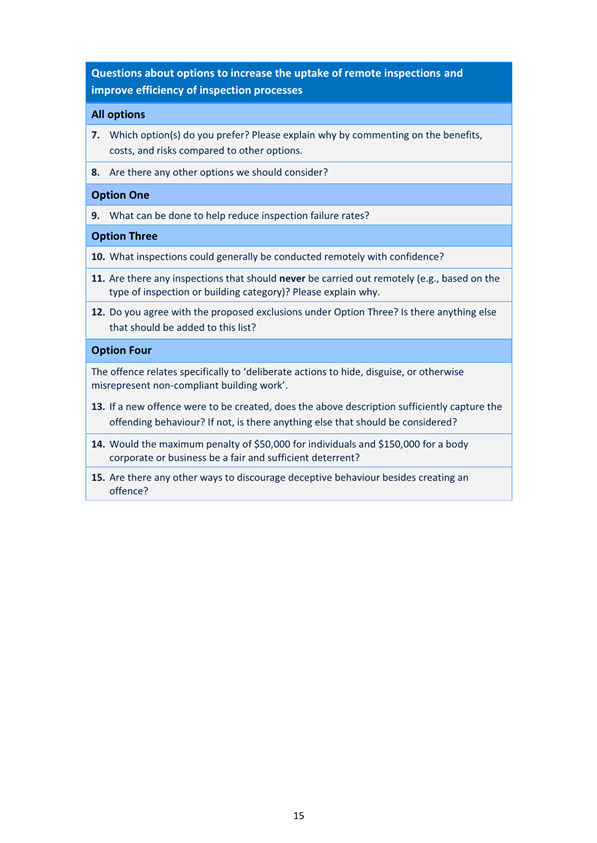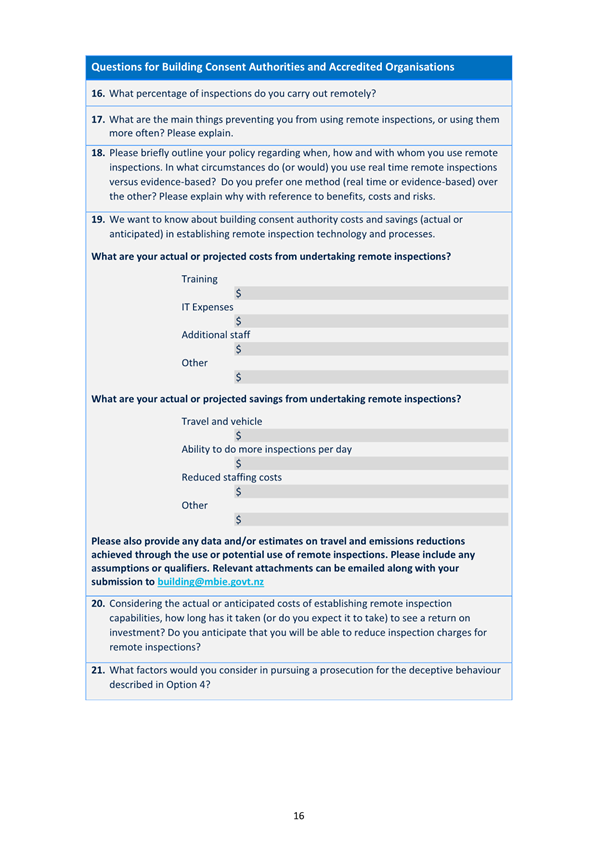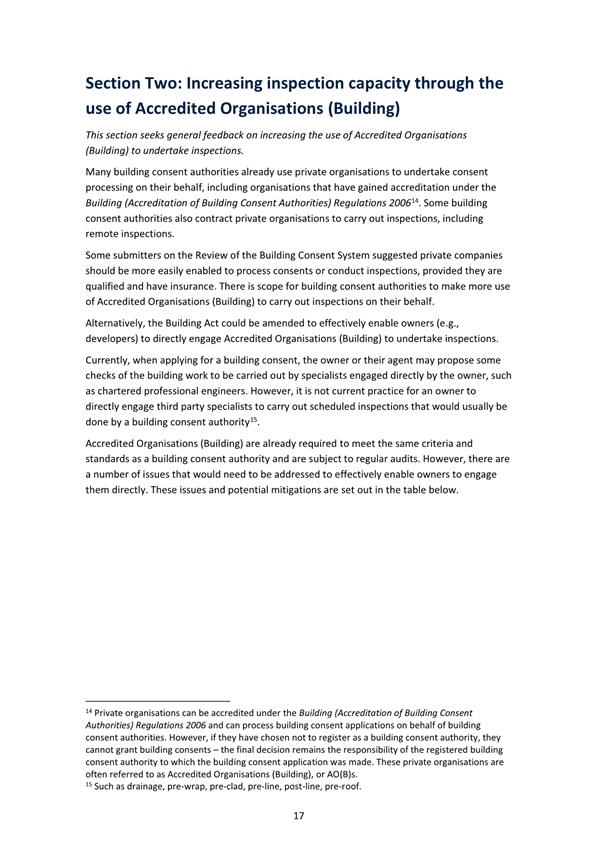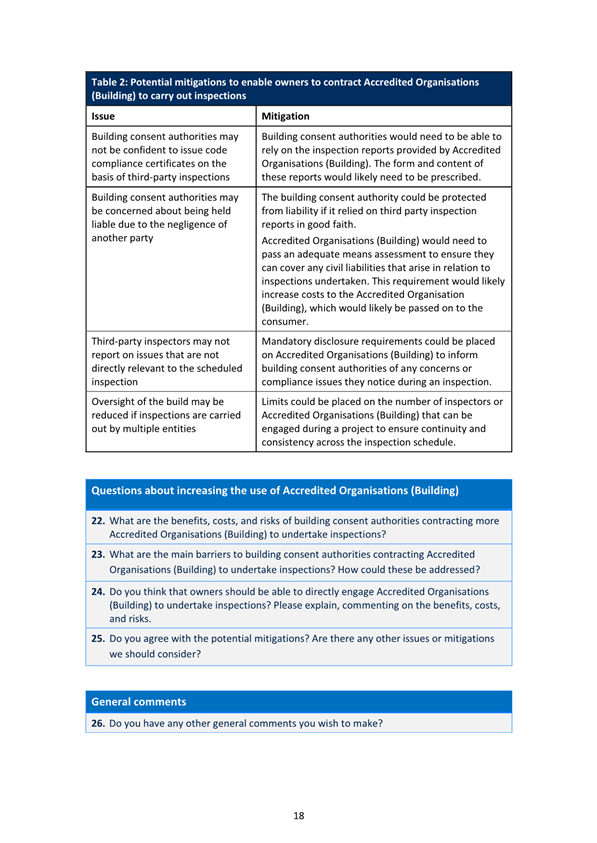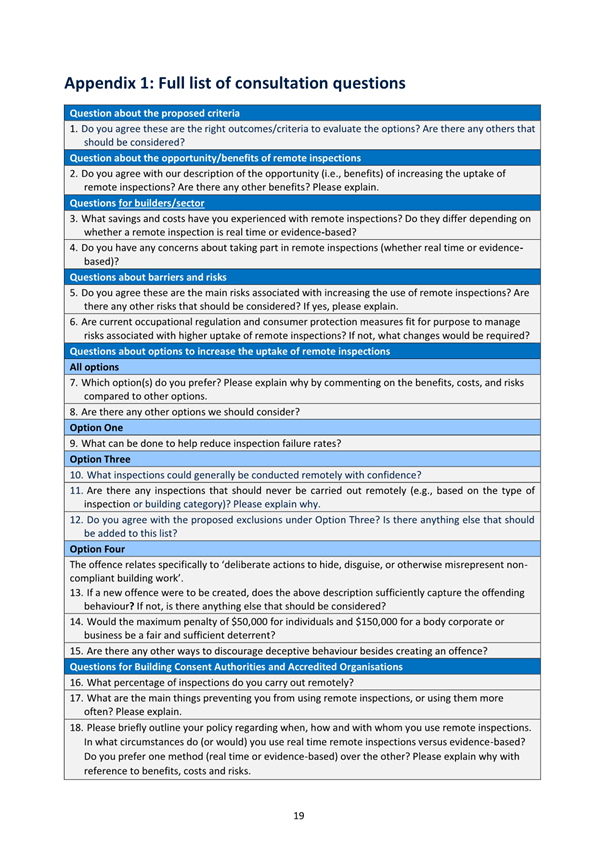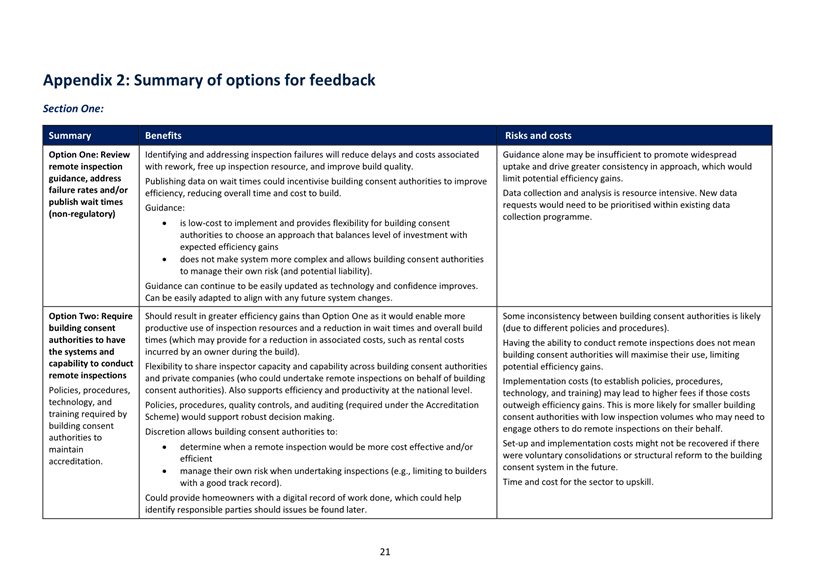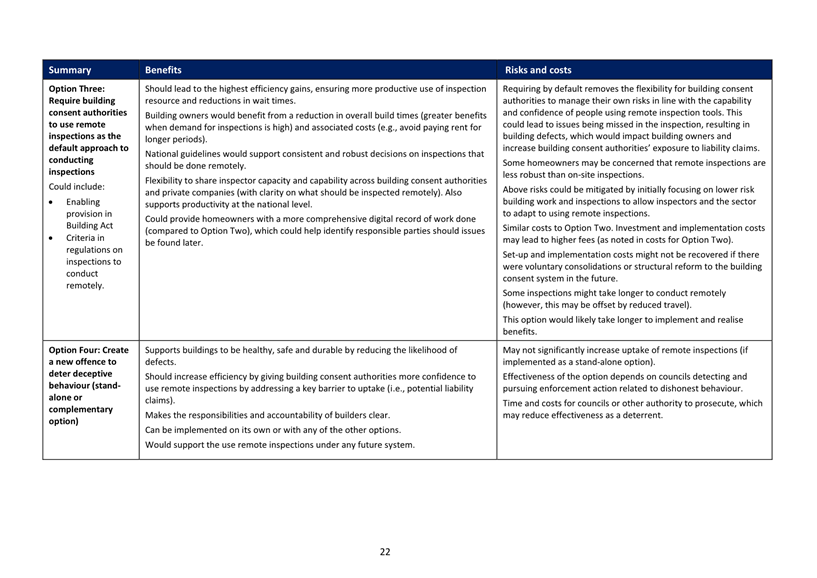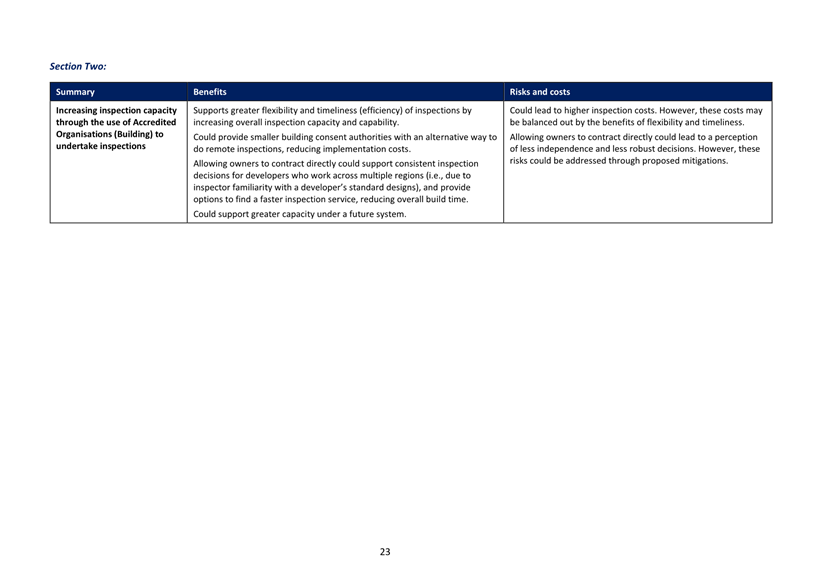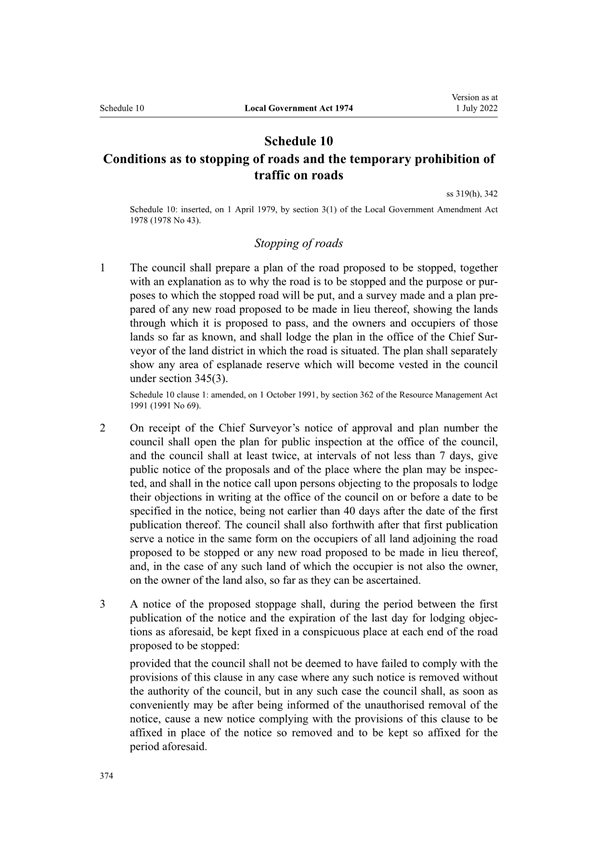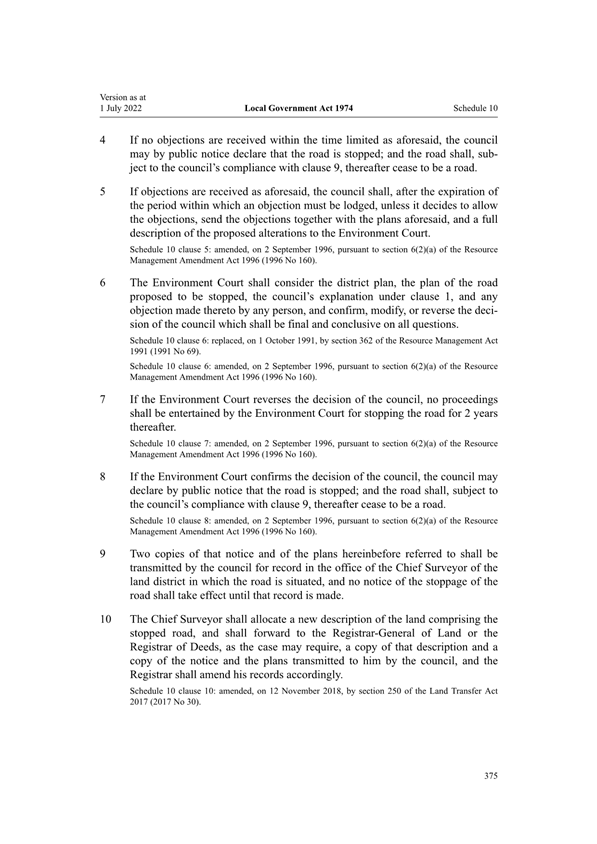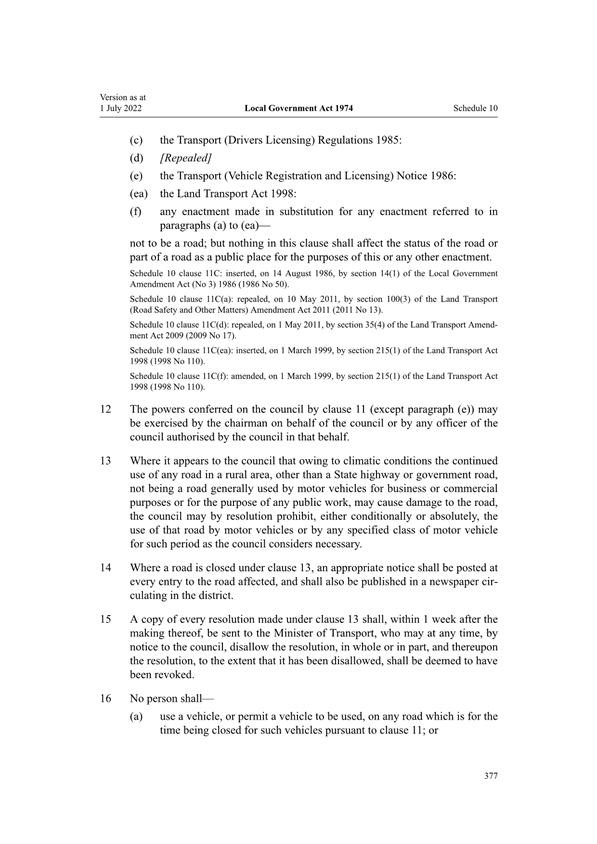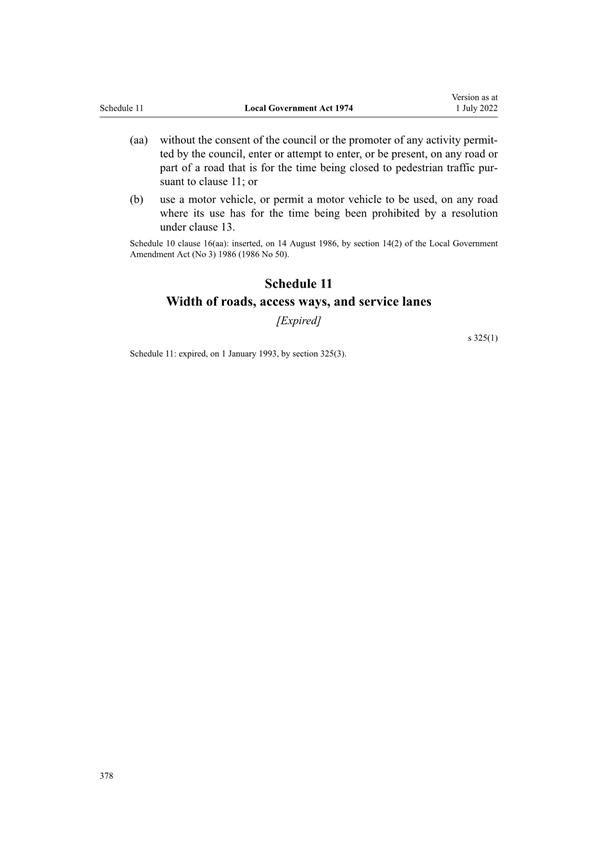
Notice of Meeting:
I hereby give notice that an ordinary meeting of the Dunedin
City Council will be held on:
Date: Monday
25 November 2024
Time: 9.00
am
Venue: Council
Chamber, Dunedin Public Art Gallery, The Octagon, Dunedin
Sandy Graham
Council
PUBLIC AGENDA
|
Mayor
|
Mayor Jules Radich
|
|
|
Deputy Mayor
|
Cr Cherry Lucas
|
|
|
Members
|
Cr Bill Acklin
|
Cr Sophie Barker
|
|
|
Cr David Benson-Pope
|
Cr Christine Garey
|
|
|
Cr Kevin Gilbert
|
Cr Carmen Houlahan
|
|
|
Cr Marie Laufiso
|
Cr Mandy Mayhem
|
|
|
Cr Jim O'Malley
|
Cr Lee Vandervis
|
|
|
Cr Steve Walker
|
Cr Brent Weatherall
|
|
|
Cr Andrew Whiley
|
|
Senior Officer Sandy
Graham, Chief Executive Officer
Governance Support Officer Lynne
Adamson
Lynne Adamson
Governance Support Officer
Telephone: 03 477 4000
governance.support@dcc.govt.nz
www.dunedin.govt.nz
Note: Reports
and recommendations contained in this agenda are not to be considered as
Council policy until adopted.
|

|
Council
25 November 2024
|
ITEM TABLE OF CONTENTS PAGE
1 Opening 4
2 Public
Forum 4
3 Apologies 4
4 Confirmation
of Agenda 4
5 Declaration
of Interest 5
6 Confirmation
of Minutes 16
6.1 Ordinary Council
meeting - 30 October 2024 16
Reports
7 Otepoti
Dunedin Housing Plan Update Report 36
8 231
Stuart Street Public Consultation 48
9 Funding
for Hospital Campaign 57
10 Heritage
Action Plan: Advisory Panel draft Terms of Reference 62
11 Strategic
Walking and cycling review 72
12 Hearings
Committee Recommendations on Dog Control Bylaw and Policy Review 81
13 Update
on the Parking Management work stream as part of the Shaping Future Dunedin
Transport programme 89
14 Climate
change significant forecasting assumptions - 9 year plan 2025-34 168
15 District
Licensing Committee's Annual Report to the Alcohol Regulatory and Licensing
Authority 189
16 DCC
Appeal on the Otago Regional Council Representation Review 200
17 Director
Vacancy in Dunedin City Holdings Limited 231
18 Appointment
of additional member to the Hearings Committee 244
19 Submission
on Improving Efficiency in the Inspections Process 245
20 Proposed
Event Road Closures 297
21 Local
Water Done Well - Decision on Model Shortlist for Water Services Delivery Plan 311
Resolution to Exclude the Public 336
|

|
Council
25 November 2024
|
Declaration of Interest
EXECUTIVE SUMMARY
1. Members
are reminded of the need to stand aside from decision-making when a conflict
arises between their role as an elected representative and any private or other
external interest they might have.
2. Elected
members are reminded to update their register of interests as
soon as practicable, including amending the register at this meeting if
necessary.
3. Staff are
reminded to update their register of interests as soon as practicable.
RECOMMENDATIONS
That the Council:
a) Notes/Amends if
necessary the Elected Members' Interest Register attached as Attachment A; and
b) Confirms/Amends the
proposed management plan for Elected Members' Interests.
c) Notes the proposed
management plan for the Executive Leadership Team’s Interests.
Attachments
|
|
Title
|
Page
|
|
⇩a
|
Councillor Interest
Register
|
6
|
|
⇩b
|
ELT Interest Register
|
14
|
|

|
Council
25 November 2024
|
Confirmation
of Minutes
Ordinary
Council meeting - 30 October 2024
RECOMMENDATIONS
That the Council:
a) Confirms the public
part of the minutes of the Ordinary Council meeting held on 30 October 2024 as
a correct record.
Attachments
|
|
Title
|
Page
|
|
A⇩
|
Minutes of Ordinary
Council meeting held on 30 October 2024
|
17
|
|

|
Council
25 November 2024
|

Council
MINUTES
Minutes of an ordinary
meeting of the Dunedin City Council held in the Council Chamber, Dunedin Public
Art Gallery, The Octagon, Dunedin on Wednesday 30 October 2024, commencing at
10.03 am
PRESENT
|
Mayor
|
Mayor Jules Radich
|
|
|
Deputy Mayor
|
Cr Cherry Lucas
|
|
|
Members
|
Cr Bill Acklin
|
Cr Sophie Barker
|
|
|
Cr David Benson-Pope
|
Cr Christine Garey
|
|
|
Cr Kevin Gilbert
|
Cr Carmen Houlahan
|
|
|
Cr Marie Laufiso
|
Cr Mandy Mayhem
|
|
|
Cr Jim O'Malley
|
Cr Lee Vandervis
|
|
|
Cr Steve Walker
|
Cr Brent Weatherall via
zoom audio visual link
|
|
|
Cr Andrew Whiley
|
|
IN ATTENDANCE
|
Sandy Graham (Chief Executive
Officer), Robert West (General Manager Corporate Services), Jeanette Wikaira
(General Manager Arts, Culture and Recreation), Carolyn Allan (Chief
Financial Officer), Scott MacLean (General Manager Climate and City Growth),
David Ward (General Manager 3 Waters and Transition), Paul Henderson (Acting
General Manager Customer and Regulatory), Chris Henderson (Group Manager
Waste and Environmental Solutions), Leigh McKenzie (Waste Minimisation
Officer), Jinty MacTavish (Principal Policy Advisor Sustainability), Heath
Ellis (Acting Group Manager Parks and Recreation), John Brenkley (Planning
and Partnerships Manager), Stephen Hogg (Parks and Recreation Planner), Owen
Graham (Senior Leasing and Land Advisor), Tim Loan (Chair, Dunedin City
Holdings Limited), Peter Hocking (General Manager, Dunedin City Holdings
Limited) Clare Sullivan (Manager Governance)
|
Governance Support Officer Lynne
Adamson
1 acknowledgement
Deputy Mayor Lucas acknowledged
the recent passing of Dame Elizabeth Hanan (ex Deputy Mayor and Councillor) and
acknowledged her many achievements. Cr David Benson-Pope also provided a
tribute to Dame Hanan.
Council
held a moments silence in recognition of Dame Elizabeth Hanan.
Opening
Poutama
Crossman-Nixon opened the meeting with a prayer on behalf of the Hare Krishna
group.
2 Public
Forum
2.1 Tony
Cumming and Lyndon Weggery, Dunedin Area Citizens Association spoke to their circulated
information on the newly finished children’s play equipment at the
Botanic Gardens.
Mr
Cumming responded to questions.
2.2 Juliet
Walker spoke on concerns with the health of the Kākā - Charlie Girl following
her relocation from Te Anau to the aviaries at the Dunedin Botanic
Gardens.
Cr Carmen Houlahan entered the
meeting at 10.21 am.
Ms
Walker responded to questions.
|
3 Apologies
|
|
|
Moved (Cr Cherry Lucas/Cr Steve Walker):
That the Council:
Accepts the apology for
lateness from Mayor Jules Radich.
Motion
carried (CNL/2024/186)
|
|
4 Confirmation
of agenda
|
|
|
Moved (Cr Cherry Lucas/Cr Mandy Mayhem):
That the Council:
Confirms the agenda with
the following alteration:
That Item 10 – be taken as
the last agenda item and 19 – Funding for Hospital Campaign be taken
before Item 17 – Meeting Schedule for 2025.
Motion
carried (CNL/2024/187)
|
5 Declarations
of interest
Members were
reminded of the need to stand aside from decision-making when a conflict arose
between their role as an elected representative and any private or other
external interest they might have.
|
|
Moved (Cr Cherry Lucas/Cr Kevin Gilbert):
That the Council:
a) Notes the Elected Members' Interest Register; and
b) Confirms the proposed management plan for
Elected Members' Interests; and
c) Notes the proposed management plan for the Executive
Leadership Team’s Interests.
Motion
carried (CNL/2024/188)
|
6 Confirmation
of Minutes
|
6.1 Ordinary
Council meeting - 24 September 2024
|
|
|
Moved (Cr Cherry Lucas/Cr Kevin Gilbert):
That the Council:
a) Confirms the public part of the minutes of the
Ordinary Council meeting held on 24 September 2024 as a correct record.
Motion
carried (CNL/2024/189)
|
Reports
|
7 Actions
From Resolutions of Council Meetings
|
|
|
A report from Civic provided
is to show progress on the implementations of resolutions made at Council
meetings.
|
|
|
Moved (Cr Cherry Lucas/Cr Jim O'Malley):
That the Council:
a) Notes
the Open and Completed Actions from resolutions of Council meetings.
Motion
carried (CNL/2024/190)
|
|
8 Forward
Work Programme for Council - October 2024
|
|
|
A report from Civic provided
the updated forward work programme for the 2024-2025 year.
|
|
|
The Chief Executive Officer (Sandy Graham) spoke to the
report and responded to questions.
|
|
|
Moved (Cr Cherry Lucas/Cr Kevin Gilbert):
That the Council:
a) Notes the updated Council forward work programme.
Motion
carried (CNL/2024/191)
|
|
9 9
Year Plan Forward Work Programme - October 2024
|
|
|
A report from Civic provided
an update on the forward work programme for the development of the 9 year
plan.
|
|
|
The Chief Executive Officer (Sandy Graham) responded to
questions.
|
|
|
Moved (Cr Cherry Lucas/Cr Mandy Mayhem):
That the Council:
a) Notes the updated Council forward work programme.
Motion
carried (CNL/2024/192)
|
Cr Christine Garey left the meeting at 10.33 am and returned
at 10.36 am.
|
11 Waste
Management and Minimisation Plan Review
|
|
|
A report from Waste and
Environmental Solutions sought approval to publicly consult on the proposed
draft Waste Management and Minimisation Plan 2025 in accordance with section
44 of the Waste Minimisation Act 2008.
|
|
|
The General Manager, Climate and City Growth (Scott MacLean);
Group Manager Waste and Environmental Solutions (Chris Henderson) and Waste
Minimisation Officer (Leigh McKenzie) spoke to the report and responded to
questions.
|
|
Mayor Jules Radich entered the meeting at 11.08 am and
assumed the Chair.
|
|
|
Moved (Cr Jim O'Malley/Cr Kevin Gilbert):
That the Council:
a) Approves the proposed draft Waste Management and
Minimisation Plan 2025 for public consultation, following a Special
Consultation Procedure.
b) Approves: The proposed draft Waste Management and
Minimisation Plan 2025 to be publicly consulted on alongside the 9 Year Plan.
c) Authorises the Chief Executive to make any minor
editorial changes to the draft Waste Management and Minimisation Plan 2025
and associated consultation documents.
d) Decides:
i) To
publicly consult on the proposed draft Waste Management and Minimisation Plan
2025.
ii) To
appoint members to a hearings panel for the public consultation.
iii) If
any further amendments should be made before the draft WMMP 2025 is presented
for public consultation.
e) Notes the Summary of Information, Summary of Engagement,
Statement of Proposal, Consultation Method, the submission feedback form, and
drop-in schedule which are attached to this report, and will be used as part
of the public consultation. The Otago Regional Waste Assessment 2023 will be
notified with the Statement of Proposal.
Division
The
Council voted by division
For: Crs
Bill Acklin, Sophie Barker, David Benson-Pope, Christine Garey, Kevin
Gilbert, Carmen Houlahan, Marie Laufiso, Cherry Lucas, Mandy Mayhem, Jim
O'Malley, Steve Walker, Brent Weatherall, Andrew Whiley and Mayor Jules
Radich (14).
Against: Cr
Lee Vandervis (1).
Abstained: Nil
The division was declared CARRIED by 14 votes to 1
Motion
carried (CNL/2024/193)
|
|
12 Updated
2024/25 Zero Carbon Implementation Plan
|
|
|
A report from the
Sustainability Group provided the updated draft 2024/25 Zero Carbon
Implementation Plan.
|
|
|
The General Manager, Climate and City Growth (Scott
MacLean) and Principal Policy Advisor Sustainability (Jinty MacTavish) spoke
to the report and responded to questions.
|
|
Cr Carmen Houlahan left the meeting at 11.18 am and
returned at 11.22 am.
Cr David Benson-Pope left the meeting at 11.50 am and
returned at 11.55 am.
|
|
|
Moved (Cr Mandy Mayhem/Cr Sophie Barker):
That the Council:
a) Notes the 2024/25 Zero Carbon Implementation Plan.
Division
The Council voted by division
For: Crs
Sophie Barker, David Benson-Pope, Christine Garey, Kevin Gilbert, Carmen
Houlahan, Marie Laufiso, Cherry Lucas, Mandy Mayhem, Jim O'Malley, Steve
Walker, Brent Weatherall, Andrew Whiley and Mayor Jules Radich (13).
Against: Crs
Bill Acklin and Lee Vandervis (2).
Abstained: Nil
The division
was declared CARRIED by 13 votes to 2
Motion
carried (CNL/2024/194)
|
|
11a ALTERATION
of Resolution - Waste Management and Minimisation Plan Review
|
|
|
It was noted that Resolution d) of the Waste Management
and Minimisation Plan Review needed to be revoked pursuant to SO 23.5 which
allows the revocation of a resolution at the same meeting with a 75% majority
as Council decided the relevant matters in resolutions a), b) and c).
|
|
|
Moved (Cr Jim O'Malley/Mayor Jules Radich):
That the Council:
Revokes
the following resolution
d) Decides
i) to
publicly consult on the proposed draft Waste Management and Minimisation Plan
2025.
ii) to appoint members
to a hearings panel for the public consultation.
iii) If any
further amendments should be made before the draft WMMP
2025
is presented for public consultation.
Motion
carried (CNL/2024/195) this met the 75% standing order rule.
|
|
|
The following is a record of the final decision following
the revocation.
|
|
|
Moved (Cr Jim O'Malley/Cr Kevin Gilbert):
That the Council:
a) Approves the proposed draft Waste Management and
Minimisation Plan 2025 for public consultation, following a Special
Consultation Procedure.
b) Approves: The proposed draft Waste Management and
Minimisation Plan 2025 to be publicly consulted on alongside the 9 Year Plan.
c) Authorises the Chief Executive to make any minor
editorial changes to the draft Waste Management and Minimisation Plan 2025
and associated consultation documents.
d) Notes the Summary of Information, Summary of Engagement,
Statement of Proposal, Consultation Method, the submission feedback form, and
drop-in schedule which are attached to this report, and will be used as part
of the public consultation. The Otago Regional Waste Assessment 2023 will be
notified with the Statement of Proposal.
Division
The Council voted by division
For: Crs
Bill Acklin, Sophie Barker, David Benson-Pope, Christine Garey, Kevin
Gilbert, Carmen Houlahan, Marie Laufiso, Cherry Lucas, Mandy Mayhem, Jim
O'Malley, Steve Walker, Brent Weatherall, Andrew Whiley and Mayor Jules
Radich (14).
Against: Cr
Lee Vandervis (1).
Abstained: Nil
The division
was declared CARRIED by 14 votes to 1
Motion carried (CNL/2024/196)
|
Moved (Mayor Jules Radich/Cr Mandy Mayhem):
That the Council:
Adjourns
the meeting until 1.15 pm.
Motion
carried
The meeting adjourned at 12.29 pm and reconvened at 1.14 pm.
|
15 Financial
Report - Period Ended 31 August 2024
|
|
|
A report
from Finance provided the financial results for the period ended 31 August
2024 and the financial position as at that date.
|
|
|
The Chief Financial Officer (Carolyn Allan) spoke to the
report then responded to questions with Executive Officer (Sandy Graham),
General Manager Corporate Services (Robert West) and General Manager Climate
and City Growth (Scott MacLean) and General Manager Arts, Culture and
Recreation (Jeanette Wikaira).
|
|
|
Moved (Mayor Jules Radich/Cr Cherry Lucas):
That the Council:
a) Notes the Financial Performance for the period ended 31
August 2024 and the Financial Position as at that date.
Motion
carried (CNL/2024/198)
|
|
4 Gift
of Land at Portobello from The Otago Peninsula Agricultural and Pastoral
Society
|
|
|
A
report from Parks and Recreation advised on the gifting of approximately
1.1735 hectares of land owned by The Otago Peninsula Agricultural and
Pastoral Society to the Council.
|
|
|
The General Manager Arts, Culture and Recreation (Jeanette
Wikaira); Acting Group Manager Parks and Recreation (Heath Ellis) and Senior
Leasing and Land Advisor (Owen Graham via zoom audio visual link) spoke to
the report and responded to questions.
|
|
|
Moved (Cr Bill Acklin/Cr Marie Laufiso):
That the Council:
a) Lay
the item on the table and to be uplifted the 26 November 2024 Council
meeting.
Motion
carried (CNL/2024/199)
|
|
16 2024
Annual Reports for the Dunedin City Holdings Ltd Group
|
|
|
A report From Finance
appended the 2024 Annual Reports of Dunedin City Holdings Ltd (DCHL) Group
companies.
|
|
|
The Chair, DCHL (Tim Loan) and General Manger DCHL (Peter
Hocking) spoke to the reports and responded to questions.
|
|
|
Moved (Cr Sophie Barker/Cr Lee Vandervis):
That the Council:
a) Notes the 2024 Annual Reports of:
- Dunedin City Holdings Limited
- Dunedin City Treasury Limited
- Aurora Energy Limited
- City Forests Limited
- Delta Utility services Limited
- Dunedin International Airport Limited
- Dunedin Railways Limited
- Dunedin Stadium Property Limited
- Dunedin Venues Management Limited
b) Refers the Group Annual Reports to the
6 November 2024 Finance and Council Controlled Organisations Committee
meeting for discussion.
Motion
carried (CNL/2024/200)
|
|
19 Funding
for Hospital Campaign
|
|
|
A report from
Communications and Marketing sought formal approval for funding for the Save
Our Southern Hospital Campaign.
The Chief Financial Officer (Carolyn Allan) and Acting
Communications Team Manager (Kathryn van Beek) spoke to the report and
responded to questions.
|
|
Cr Christine Garey left the meeting at 2.16 pm and
returned at 2.20 pm.
|
|
|
Moved (Cr Steve Walker/Cr Carmen
Houlahan):
That the Council:
a) Approves an authorised overspend of up to $146,099
($1.10 for every person in Dunedin) to fund the Save Our Southern Hospital
campaign.
b) Notes that revenue options will be explored to offset
costs.
Division
The Council voted by division
For: Crs
Bill Acklin, Sophie Barker, David Benson-Pope, Christine Garey, Kevin
Gilbert, Carmen Houlahan, Marie Laufiso, Cherry Lucas, Mandy Mayhem, Jim
O'Malley, Lee Vandervis, Steve Walker, Brent Weatherall, Andrew Whiley and
Mayor Jules Radich (15).
Against: Nil
Abstained: Nil
The division
was declared CARRIED by 15 votes to 0
Motion
carried (CNL/2024/201)
|
Moved (Mayor Jules Radich/Cr Marie Laufiso):
That the Council:
Adjourns
for 5 minutes.
Motion
carried
The meeting adjourned at 3.10 pm and Cr Bill Acklin left the
meeting.
The meeting reconvened at 3.24 pm.
|
17 Meeting
Schedule for 2025
|
|
|
A report from Civic sought
adoption of a meeting schedule for 2025, in accordance with Clause 19(6)(a)
of Schedule 7 of the Local Government Act 2002.
|
|
|
The General Manager Corporate Services (Robert West) and
Manager Governance (Clare Sullivan) spoke to the report and responded to
questions.
It was agreed an additional Council meeting would be added
for 24 June 2025 and that the 30 June 2025 Council meeting would be for the
adoption of the 9 year plan only.
|
|
|
Moved (Mayor Jules Radich/Cr Andrew Whiley):
That the Council:
a) Approves the proposed meeting schedule for 2025
as attached to the report with the addition of a Council meeting on the 24
June 2025
b) Notes that additional meeting dates will be presented to a
later Council meeting for inclusion.
c) Notes that the Community Boards will confirm their meeting
dates at their next meetings.
Motion
carried (CNL/2024/202)
|
|
18 Proposed
Event Road Closures
|
|
|
A report from Transport sought
approval for temporary road closure applications relating to the following events:
a) NZ
Silver Fern Rally 2024
b) Orange
Parade
c) St
Andrews Day Celebration
d) Santa
Parade
e) Love
Dunedin Christmas Event
f) New
Year’s Eve Octagon Celebrations 2024/2025
g) Brighton
Gala Day 2025
h) Chinese
New Year Celebrations 2025
i) George
Street Market Day
|
|
|
Moved (Cr Kevin Gilbert/Cr Mandy Mayhem):
That the Council:
a) Resolves to close the roads detailed below
(pursuant to Section 319, Section 342, and Schedule 10 clause 11(e) of the
Local Government Act 1974 (LGA 1974)):
i) NZ
Silver Fern Rally 2024
|
Thursday, 28 November 2024
|
2.40pm to 7.40pm
|
Stage 48: Dicksons Road
· Dicksons Road, Otokia – from Taieri Mouth
Road to Otokia-Kuri Bush Road East
· Otokia-Kuri Bush Road East – from Dicksons
Road to Christies Gully Road
· Christies Gully Road – from Otokia-Kuri Bush
Road East to Henley Road
· Henley Road – from Christies Gully Road to
Otokia-Kuri Bush Road West
· Otokia-Kuri Bush Road West – from Henley
Road to Big Stone Road
· Big Stone Road – from Otokia-Kuri Bush Road
West to McLaren Gully Road
· McLaren Gully Road – from Big Stone Road to
Allanton-Waihola Road (SH1)
|
|
3.35pm to 8.35pm
|
Stage 49: Silverstream Valley Road/
Flagstaff-Whare Flat Road
· Silverstream Valley Road – from #200
Silverstream Valley Road to Flagstaff Whare Flat Road
· Flagstaff-Whare Flat Road – from
Silverstream Valley Road to #70 Flagstaff Whare Flat RoadDicksons Road,
Otokia – from Taieri Mouth Road to Otokia-Kuri Bush Road East
|
|
Friday, 29 November 2024
|
7.45am to 12.45pm
|
Stage 50: Ramrock Road
· Ramrock Road, Waikouaiti - from the Dunedin City
Council Boundary to Mount Watkin Road, Waikouaiti
|
|
9.00am to 2.00pm
|
Stage 51: Hartfield Road
· Hartfield Road, Hyde - from Moonlight Road,
Middlemarch to Hyde-Macraes Road, Hyde
|
|
10.00am to 3.00pm
|
Stage 52: Paerau / Old Dunstan Road
· Old Dunstan Road, Deep Stream - from the Dunedin
City Council Boundary to Rocklands Road, Deep Stream
· Rocklands Road, Deep Stream - from Old Dunstan
Road to Sutton-Clarks Junction Road, Sutton (SH87)
|
ii) Orange Parade
|
Friday, 29 November 2024
|
9.15am to 10.15am
|
· Great King Street, between Frederick Street and
Albany Street.
· Frederick Street, between Great King Street and
George Street
· George Street, between Frederick Street and The
Octagon
|
|
9.15am to 10.45am
|
· The Octagon Central Carriageway
|
|
10.00am to 2.15pm
|
· Left-hand downhill lane of Upper Stuart Street,
between Littlebourne Road and Queens Drive
|
iii) St Andrews Day Celebration
|
Saturday, 30 November 2024
|
8.00am to 4.00pm
|
· The Octagon Central Carriageway, from Princes
Street to George Street
|
iv) Santa Parade
|
Sunday, 1 December 2025
|
8.00am to 5.00pm
|
· George Street, between Regent Street and Duke
Street
· Warrender Street, between Queen Street and George
Street
· Titan Street (entire)
|
|
2.00pm to 5.00pm
|
· George Street, between the Octagon and Duke Street
· Park Street, between Queen Street and George
Street
· The Octagon Central Carriageway
· Harrop Street
· Bath Street
· Princes Street, between the Octagon and Moray
Place
· Moray Place, between Princes Street and Lower
Stuart Street
· Burlington Street
· Upper Stuart Street, between the Octagon and Moray
Place
· Lower Stuart Street, between the Octagon and Moray
Place
|
|
From 3.00pm (Parade start time)
|
· Every side street along George Street
|
v) Love Dunedin Christmas Event
|
Saturday, 7 December 2024
|
3.00pm to 8.00pm
|
· The Lower Octagon and Lower Stuart Street
|
vi) New Year’s Eve Octagon Celebrations
2024/2025
|
Tuesday, 31 December 2024
|
9.00am to 7.00am on Wednesday, 1 January 2025
|
· The Lower Octagon
· Lower Stuart Street
Access to Bath Street will remain available
|
|
Tuesday, 31 December 2024
|
2.00pm to 2.00am on Wednesday, 1 January 2025
|
· The entire Octagon
· Upper and lower Stuart Street
· Princes Street, from the Octagon to Moray Place
· George Street, from the Octagon to Moray Place
· Harrop Street
· Bath Street
|
vii) Brighton Gala Day 2025
|
Sunday, 19 January 2025
|
7.00am to 6.30pm
|
· Brighton Road, between Bath Street and Taylor
Street
Detours via Bath Street, Cole Street and Taylor
Street
|
viii) Chinese New Year Celebrations 2025
|
Friday, 31 January 2025
|
5.00pm to 11.30pm on Saturday, 1 February
2025
|
· Carpark at end of Queens Gardens cul-de-sac
|
|
Saturday, 1 February 2025
|
5.00pm to 11.30pm
|
· Queens Gardens cul-de-sac, from Cumberland Street
to the carpark
|
|
6.00pm to 7.15pm
|
· Princes Street, from The Octagon to Moray Place
|
|
7.15pm to 7.30pm
|
· Princes Street and Rattray Street, from Moray
Place to Cumberland Street for the Dragon Parade
|
|
|
9.30pm to 10.30pm
|
· Thomas Burns Street, from Fryatt Street to Mason
Street
· Wharf Street northbound, from the Cumberland
Street overbridge to Fryatt Street
|
|
Sunday, 2 February 2025
|
10.00am to 1.00pm
|
· George Street, from Hanover Street to St Andrew
Street
|
ix) George Street Market Day
|
Saturday, 8 February 2025
|
5.00am to 6.00pm
|
· George Street, between Moray Place to Frederick
Street
· St Andrew Street, between Filleul Street and Great
King Street
· Hanover Street, between Filleul Street and Great
King Street
|
|
4.00am to 7.00pm
|
Vehicle Tow Notice
· The streets listed above will be subject to a full
road closure for the event.
· All vehicles parked in the closed area from 4.00am
will be towed.
|
Motion
carried (CNL/2024/203)
|
|
|
|
Mayor Jules Radich/Cr Steve Walker:
That the Council:
Extends
the meeting beyond 6 hours.
Motion
carried
|
Resolution to Exclude the Public
|
|
Moved (Mayor Jules Radich/Cr Steve Walker):
That the Council:
Pursuant
to the provisions of the Local Government Official Information and Meetings
Act 1987, exclude the public from the following part of the proceedings of
this meeting namely:
|
General
subject of the matter to be considered
|
Reasons for
passing this resolution in relation to each matter
|
Ground(s) under
section 48(1) for the passing of this resolution
|
Reason for
Confidentiality
|
|
C1
Ordinary Council meeting - 24 September 2024 - Public Excluded
|
S7(2)(a)
The withholding of
the information is necessary to protect the privacy of natural persons,
including that of a deceased person.
S7(2)(g)
The withholding of
the information is necessary to maintain legal professional privilege.
S7(2)(h)
The withholding of
the information is necessary to enable the local authority to carry out,
without prejudice or disadvantage, commercial activities.
S7(2)(i)
The withholding of
the information is necessary to enable the local authority to carry on,
without prejudice or disadvantage, negotiations (including commercial and
industrial negotiations).
S7(2)(j)
The withholding of
the information is necessary to prevent the disclosure or use of official
information for improper gain or improper advantage.
S6(a)
The making available
of the information would be likely to prejudice the maintenance of the law,
including the prevention, investigation, and detection of offences and the
right to a fair trial.
|
.
|
|
|
C2
Confidential Council Actions from Resolutions at Council Meetings
|
S7(2)(a)
The withholding of
the information is necessary to protect the privacy of natural persons,
including that of a deceased person.
S7(2)(g)
The withholding of
the information is necessary to maintain legal professional privilege.
S7(2)(h)
The withholding of
the information is necessary to enable the local authority to carry out,
without prejudice or disadvantage, commercial activities.
S7(2)(i)
The withholding of
the information is necessary to enable the local authority to carry on,
without prejudice or disadvantage, negotiations (including commercial and
industrial negotiations).
|
S48(1)(a)
The public conduct of
the part of the meeting would be likely to result in the disclosure of
information for which good reason for withholding exists under section 7.
|
|
|
C3
Confidential Council Forward Work Programme - October 2024
|
S7(2)(h)
The withholding of the
information is necessary to enable the local authority to carry out,
without prejudice or disadvantage, commercial activities.
|
S48(1)(a)
The public conduct of
the part of the meeting would be likely to result in the disclosure of
information for which good reason for withholding exists under section 7.
|
|
|
C4
Confidential 9 Year Plan Forward Work Programme - October 2024
|
S7(2)(h)
The withholding of
the information is necessary to enable the local authority to carry out,
without prejudice or disadvantage, commercial activities.
|
S48(1)(a)
The public conduct of
the part of the meeting would be likely to result in the disclosure of
information for which good reason for withholding exists under section 7.
|
|
|
C5
Ōtepoti LIve Music Action Plan - Music Advisory Panel
|
S7(2)(a)
The withholding of
the information is necessary to protect the privacy of natural persons,
including that of a deceased person.
|
S48(1)(a)
The public conduct of
the part of the meeting would be likely to result in the disclosure of information
for which good reason for withholding exists under section 7.
|
|
|
C6
Waste Futures Commercial Matters
|
S7(2)(g) - The withholding
of the information is necessary to maintain legal professional privilege.
S7(2)(h) - The withholding
of the information is necessary to enable the local authority to carry out,
without prejudice or disadvantage, commercial activities.
S7(2)(i) - The
withholding of the information is necessary to enable the local authority
to carry on, without prejudice or disadvantage, negotiations (including
commercial and industrial negotiations).
|
S48(1)(a)
The public conduct of
the part of the meeting would be likely to result in the disclosure of
information for which good reason for withholding exists under section 7.
|
|
|
C7
Director Appointments and Remuneration – Dunedin City Holdings
Limited Group of Companies
|
S7(2)(a)
The withholding of
the information is necessary to protect the privacy of natural persons,
including that of a deceased person.
|
S48(1)(a)
The public conduct of
the part of the meeting would be likely to result in the disclosure of
information for which good reason for withholding exists under section 7.
|
|
This resolution is made in
reliance on Section 48(1)(a) of the Local Government Official Information and
Meetings Act 1987, and the particular interest or interests protected by
Section 6 or Section 7 of that Act, or Section 6 or Section 7 or Section 9 of
the Official Information Act 1982, as the case may require, which would be
prejudiced by the holding of the whole or the relevant part of the
proceedings of the meeting in public are as shown above after each item.
That Messrs Tim Loan
and Peter Hocking be permitted to remain in the meeting because of their
knowledge of Item C7 – Director Appointments and Remuneration –
Dunedin City Holdings Limited Group Companies, which would be of assistance
in relation to the matters discussed.
That the meeting be adjourned.
Motion
carried (CNL/2024/204)
|
The meeting moved into confidential at 3.37 pm and
reconvened in public at 9:32am on Thursday 31 October 2024 at the Toitū
Auditorium.
In attendance: Mayor Jules Radich, Deputy Mayor Cherry
Lucas, Cr David Benson-Pope, Cr Lee Vandervis, Cr Bill Acklin, Cr Andrew
Whiley, Cr Marie Laufiso, Cr Christine Garey, Cr Sophie Barker, Cr Kevin
Gilbert and Cr Carmen Houlahan.
Apologies were received from Cr Steve Walker, Cr Jim
O’Malley and Cr Brent Weatherall for absence and from Cr Mandy Mayhem for
lateness.
|
10 Dunedin
City Council Annual Report for the year ended 30 June 2024
|
|
|
A report
from Finance sought approval and adoption of the Annual Report for the
Dunedin City Council for the financial year ended 30 June 2024.
|
|
|
The Chairperson of the Audit and Risk Subcommittee
(Warren Allen) and Auditor (Rudie Tomlinson) from Audit were attendance via
audio visual link and spoke to the report and responded to questions.
The Chief Executive Officer (Sandy Graham) and Chief
Financial Officer (Carolyn Allan) responded to questions.
|
|
Mr Warren Allen and Mr Rudie
Tomlinson left the meeting at 9:52 am
|
|
|
Moved (Mayor Jules Radich/Cr Cherry Lucas):
That the Council:
a) Approves the Dunedin City Council Annual Report
for the financial year ended 30 June 2024.
b) Delegates the Chief Executive the authority to
make any minor editing required to the approved Annual Report for the year
ended 30 June 2024.
c) Authorises the Mayor and Chief Executive to sign
the Statement of Compliance and Responsibility on behalf of Council.
d) Authorises the Mayor and Chief Executive to sign
the Letter of Representation to the auditor on behalf of Council.
e) Receives the Audit Report on the Annual Report
for the year ended 30 June 2024; and
f) Adopts the audited Annual Report for the year
ended 30 June 2024.
During discussion Mayor Jules Radich
left the meeting at 10.09 am and Deputy Mayor Lucas assumed the Chair.
Motion
carried (CNL/2024/205) with Cr Vandervis recording his vote against.
|
The meeting concluded at 10:11 am
..............................................
MAYOR
|

|
Council
25 November 2024
|
Reports
Otepoti Dunedin Housing Plan Update Report
Department: Māori, Partnerships and Policy
EXECUTIVE SUMMARY
1 This
report provides an update on the progress against the Ōtepoti Dunedin
Housing Plan 2022 (the Plan), adopted by Council on 30 August 2022.
2 It
outlines the work completed since the last update on 24 April 2024.
3 This
report also concludes the Implementation Plan 2023-2024, which defined the
priority actions for the Plans first 18 months.
4 This
report includes the Implementation Plan 2024-2026 for noting.
5 Staff
have progressed the 12 actions outlined in the Implementation Plan 2023-2024 (Attachment
A). This report provides an updates on work completed since the last update
on 24 April 2024, highlights actions that have transitioned into business as
usual, and outlines those carried forward to the next Implementation Plan 2024
– 2026.
6 The
fifteen actions of the new Implementation Plan 2024 – 2026 are presented (Attachment
B).
RECOMMENDATIONS
That the Council:
a) Notes the updates
against the Ōtepoti Dunedin Housing Plan 2022 and its Implementation Plan
2023 - 2024
b) Notes the 2024-2026
Implementation Plan based on the vision and goals of the Ōtepoti Dunedin
Housing Plan 2022
BACKGROUND
7 The
Implementation Plan 2023-2024 has 12 actions against five priority work areas
in the Plan. The actions were developed and prioritised in consultation
with stakeholders.
8 The
priority work areas for 2023-2024 are:
· bring
people together to strengthen and create connections
· investigate
ways to increase the quality of our housing
· find
better ways to use land for housing
· make
it easier to work with Council
· look
after our most vulnerable.
9 The
Implementation Plan 2024 – 2026 continues work with slightly amended
priority areas and identifies 15 actions which are a combination of advancing
the work that has been started and new areas of focus. The actions have
been identified in consultation with groups and individuals in the
Advisor’s database.
DISCUSSION
10 Progress
against the 12 actions for the 2023-2024 Implementation Plan is detailed below.
11 Actions
that are being progressed in, or extended to the new implementation plan are
identified.
12 Actions
that have been completed or transitioned to business as usual are identified.
Priority Work Area: Bring people together to
strengthen and create connections
Action 1
– Facilitate cross-agency stakeholder hui on housing topics –
progressed to business as usual
13 The
national council staff group to collaborate on homelessness is now set up and
includes a number of councils across the motu. This group has set up a
regular meeting schedule and identified areas of collaboration. Councils
include Christchurch, Nelson, Wellington, Whanganui, Rotorua, Tauranga,
Hamilton, Auckland. Further involvement and inclusion is being canvassed
across the motu. This group are planning to meet in person alongside a national
hui on homelessness in 2025.
14 Multi-agency
groups have been set up across the city to progress various workstreams and
include a Community Housing Providers group and Homelessness group.
15 The
Housing Policy Advisor (Advisor) continues to be a connector within the city
and beyond, both to the community and into council.
Action 2 – Create a nation-wide Council group
for sharing information and approaches – progressed to business as usual
16 The
Advisor is in regular contact with a variety of other local councils about
housing related topics, such as making homes more accessible, energy efficient
housing, and approaches to homelessness.
Action 3 – Develop a regular stakeholder
newsletter to keep everyone updated – progressed to business as usual
17 The
first Ōtepoti Dunedin Housing newsletter called
‘Housing Matters” was sent to stakeholders in April 2024.
Feedback from recipients was positive and while initially it was planned to be
quarterly feedback has been that six monthly or as required is
sufficient. The next newsletter is due before the end of the year.
Action 4 – Build a contact database to enable
better sharing of information across stakeholders and partners –
progressed to business as usual
18 Consultation,
meetings and talks are ongoing and the contact database continues to grow
progressing to business as usual.
Priority Work Area: Investigate ways to increase the
quality of our housing
Action 5 – Build a series of resources that are
easy to understand and accessible – progressed as Action 15 of
2024 – 2026 Implementation Plan
19 There
has been progress and the resources around ‘what you can do with your
land’ are in the final checking phase. The address checking
function is completed and ready to be uploaded once the design of the page has
been completed.
Action 6 - Develop an options analysis of incentives
– progressed as Action 4 of 2024 – 2026 Implementation Plan
· Identifying
options for an incentive scheme that encourages building and retrofitting homes
with design for everyone (Universal Design/designing for disabilities)
· Making homes
warmer and reducing construction waste
20 The Building
Owners Incentives (sustainability, earthquake strengthening, heritage conservation)
report was noted by Council at its meeting on 30 January 2024. This
report highlighted a preference for a council-wide approach to ensure incentive
options are developed in a coordinated manner for consideration by council.
21 The
overall coordination of incentives offered traverses a number of groups across
council which include but is not limited to grants, remissions of rates and
building services costs.
22 Reports
will come to Council identifying options; prioritising those that have alignment
with the various strategies and plans and those that make the largest impact.
Priority Work Area: Find better ways to use land for
housing
Action 7
– Looking at all possible land/buildings - completed
Staff have reviewed all DCC land
holdings that are zoned residential and are identifying potential
opportunities. A report for consideration will come to council in the
first half of 2025.
Action 8 – Collaborate across groups to
identify opportunities (may include developers, landowners, building owners)
– progressed as Actions 3, 6, 7 and 8 of 2024 – 2026 Implementation
Plan
23 The
Advisor continues to act as a conduit to groups including internal staff,
individuals, landholders, not-for-profit organisations, land trusts, and
developers.
Action 9 – Identify where Council can
advocate for additional funding from Central Government – continuing in
Actions 8 and 9 of 2024 – 2026 Implementation Plan
24 A
regular meeting of Community Housing Providers continues to be hosted by the
Ōtepoti Housing Alliance and the Advisor attends on behalf of the
council. This meeting is a forum for sharing of plans, resources, goals
and approaches towards increasing housing supply and looking for funding
options.
25 It
was noted in the last report that there have been strong indications from
Central Government that Community Housing Providers are going to play a
stronger role in the building of homes. There has been no update on the funding
model proposed at the time of writing.
Priority Work Area: Make it easy to work with Council
Action 10 – Create an online resource for
housing that is easy to find and search – progressed to Action 15 of 2024
– 2026 Implementation Plan
Action 11 – Create easy to read resources on
the District Plan, designing for everyone and saving energy – progressed
to Action 15 of 2024 – 2026 Implementation Plan (noting some have been
completed)
26 Staff
are working to ensure accuracy of information provided. The interactive
map and the General Residential 1 (GR1) information is complete. The
General Residential 2 (GR2) is yet to be finalised.
27 All
the resources for the Eco Design service have been updated. These
resources have been utilised in visits to various libraries across Dunedin
including Middlemarch, Waitati and South Dunedin and within house visits to the
public.
Priority
Work Area: Look after our most vulnerable
Action 12
– Create a joined-up approach to address homelessness in our city -
progressed to Action 9/10 and 11 of 2024 – 2026 Implementation Plan
28 Ōtepoti
Dunedin has recently experienced high-profile homelessness with the appearance
of an encampment at the Oval in the central city. The high-profile nature
of this encampment has brought both media and public attention.
29 While
the visible encampment at the Oval has now dispersed it is anecdotally reported
by NGOs, charities and agencies that the number of homeless within our city has
not reduced.
30 This
is a complex area of work, and there are many factors that impact on a lack of
housing resilience or becoming homeless. It involves groups and people from
across society including those that are not usually considered at risk of
homelessness, such as women and young people.
31 The
first iterations of the training for the database/assessment tool has been
completed. There were thirty-one participants across two training
days. All costs for those participants from NGOs and charities was
covered by a private donation via The Gift Trust and agencies such as Te Whatu
Ora were self-funded. There were some participants that attended for
educational purposes to encourage the use of trauma informed conversation
techniques within their work e.g. Security staff.
32 The
real time database is now live and has twenty-three frontline workers from ten
organisations who are licenced to enter individual assessments. While the
number of ‘stars’ entered at this time are small, as the numbers
grow the information about the needs of our homeless community will become
apparent.
Introduction to the Implementation Plan 2024 - 2026
33 The
new Implementation Plan has 15 actions across six action areas as noted
below. Some as already identified, are extensions or continuations of the
work already completed.
34 The
next report will give updates and progress against these fifteen actions.
Complete the vulnerable people and Dunedin City
Council land use policies
35 Action
1 – complete policy work around managing homeless groups and their
belongings and DCC residential land use options.
Create Collaboration Opportunities
36 Action
2 – lead engagement across NGOs, Central Government, community housing
providers and developers to overcome barriers to building affordable homes.
37 Action
3 - Look for funding and collaboration opportunities for increasing housing
stock in the city.
Progress ways to improve the quality of our
housing
38 Action
4 - Co-ordinate the building incentives investigations across council.
Create mechanisms to utilise Dunedin City Council owned
land to increase housing supply
39 Action
5 – Design and implement mechanisms to enable development of housing on
Dunedin City Council land.
40 Action
6 – Explore partnerships options with and between external groups to
build affordable, accessible or social housing.
41 Action
7 – Create a communications plan to socialise land use options.
42 Action
8 – Continue to advocate for investment in housing in Dunedin City
Council.
Continue to work towards our Functional Zero approach
to homelessness
43 Action
9 – Review data collected, analyse and support advocation or advocate for
services.
44 Action
10 – Expand provider/agency involvement.
45 Action
11 – Run further Dunedin training.
46 Action
12 – Create council-wide guidelines for interactions with our homeless
citizens and their belongings.
47 Action
13 – Complete emergency planning response to extreme weather events,
natural disasters and social emergencies for our homeless and vulnerable
communities.
48 Action
14 – Facilitate a Homeless Hui.
Continue the update of the website and easy to read
resources
49 Action
15 – Finalise updated web-page and increase links
OPTIONS
50 There
are no options as this report is for noting.
NEXT STEPS
51 The
Advisor will continue work started or begin new options identified as outlined
in the Implementation Plan 2024 – 2026.
Signatories
|
Author:
|
Gill Brown - Principal Policy Advisor Housing
|
|
Authoriser:
|
Nicola Morand - Manahautū (General Manager Policy and
Partnerships)
|
Attachments
|
|
Title
|
Page
|
|
⇩a
|
Draft Implementation
plan 2023-2024 update on progress
|
44
|
|
⇩b
|
DCC Housing Plan
|
46
|
|
SUMMARY OF CONSIDERATIONS
|
|
Fit with purpose of Local Government
This decision enables democratic local
decision making and action by, and on behalf of communities.
This decision promotes the social
well-being of communities in the present and for the future.
This decision promotes the economic
well-being of communities in the present and for the future.
This decision promotes the environmental
well-being of communities in the present and for the future.
This decision promotes the cultural
well-being of communities in the present and for the future.
|
|
Fit with strategic framework
|
|
Contributes
|
Detracts
|
Not applicable
|
|
Social Wellbeing Strategy
|
✔
|
☐
|
☐
|
|
Economic Development Strategy
|
✔
|
☐
|
☐
|
|
Environment Strategy
|
✔
|
☐
|
☐
|
|
Arts and Culture Strategy
|
☐
|
☐
|
☐
|
|
3 Waters Strategy
|
✔
|
☐
|
☐
|
|
Future Development Strategy
|
✔
|
☐
|
☐
|
|
Integrated Transport Strategy
|
✔
|
☐
|
☐
|
|
Parks and Recreation Strategy
|
✔
|
☐
|
☐
|
|
Other strategic projects/policies/plans
|
✔
|
☐
|
☐
|
The Ōtepoti Dunedin Housing Plan 2022 and the
Implementation Plan 2024 – 2026 contributes to an effective housing
eco-system for the city and contributes to the DCC’s strategic framework.
|
|
Māori Impact Statement
Housing cuts across many aspects of
Māori wellbeing, such as whānau health, acquisition and use of te reo Māori, care of
whenua and the environment, the ability to provide sustenance and hospitality
for themselves and others, and many aspects of wellbeing that are unique to
Māori culture. There are a number of large multidisciplinary and multi-agency
research projects working alongside Māori communities to empower
Māori in the housing sector and developing the knowledge needed to
address severe housing deprivation, homelessness, social housing, affordable
rental options, ownership and papakainga development. The Policy and
Partnerships team is in touch with a number of these large research projects,
to develop relationships and exchange information to inform the development
of the Council’s Strategic priorities and commitment to Te Taki Haruru.
|
|
Sustainability
Sustainability has been identified as a key issue through
ongoing consultation with the community and stakeholders. There is
alignment of goals between the Ōtepoti Dunedin Housing Plan and the Zero
Carbon Plan.
|
|
LTP/Annual Plan / Financial Strategy /Infrastructure
Strategy
This work is in line with the Long Term Plan 2025-2034.
|
|
Financial considerations
Funding for the Principal Policy Advisor – Housing,
Eco-Designer and a small operational budget is included in the current Annual
Plan budget 2024 – 2025.
|
|
Significance
This report is considered of low significance in terms of
the Councils Significance and Engagement Policy.
|
|
Engagement – external
External engagement with stakeholders across the city
continues.
|
|
Engagement - internal
There had been internal engagement across many DCC
departments.
|
|
Risks: Legal / Health and Safety etc.
There are no identified risks.
|
|
Conflict of Interest
There are no known conflicts of interest.
|
|
Community Boards
There are no direct implications for Community Board
areas.
|
|

|
Council
25 November 2024
|
231 Stuart Street Public Consultation
Department: Property
EXECUTIVE SUMMARY
1 Council
owns the property at 231 Stuart Street (“the Property), previously known
as the Fortune Theatre. The Property sits within the Community portfolio.
2 The
Property was occupied and run by the Fortune Theatre Trust (“the
Trust”) for professional theatre between 1978 to 2018 and has been owned
by Dunedin City Council (DCC) since 2000. In mid-2018, the Trust
announced the immediate closure of the theatre, and the Property has been
vacant since.
3 This
report is presented in two parts as there are two decisions that need to be
made:
a) Part
A – Decision 1: Does Council agree to seek feedback on the
removal of the Property from Schedule 2 of the Significance and Engagement
Policy / Kaupapa here hirahira whatatutaka (“the Policy”) as part
of the 9 Year Plan consultation process?
b) Part
B – Decision 2: Does Council agree to also seek feedback on a
proposal to sell the Property as part of the 9 Year Plan consultation process?
4 The
purpose of this report is to present information to Council so that it can make
the above two decisions.
RECOMMENDATIONS
That the Council:
a) Agrees that Council
will seek feedback on the removal of the Property at 231 Stuart Street from
Schedule 2 of the Significance and Engagement Policy as part of the 9 Year Plan
2025-34 consultation process: and
b) Agrees that Council
will seek feedback on a proposal to sell the
Property at 231 Stuart Street as part of the 9 Year Plan 2025-34 consultation
process.
BACKGROUND
details about the property
Land Status
5 The
Property is 468 square metres in area, held in fee simple in Record of Title
OT287/25 and contains no encumbrances.
Heritage NZ Category Status
6 The
Property is protected under its Heritage Category 1 status by the Heritage New
Zealand Pouhere Taonga Act 2014. A category 1 rating is an historic place
that is of special or outstanding historical or cultural heritage significance
or value.
7 The
protection is for the entire external building envelope and any future work
must be done in consultation with Heritage New Zealand to ensure it satisfies
the Category 1 listing.
District Plan
8 Under
the Dunedin City Second Generation District Plan (2GP), the land is zoned
Central Business District (CBD) and is within the Moray Place – Dowling
Street commercial Heritage Precinct.
9 It
is listed in Schedule A1.1 Schedule of Protected Heritage Items and Sites, as a
Heritage Building (B574) where protection is required for the entire external
building envelope. This stipulates the need to accurately return the
fabric of a building to a known earlier form by reassembling and reinstating components
using new or original materials.
10 The
2GP CBD zone provides for a wide range of activities at the Property, including
commercial, recreational, residential, community support, large scale retail,
licensed premises and commercial residential activity. It allows for
repairs and maintenance and restoration of a scheduled heritage building but
any other additions or alterations are a restricted discretionary
activity. Demolition is a non-complying activity.
Property History
11 The
Property was constructed for the former
Trinity Methodist Church.
It was opened in 1870.
12 The
Property was owned and operated by the Fortune Theatre Trust for professional
theatre between 1978 and 2000. In 2000, the Trust approached the Council
to assist with the Property because it was finding it financially difficult to
own it. As a result, it was purchased by the Council in 2000 for $220,000
plus GST (if any) with the Trust leasing the Property from the Council.
13 In
May 2018, the Trust announced the immediate closure of the Theatre. The
operation as a theatre was financially unsustainable. The Trust was wound-up,
and the lease of the Property by the Trust was surrendered to Council on 20
July 2018. The Property has been vacant since.
14 The
Property generates no revenue and has an annual operating budget of $122,000
for rates, electricity, insurance, depreciation, and maintenance (dehumidifiers
and ventilation to prevent mould growth).
Condition of the Building
15 The
Property has been in a “holding” state since it was vacated.
Urgent repairs have been made where necessary and emergency systems are
functioning, however it is not suitable for occupation in its current state.
16 A
structural assessment was undertaken in 2011. This determined that the
building was 67% of the New Build Standard. Since then, the Building
(Earthquake Prone Buildings) Amendment Act 2016 came into effect and is now
embedded in the Building Act 2004 (the Act). The change to the legislation
means that an updated seismic assessment is required.
Exterior and Condition
17 The
building generally consists of concrete foundations, stone exterior, plastered
capping/surrounds/parapets, metal/timber joinery, slate, and copper roofing
with iron flashings.
18 The
building has suffered from historic water/moisture ingress through the external
walls, particularly to the subfloor level. The roof has leaked in places
which have now been fixed and moisture levels are maintained at a consistent
level by using dehumidifiers.
Internal Division and Condition
19 The
building is on three levels, basement, ground floor and a mezzanine area.
20 The
décor is in poor condition and there are numerous signs of historic
water damage to internal wall linings, dampness and mould.
21 Anything
that retains moisture, some wall linings and flooring and rotten wood in the
stairways, have been removed.
22 The
dampness is currently being managed by dehumidifiers together with sensors that
remotely record the humidity within the building.
23 The
building’s heating, ventilation and air conditioning systems are in poor
condition, the system is not operating and requires replacement.
24 There
have been many alterations and changes to the electrical systems over the
years. It is likely to need significant upgrades or replacement if the
building was to be occupied.
Building Compliance
25 The
building has a current Building Warrant of Fitness (BWOF). Emergency
Warning Systems are compliant as is the emergency lighting, future upgrades
will be required.
26 There
are a number of repairs and upgrades needed for ventilation, signage, final
exits, smoke separations, toilets and accessibility.
Estimate of Costs
27 A
high-level estimate of costs just to bring the top floor (main stage area) of
the building up to a useable standard is somewhere between $100,000 -
$150,000. However, a full condition report and scope of works would allow
for a more accurate estimate and the costings are likely to be much higher to
enable full use of the property. This estimate does not cover the entire
building.
DISCUSSION
Proposed Removal of the Property from the Significance and
Engagement Policy
28 The
Policy establishes a general approach for determining the significance of
Council decisions and sets out when and how the Council will engage the
community in its decision-making relative to the significance of the decision.
29 The
Policy sets out the criteria for significance as follows:
a) The
importance to Dunedin
b) Community
interest
c) Consistency
with existing policy and strategy
d) Impact
on Council’s finances, capacity, and capability
30 The
Property is listed in Schedule 2 of the Policy as a Strategic Council Owned
Asset.
31 While
the Property was considered significant when operating as the Fortune Theatre,
now that it is no longer used for this purpose the importance to Dunedin has
declined and there is currently no identified future purpose for holding it.
32 The
building has deteriorated and improving it to a useable state would require a
high level of financial input. Following the closure of the Fortune
Theatre, the DCC and Creative NZ jointly commissioned a study into the future
provision for Performing Arts in the city. Phase two of this work
considered viable options for a flexible, mid-sized venue.
33 The
Property was considered as part of this work, but later discounted largely
because of its small size and inability to accommodate the desired amount of
seating.
34 This
report recommends that Council consult through the 9 Year Plan process on the
removal of the Property from Schedule 2 in the Policy. If the Property was
removed from Schedule 2 then Council would not necessarily need to use the
special consultative procedure when considering matters relating to the
Property. Staff are however recommending that if Council is wanting to sell the
Property, then this be consulted on through the 9 Year Plan process (which is a
special consultative procedure).
Proposal to consult on a sale
35 Staff
consider that the Property is surplus to Council requirements for the following
reasons:
· The
Property is no longer fit for the purpose as a theatre.
· The
Property no longer contributes to the strategic goals of the Council or any
growth strategy, structure plan, asset management plan or similar.
· The
Property is no longer required for its intended purpose.
· The
Property is not required for any alternative purpose identified to date.
· There
are ongoing costs of maintaining the Property.
· Disposing
of the Property will be of financial benefit to the Council.
36 There
are no restrictions on an open market sale of the Property, and it is protected
via its Heritage Category 1 rating whether it is owned by Council or not.
Under the 2GP it is listed in Schedule A1.1 Schedule of Protected Heritage
Items and Sites, as a Heritage Building (B574) where protection is required for
the entire external building envelope. The operative District Plan
provides for a wide range of uses.
37 The
Property has significant exterior, interior and compliance issues that would
require a major financial input should the Property be retained by the
Council. If Council retains the Property there will be ongoing repair and
maintenance costs given the age, exterior make-up of the building and dampness
issues.
38 Because
of the Property’s historic character there may be a purchaser that is
able to capture the historic nature of the building for their own commercial or
private use.
39 The
financial benefits of disposing of the Property outweigh the financial costs of
holding on to the Property, including consideration of:
a) The
cost of the disposal
b) Any
alternative use for the Property.
c) Income
generated by the Property.
d) The
ongoing maintenance costs to the community and the ratepayers of Dunedin.
40 A
disposal could allow the private sector to transform the property into an asset
that Dunedin can be proud of. The Property is well located, with a strong
presence on the corner of Moray Place and Stuart Street. The Heritage
design elements of the building provide an instant iconic branding opportunity
for businesses looking to create a truly unique experience in terms of food,
entertainment, retail, accommodation, or commercial office.
41 A
building not used naturally deteriorates. The private sector is
potentially in the best position to reposition the Property for the highest and
best use in the Dunedin market.
conclusions
42 Staff
recommend seeking feedback through the 9 Year Plan process on the removal of
the Property from Schedule 2 of the Policy and the disposal of the Property.
OPTIONS
Part A – Decision 1:
43 Does
Council agree to seek feedback on the removal of the Property from Schedule 2
of the Policy as part of the 9 Year Plan consultation process?
Option One – Recommended Option
44 Seek
feedback through the 9 Year Plan consultation process on the removal of the
Property from Schedule 2 in the Policy.
Advantages
· The
Property is no longer being used as a theatre and does not carry the
significance it once had in terms of the Policy.
· The
Property no longer fits the criteria set out in the Policy.
· The
Property no longer contributes to the strategic goals of Council and is not
required for any alternative purpose.
· Removal
from the Policy means a Special Consultative Procedure is not required for
engagement.
Disadvantages
· There
are no identified disadvantages.
Option Two – Status Quo
45 Do
not remove the Property from the Policy
Advantages
· The
Special Consultative Procedure is required for engagement.
Disadvantages
· The
Property remains in the Policy even though is does not carry the significance
it once had in terms of the Policy.
· The
Property remains in the Policy even though it no longer fits the criteria set
out in the Policy.
· The
Property remains in the Policy even though it no longer contributes to the
strategic goals of Council and is not required for any alternative purpose.
· A
Special Consultative Procedure is still required even though the Property no
longer fits the requirements of the Policy.
Part B – Decision 2:
46 Does
Council agree to seek feedback on the disposal of the Property as part of the 9
Year Plan consultation document?
Option One – Recommended Option
47 Council
agrees to seek feedback on the disposal of the Property as part of the 9 Year
Plan consultation document.
Advantages
· The
proposal to dispose of the Property as part of the Council 9 Year Plan is an
effective form of consultation given the wide range of publicity the property
has had.
· Consultation
provides an opportunity for the public to provide feedback on the proposal.
Disadvantages
· There
are no disadvantages to consulting on the disposal of the Property.
Option Two – Status Quo
48 Council
does not seek feedback on the disposal of the Property as part of the 9 Year
Plan consultation document.
Advantages
· Council retains
the Property and can decide on the future purpose of the Property.
Disadvantages
· There
is no opportunity available for the public to provide feedback on the proposal
to dispose.
· A
decision on how to manage the Property will need to be considered as it no
longer contributes to the strategic goals of Council and is not required for
any alternative purpose.
· While
the building remains empty, there will be ongoing costs.
NEXT STEPS
49 If
Council agrees to seek feedback on the removal of the Property from Schedule 2
of the Policy and/or to seek feedback on the proposal to sell the Property then
the consultation document for the 9 Year Plan will be prepared accordingly.
50 Feedback
received on the removal of the Property from Schedule 2 of the Policy and the
proposal to sell the Property will be the subject of a further report to
Council.
Signatories
|
Author:
|
Maria Sleeman - Property Officer - Community and Civic
David Arlidge - Property Manager
|
|
Authoriser:
|
Anna Nilsen - Group Manager, Property Services
Robert West - General Manager Corporate Services
|
Attachments
There are no attachments for
this report.
|
SUMMARY OF CONSIDERATIONS
|
|
Fit with purpose of Local Government
This decision enables democratic local
decision making and action by, and on behalf of communities.
|
|
Fit with strategic framework
|
|
Contributes
|
Detracts
|
Not applicable
|
|
Social Wellbeing Strategy
|
☐
|
☐
|
✔
|
|
Economic Development Strategy
|
☐
|
☐
|
✔
|
|
Environment Strategy
|
☐
|
☐
|
✔
|
|
Arts and Culture Strategy
|
☐
|
☐
|
✔
|
|
3 Waters Strategy
|
☐
|
☐
|
✔
|
|
Future Development Strategy
|
☐
|
☐
|
✔
|
|
Integrated Transport Strategy
|
☐
|
☐
|
✔
|
|
Parks and Recreation Strategy
|
☐
|
☐
|
✔
|
|
Other strategic projects/policies/plans
|
☐
|
☐
|
✔
|
The Property no longer supports any Council strategy.
|
|
Māori Impact Statement
There are no known impacts for tangata whenua.
|
|
Sustainability
A sale of the Property would will allow for sustainable
investment in other assets for the future and limit any further unknown
consequences and expenses for Council by holding on to the Property.
|
|
LTP/Annual Plan / Financial Strategy /Infrastructure
Strategy
The proposal will be consulted on as part of the 9 Year
Plan 2025-34.
|
|
Financial considerations
If the Council was to sell the Property then this is
likely to be an unbudgeted net benefit to Council.
|
|
Significance
The recommendations are to consult through the 9 Year Plan
2025-34.
|
|
Engagement – external
Over the last six years there have been two parties
interested in the Property.
|
|
Engagement - internal
Engagement has been undertaken with the Property and Legal
Teams.
|
|
Risks: Legal / Health and Safety etc.
There are no identified risks arising from the
recommendations as the recommendations are to consult the public through the
9 Year Plan consultation process.
|
|
Conflict of Interest
There are no identified conflicts of interest.
|
|
Community Boards
The Property does not fall within a Community Board
area. There are no identified implications for Community Boards
|
|

|
Council
25 November 2024
|
Funding for Hospital Campaign
Department: Civic
EXECUTIVE SUMMARY
1 The
purpose of this report is to seek approval of up to an additional $200,000 of
funding for the Save Our Southern Hospital campaign.
2 A
decision from central government on the future of the Southern hospital build
is not expected until early 2025 (although it could be earlier).
Additional funding is required to continue the campaign until any announcement
is made.
RECOMMENDATIONS
That the Council:
a) Approves a further
overspend of up to $200,000 for the Save Our Southern Hospital campaign.
b) Notes that this takes
the total approved overspend to $346,099.
c) Notes that revenue
options will be explored to offset costs.
BACKGROUND
3 Following
the Government’s announcement of proposed cuts to the Hospital, Council
reignited the Save Our Southern Hospital campaign to argue strongly for a
fit-for-purpose hospital.
4 On
30 October Council retrospectively approved additional funding of $146,099 for
the campaign. The campaign involved a variety of elements including a large
protest march, media advertising, billboards, Cliff the Ambulance and most
recently a town hall rally was held with over 1000 people attending and more
viewing it online.
5 As
signalled in the 30 October report, the budget has largely been committed and
further funding is required if the campaign is to continue.
DISCUSSION
6 The
report on 30 October signalled that additional funding would be required and
now, with the likelihood of the announcement in the New Year, additional
funding is required if the campaign is to continue.
7 This
is unbudgeted expenditure and may result in an overspend. Staff are working
hard to cover some of the costs from existing budgets. Staff are capturing most
costs (but not all staff time) against a specific budget code and will report
on spending through the monthly financial reports.
8 The
additional budget will ensure that the campaign continues up to and during the
Christmas break. Having approved budget means staff will be able to respond
quickly if things change.
9 The
additional funding will also be used to engage a contractor as the
communications team no longer have capacity to support the campaign with the
upcoming programme of work associated with the long term plan and other Council
priorities. Walsh and Beck will continue to provide advice and support as part
of the additional funding.
OPTIONS
10 Given
the Council’s clear public position and leadership role in supporting the
Hospital campaign, additional budget needs to be approved for the campaign to
continue.
11 As
a public organisation the Council is required to meet the standards of probity
and financial prudence so it can withstand parliamentary and public scrutiny,
and support trust and confidence. The spend on the Save Our Southern Hospital
campaign is outside of usual Council expenditure, is unbudgeted, and therefore
is classified as sensitive expenditure. The Council’s Sensitive
Expenditure Policy, and the Office of the Auditor General guidelines on
sensitive expenditure require decisions to reflect the following principles:
· A
justifiable business purpose; and
· The
preservation of impartiality; and
· To
be made with integrity; and
· To
be of a moderate and conversative value and nature; and
· To
provide transparency; and
· To
be approved by an appropriate authority
12 To
meet these principles, it is recommended that the Council considers the
following additional steps for this expenditure:
· Consider
if the costs to be covered in this campaign by DCC funding are appropriate, for
example, as this is a campaign for the wider southern region is there the
possibility of other local government entities covering costs associated with
campaign activities within their regions
· Ensure
decisions on expenditure and the campaign are made without conflicts of
interest, favouritism or bias
· Ensure
that the campaign aligns with the values of the DCC and the ratepayers
· Ensure
that expenditure is of a moderate and conservative value and solutions are
sought that are cost-effective
· Ensure
there is transparency and accountability of all the costs associated with the
campaign available to the public
· Ensure
there is oversight from the Chair of the Audit and Risk Subcommittee on
incurred and planned expenditure for the campaign
13 Staff
have considered the spend on the campaign alongside the sensitive expenditure
guidelines and believe that the spend is reasonable, it aligns with the values
of the community evidenced by 35,000 people supporting the public march. Every
effort has been made to ensure expenditure is cost effective including looking
for revenue to offset the cost to ratepayers.
14 Council
has committed to the campaign and needs to determine the level of budget
available. If the current budget is approved, the total expenditure will now be
$2.60 per ratepayer.
15 Depending
on the timing and content of any announcement, the additional expenditure may
not be required. Staff will provide updates through the financial reporting or
through specific reports as required.
NEXT STEPS
16 Reassess
the direction of the campaign following a decision from Government, or on
receipt of information about the build from Government January 2025.
Signatories
|
Author:
|
Clare Sullivan - Manager Governance
|
|
Authoriser:
|
Sandy Graham - Chief Executive Officer
|
Attachments
There are no attachments for this report.
|
SUMMARY OF CONSIDERATIONS
|
|
Fit with purpose of Local Government
This decision enables democratic local
decision making and action by, and on behalf of communities, promotes the
social well-being, economic well-being and cultural well-being of communities
in the present and for the future.
|
|
Fit with strategic framework
|
|
Contributes
|
Detracts
|
Not applicable
|
|
Social Wellbeing Strategy
|
✔
|
☐
|
☐
|
|
Economic Development Strategy
|
✔
|
☐
|
☐
|
|
Environment Strategy
|
☐
|
☐
|
✔
|
|
Arts and Culture Strategy
|
☐
|
☐
|
✔
|
|
3 Waters Strategy
|
☐
|
☐
|
✔
|
|
Future Development Strategy
|
✔
|
☐
|
☐
|
|
Integrated Transport Strategy
|
✔
|
☐
|
☐
|
|
Parks and Recreation Strategy
|
☐
|
☐
|
✔
|
|
Other strategic projects/policies/plans
|
☐
|
☐
|
✔
|
|
|
Māori Impact Statement
Rūnaka have been engaged with as part of the Hospital
Campaign.
|
|
Sustainability
The Hospital Campaign advocates for social and economic
sustainability.
|
|
LTP/Annual Plan / Financial Strategy /Infrastructure
Strategy
The are no known implications.
|
|
Financial considerations
The Hospital Campaign is not budgeted. The spend has been
considered sensitive expenditure and this is discussed in the body of the
report.
|
|
Significance
While this is low significance in terms of the
Significance and Engagement Policy, the Hospital campaign has a high level of
significance for the community.
|
|
Engagement – external
While we haven’t engaged externally regarding the
cost of the campaign, the campaign has engaged with organisations and groups
including the public of Dunedin, Rūnaka, Mayors of Southern and Otago
Councils, people across the southern region, Grey Power, Nurses, Doctors,
Clinicians, The University of Otago, Otago Polytechnic, Business South and
local businesses, and the 35,000 people who attended the public march.
|
|
Engagement - internal
A number of teams and departments have been involved in
creating the campaign.
|
|
Risks: Legal / Health and Safety etc.
If funding is not approved, the campaign cannot continue
to be resourced.
|
|
Conflict of Interest
No known conflicts of interest.
|
|
Community Boards
Community Boards will be used to help promote the
campaign.
|
|

|
Council
25 November 2024
|
Heritage Action Plan: Advisory Panel draft Terms of
Reference
Department: City Development
EXECUTIVE SUMMARY
1 The
Ōtepoti Dunedin Heritage Action Plan (HAP) was adopted by Council on 12
December 2023, replacing the 2007 Heritage Strategy. The draft Implementation
Plan, containing 35 individual actions, was noted.
2 The
implementation of the HAP will be monitored by an Advisory Panel. This report
requests the Council approve the draft terms of reference for the Advisory Panel.
RECOMMENDATIONS
That the Council:
a) Approves the terms of
reference for the Ōtepoti Dunedin
Heritage Action Plan Advisory Panel.
BACKGROUND
3 A
Council resolution on 22 February 2023 requested that staff develop a heritage
action plan to replace the 2007 Heritage Strategy. The Ōtepoti
Dunedin Heritage Action Plan (HAP) was developed with input from the Heritage
Action Plan Advisory Group (HAPAG) and engagement with mana whenua through the consultancy
Aukaha. A community and heritage building owner survey also informed the
plan’s development.
4 The
HAP and an initial Implementation Plan were presented to Council on 12 December
2023. The initial Implementation Plan contained 35 individual actions and a
draft implementation programme out to 2026/2027. It also indicated whether new
staff resource would be required to undertake the actions. The actions were a
mix of actions to ‘investigate’ and actions to deliver.
5 Council
resolved to adopt the HAP, subject to agreed amendments, and noted the draft
Implementation Plan through the following resolution:
Moved
(Cr Sophie Barker/Cr Kevin Gilbert):
That the
Council:
a) Agrees the vision for
the Ōtepoti Dunedin Heritage Action Plan was: “Ōtepoti
Dunedin is a city that treasures its heritage as a living inheritance from its
past and a legacy for future generations.”
b) Adopts the
Ōtepoti Dunedin Heritage Action Plan with the following amendments:
· Inclusion
of the vision;
· Change
Paragraph 4 on page 2 to “The mission for the Heritage Action
Plan.”
· Change
Paragraph 8 to “The 2023 Heritage Action Plan envisages a city where
historic buildings are conserved and restored, maintained and strengthened,
re-used rather than replaced, valued by the community, and promoted as a
defining characteristic of Ōtepoti Dunedin’s built
environment”
· Adds
to Introduction paragraph 2 on page 4 “Ōtepoti Dunedin is considered
Aotearoa New Zealand’s premier heritage destination”.
c) Notes the draft
Ōtepoti Dunedin Heritage Action Plan Implementation Plan.
d) Requests staff to
continue to engage with key stakeholders and investigate the following
additions to the implementation plan:
· The
establishment of a Heritage Building Owners Forum to provide feedback and lobby
on any built heritage issues.
· Work
to ensure that heritage tourism (including product and market development) is
highlighted.
· Consider
options for a zero-carbon adaptive reuse policy.
· Recognise and
support the existing skills resource.
e) Notes
that staff will bring an updated draft Implementation Plan to Council in time
for 10 year plan 2024-34 deliberations in May 2024.
f) Notes
that confirmation of a governance approach for oversight of the implementation
of the Heritage Action Plan, will follow approval by Council of a governance
framework.
Motion carried
(CNL/2023/305)
DISCUSSION
6 Since
the adoption of the HAP in December 2023, work on delivering projects in the
HAP has continued. Some actions are part of the City Development work programme
and work on those actions has been completed or is in progress. This includes
heritage assessments for 146 places as part of Plan Change 1 to the partly
operative Dunedin City Second Generation District Plan (2GP), which will be
notified on 20 November 2024. Work is also progressing on Plan Change 2 to the
2GP, which was initiated by Council on 24 September 2024 and will include
changes to some of the heritage provisions and provisions which manage the
design of multi-unit development in the 2GP. This plan change is likely to be
notified toward the end of 2025.
7 The
HAPAG met in July 2024 and identified actions from the draft Implementation
Plan that they considered would deliver the most benefit to the city.
8 However,
following the decision to delay the 10-year plan, the HAP Implementation Plan
work was put on hold to enable its integration with the 9-year plan process.
The HAP Implementation Plan and work programme for the first three years will
be finalised after Council identifies the preferred investment option through
the 9-year plan deliberations.
9 While
this work continues, it is proposed to establish a new HAP Advisory Panel, with
the primary purpose of monitoring the implementation of the HAP (the earlier
HAPAG was established to support the development of the HAP). The membership of
the re-established Advisory Panel combines expertise and knowledge from the
industry, advocacy groups, the Dunedin Heritage Fund and the Council. The panel
also includes a representative from Mana Whenua. The terms of reference for the
re-established Advisory Panel are included as Attachment A.
10 It
is proposed that the HAP Advisory Panel would meet twice a year, however, the
frequency of meetings will be confirmed after the programme of work included in
the Implementation Plan for the short term is known. The draft Terms of
Reference note that the Chairperson may choose to reduce the frequency of
meetings to once a year for periods as required.
OPTIONS
Option One – Approve the Terms of Reference for the Ōtepoti
Dunedin Heritage Action Plan Advisory Panel
11 Under this
option, Council approves the terms of reference for the Ōtepoti Dunedin
Heritage Action Plan Advisory Panel (Attachment A).
Advantages
· Responds
to the Council’s 12 December 2023 resolution to confirm a governance
approach for oversight of the implementation of the Heritage Action Plan following
approval of a Council-wide governance framework.
· Combines
expertise and knowledge from the industry, advocacy groups, the Dunedin Heritage
Fund, the Council and Mana Whenua to assist with monitoring the implementation
of the HAP.
· The
Advisory Panel will contribute to the three yearly review of the HAP.
Disadvantages
· The
HAP programme of work for the short term has not yet been finalised. The HAP
Implementation Plan and work programme for the first three years will be
finalised after Council identifies the preferred investment option through the
9-year plan deliberations.
Option Two – Do not approve the Terms of Reference
for the Ōtepoti Dunedin Heritage Action Plan Advisory Panel
12 Under
this option, the terms of reference for the Ōtepoti Dunedin Heritage
Action Plan Advisory Panel are not approved.
Advantages
· Allows
consideration of the timing of and terms of reference for the Advisory Panel
until after decisions are made on the investment option to implement the HAP.
Disadvantages
· Delays
implementation of Council’s resolution regarding the Advisory Panel and
the advantages of this approach.
NEXT STEPS
13 If
the draft Terms of Reference are approved, staff will prepare a report to
Council seeking appointment of members to the Ōtepoti Dunedin Heritage
Action Plan Advisory Panel.
Signatories
|
Author:
|
Mark Mawdsley - Team Leader Advisory Services
|
|
Authoriser:
|
Dr Anna Johnson - City Development Manager
David Ward - General Manager, 3 Waters and Transition
|
Attachments
|
|
Title
|
Page
|
|
⇩a
|
Draft Terms of
Reference for the Otepoti Dunedin Heritage Action Plan - Advisory Panel
|
68
|
|
SUMMARY OF CONSIDERATIONS
|
|
Fit with purpose of Local Government
This decision enables democratic local
decision making and action by, and on behalf of communities.
This decision promotes the social,
economic, environmental, and cultural well-being of communities in the
present and for the future.
|
|
Fit with strategic framework
|
|
Contributes
|
Detracts
|
Not applicable
|
|
Social Wellbeing Strategy
|
☐
|
☐
|
✔
|
|
Economic Development Strategy
|
✔
|
☐
|
☐
|
|
Environment Strategy
|
☐
|
☐
|
✔
|
|
Arts and Culture Strategy
|
✔
|
☐
|
☐
|
|
3 Waters Strategy
|
☐
|
☐
|
✔
|
|
Future Development Strategy
|
✔
|
☐
|
☐
|
|
Integrated Transport Strategy
|
☐
|
☐
|
✔
|
|
Parks and Recreation Strategy
|
☐
|
☐
|
✔
|
|
Other strategic projects/policies/plans
|
✔
|
☐
|
☐
|
The Heritage Action Plan contributes to the strategic
framework strategies noted above.
|
|
Māori Impact Statement
It is proposed that mana whenua are represented on the Ōtepoti
Dunedin Heritage Action Plan – Advisory Panel.
|
|
Sustainability
Supporting reuse of heritage buildings contributes to
sustainability noting the carbon footprint of demolition and rebuilding.
|
|
LTP/Annual Plan / Financial Strategy /Infrastructure
Strategy
Not applicable.
|
|
Financial considerations
None at this stage.
|
|
Significance
This report is considered to be of low significance in
terms of the Council’s Significance and Engagement Policy.
|
|
Engagement – external
None as part of preparation of this report.
|
|
Engagement - internal
None as part of preparation of this report.
|
|
Risks: Legal / Health and Safety etc.
There are no identified risks.
|
|
Conflict of Interest
There are no known conflicts of interest.
|
|
Community Boards
There are no implications for Community Boards.
|
|

|
Council
25 November 2024
|
Strategic Walking and cycling review
Department: Transport
EXECUTIVE SUMMARY
1 The purpose of
this report is to provide an update on the Ōtepoti Dunedin Pathways plan.
It sets out a vision for Dunedin’s future walking and cycling network and
provides a prioritised programme of walking and cycling infrastructure
projects. The plan replaces the Dunedin Urban Cycleways (DUC) programme that
was included in the 2018-28 10-Year Plan and the Strategic Walking and Cycling
Network developed in 2011 and included in the Integrated Transport Strategy.
Since 2013 30% of the 2011 strategic cycling network has been delivered.The Ōtepoti
Dunedin Pathways plan resets and reprioritises our walking and cycling network
vision and work programme. A range of options have been assessed and a
preferred programme developed that focuses investment on new commuter routes
and connecting existing infrastructure.
2 If the programme
were to be fully implemented, the cost is estimated to be $145.6million (based
on 2023 construction cost estimates). The programme has a high benefit cost
ratio. NZTA co-funding is unlikely due to the Government’s significant
shift in transport priorities and constrained funding environment.
3 Given the scale
of the investment required to deliver the programme and lack of co-funding,
planning work on the plan has largely been paused until there is greater
certainty around funding.
4 Improving
Dunedin’s walking and cycling network makes it easier and safer for
people to walk and cycle to destinations across Dunedin and contributes to our
Zero Carbon 2030 goals.
RECOMMENDATIONS
That the Council:
a) Notes the update on
the Ōtepoti Dunedin Pathways plan.
b) Notes that capital funding for the Ōtepoti Dunedin Pathways plan is not
provided for in Transport’s draft Capital budget but elements of the
programme will be included in the Zero Carbon High and Medium investment
packages for consideration as part of the 9 year plan.
BACKGROUND
Strategic context
5 In 2011 Council developed Strategic
Walking and Cycling Networks (Strategic Networks) to provide a long-term
vision. The Strategic Networks were incorporated into the Integrated Transport
Strategy in 2013.
6 The Integrated Transport Strategy
aims to increase travel choice and includes active mode (walking, cycling and
public transport) share goals for Dunedin.
7 In 2018, NZTA (New Zealand Transport
Agency) requested DCC to review its Strategic Walking and Cycling Networks, as
the 2011 plan was outdated and could no longer be accepted as a basis for
co-funding. That review led to the development of the Dunedin Urban
Cycleways programme.
8 The
DCC’s Zero Carbon Plan identifies significant improvements to walking and
cycling networks as a key catalyst the step change in use of active transport
that is required to achieve emissions reduction goals.
9 The Future
Development Strategy (FDS) 2024 envisages the provision of safe, convenient,
and attractive walking and cycling infrastructure to support growth, and access
to opportunities as a key aspect of a well-functioning urban environment.
Cycling networks
10 The strategic
cycling network has been progressively delivered through the Dunedin Urban
Cycleways (DUC) programme. Investment has targeted delivering safe, accessible,
and direct cycle routes.
11 The DUC
programme has delivered the following projects:
c) South Dunedin cycle network (2013
– 2015, partially completed)
d) South Dunedin connection between
Andersons Bay and St Kilda (completed 2015)
e) Water of Leith walking and
cycling bridge (completed in 2018)
f) Peninsula Connection project
(2013 – not yet complete)
g) NZTA’s Dunedin SH1
Separated Cycle Lanes project (2017 – 2020)
h) NZTA’s SH88 Shared Path
project between St Leonards and Port Chalmers (completed 2023).
i) Harbour Link (Completed 2024)
12 Approximately
30% of the strategic cycling network has been delivered to date. The DCC
projects have attracted 51% co-funding from NZTA.
13 These
new cycling routes mean that cycling has become an available choice for
everyday trips. Nonetheless, most routes still have gaps or don’t
connect well to the central city or other destinations.
14 A revised DUC
programme was adopted by Council in December 2018 and included in the 10-year
plan 2021-31, with a budget allocation of $21.9m.
Moved (Cr Kate Wilson/Cr
Aaron Hawkins):
That the Council:
a) Approves the
Dunedin Urban Cycleways programme – programme 8 for submission to NZ
Transport Agency.
Motion carried (CNL/2018/152) with Cr Vandervis recording his vote against.
15 The revised
programme included the following three projects:
a) Dunedin Tunnels
Trail
b) Safer Streets
c) North East
Valley Cycleway
16 As
part of the 2022 Annual Plan staff provided updated costs on the DUC programme,
noting that due to revised costs, projects needed to be prioritised and/or
funding increased. Advice at the time was that the Tunnels Trail was most
likely to attract NZTA co-funding so council made a resolution to prioritise
investment in the Tunnels Trail.
Moved
(Cr Rachel Elder/Cr Steve Walker):
That the Council:
Amends the timing and approves a $11.4m increase to Dunedin Urban
Cycleways budget to deliver the Tunnels Trail from Mosgiel to Dunedin.
Division
The Council voted by division:
For:
Crs David Benson-Pope, Sophie Barker, Rachel Elder, Christine Garey, Carmen
Houlahan, Marie Laufiso, Mike Lord, Jim O'Malley, Jules Radich, Chris Staynes,
Steve Walker, Andrew Whiley and Mayor Aaron Hawkins (13).
Against:
Cr Lee Vandervis (1).
Abstained: Nil
The division was declared
CARRIED by 13 votes to 1
Motion carried (CAPCC/2022/013)
17 Accounting for
cost escalations since 2022, staff have again revised the cost estimates to
complete the Tunnels Trail, and these will be considered as part of the 9 year
plan.
Walking networks
18 Dunedin’s walking network
mainly consists of footpaths, crossing points and paths. There are network deficiencies
with lack of crossing points along certain routes and at key destinations such
as bus stops, outside shops, schools, etc. Further, 23% of streets in urban
Dunedin don’t have a footpath on at least one side of the street.
19 The strategic
walking network has been progressively delivered through projects such as the
George Street upgrade project and implementing slower speeds and new crossing
points outside schools. A programme of new drop curbs and reducing crossing
distances at intersections has been delivered as part of our routine renewals
work but contribute towards the strategic walking network improvements.
Other
related programmes
20 The
walking and cycling improvements included in 10 Year Plan 2021-31 under the
Shaping Future Dunedin Transport (SFDT) programme are as follows:
a) Princes Street Bus Priority and
Corridor Safety Plan
b) Central Cycle and Pedestrian
Improvements – which includes:
· Albany Street
Connections (detailed design completed, NZTA co-funding approved)
· St
Andrew Street improvements, State Highway to Local Road (not started, awaiting
outcomes on NZTA’s SH88 business case)
· Central City Bike Hubs (project
currently being rescoped, NZTA co-funding unlikely)
21 Improvements
to the central city walking and cycling opportunities will be incorporated into
any future central city upgrade designs.
22 NZTA
projects that include improvements for walking and cycling are as follows:
· SH88/St Andrew Street
· SH1 optimisation
including the Pine Hill/Great King Street, and Andersons Bay Road/Southern
Motorway intersections (currently in the business case phase).
23 Further
DCC projects that are not related to the DUC or review of the strategic walking
and cycling network but may influence or impact the walking and cycling network
include:
a) Logan Park Reserve Management
Plan
b) Town belt Reserve Management Plan
c) Botanic Gardens Masterplan
d) Signal Hill Reserve
Management Plan
e) Parks Recreation Tracks and Open
Spaces Plan
DISCUSSION
Ōtepoti- Dunedin
Pathways – a walking and cycling plan
24 The Ōtepoti
Dunedin Pathways programme was started in 2022 to reset and reprioritise our
walking and cycling network vision, including projects that formerly sat in the
DUC programme. The desired outcome of this work was a prioritised 10-year
investment programme with a 30-year masterplan that informs long term planning.
25 During February
and March 2023 DCC engaged with key stakeholders and user groups to explore
issues and opportunities. Common themes included the need for safer crossings
and connecting routes.
26 In line with the
NZTA Business Case approach, partners and key stakeholders participated in a
series of workshops between December 2022 and April 2023 to develop and assess
options for investment in walking and cycling.
27 To prioritise
the work, staff used the NZTA tools in the economic evaluation model to inform
investment priorities. The following benefits are examples of the kinds of
inputs used to offset against the capital costs;
· Health
benefits
· Safety
benefits
· Reduction
in carbon emissions
· Travel
time benefits
28 The preferred
programme focuses investment on implementing new walking and cycling routes and
connecting existing infrastructure. This is to create a safe and connected
network across the city, that links key destinations, including activity
centres, schools, and the tertiary precinct. The programme required a step
change in investment, with an estimated cost of $145.6m (if it was built in
2023). The benefit cost ratio (BCR) is 3.1.
29 To prioritise
planning and delivery, the programme was split into ‘clusters’ of
walking and cycling network initiatives with ’routes’ that link
between them. Routes and
clusters were assessed and then prioritised based on number of potential users,
considering school and general travel demand as well as equity and connectivity
with existing routes.
30 The focus on prioritising areas of high activity was driven
by a desire to attract the greatest number of potential new users to achieve
mode shift goals under the Zero Carbon Plan and meet NZTA’s funding
requirements at the time. A consequence of this is that many routes desired by
the community, including Waldronville to Brighton, and the final stage of the
Peninsula Connection, were not included in the preferred programme.
31 Based on this
methodology the Ōtepoti Dunedin Pathways programme identified the top ten
routes and clusters as:
a) City Centre Cluster (includes
Waterfront Bridge)
b) Tunnels Trail City Link Route
(between Caversham and Central City)
c) South Dunedin Schools to
Andersons Bay Route
d) Hills Suburbs Cluster (includes Roslyn, Maori Hill,
Helensburgh, Wakari and Halfway Bush)
e) Kenmure to Hills Suburbs Kaikorai
Valley Rd Route
f) City Centre to Andersons Bay
Route
g) South Dunedin Schools Cluster
h) Calton Hill Route
i) Prince Albert/King Edward St
Route
j) Mosgiel Cluster
Programme delivery
32 There has been a
significant shift in central government priorities and general economic climate. The
Ōtepoti Dunedin Pathways Plan was developed in a context of co-funding
where there was a focus on developing walking and cycling programmes to
facilitate mode shift, reduction in vehicle kilometres travelled and zero
carbon targets.
33 Lower Speed
Limits were being implemented near schools and activity centres which supported
safe walking and cycling in a mixed road environment.
34 The 2024
Government Policy Statement for transport now prioritises economic growth and
productivity and road maintenance and resilience. The setting of speed limits
rule has been changed, and many lowered speed limits in urban areas will be
reverted to 50km/h.
35 There is no co-funding for new walking and cycling improvements in the
2024-2027 National Land Transport Plan. This does not apply to existing
projects that NZTA has committed to such as the Albany St Connection project.
36 Staff have
revised the Ōtepoti Dunedin Pathways 2023 programme to identify network
priorities, connections with existing routes and interrelationships with other
DCC work programmes.
37 The revised 10-year walking and cycling improvements
programme includes (in no particular order):
· Tunnels Trail city link route (between
Caversham and the Central City)
· Vogel Street
improvements - to interface with the SH1 NZTA work
· Queens Drive
improvements – to support work led by the Parks and Recreation team.
· Missing link at
the Gardens - to coordinate with the SH1 improvements at Pine Hill
intersection.
· One cycling route
between the Central City and the Hill Suburbs.
38 The revised programme will be considered alongside
other priority projects for inclusion in Zero Carbon High and Medium investment
packages, to be considered as part of the 9 year plan.
OPTIONS
39 As
this is a noting report, there are no options.
NEXT STEPS
40 The revised
10-year walking and cycling improvements programme will be considered alongside
other priority projects for inclusion in the Zero Carbon High and Medium
investment packages for consideration as part of the 9 year plan.
Signatories
|
Author:
|
Helen Chapman - Senior Transport Planner
Simone Handwerk - Transport Planning Team Leader
|
|
Authoriser:
|
Jeanine Benson - Group Manager Transport
Scott MacLean - General Manager, Climate and City Growth
|
Attachments
There are no attachments
for this report.
|
SUMMARY OF CONSIDERATIONS
|
|
Fit with purpose of Local Government
No decision is sought. This is a
noting paper.
|
|
Fit with strategic framework
|
|
Contributes
|
Detracts
|
Not applicable
|
|
Social Wellbeing Strategy
|
☐
|
☐
|
✔
|
|
Economic Development Strategy
|
☐
|
☐
|
✔
|
|
Environment Strategy
|
☐
|
☐
|
✔
|
|
Arts and Culture Strategy
|
☐
|
☐
|
✔
|
|
3 Waters Strategy
|
☐
|
☐
|
✔
|
|
Future Development Strategy
|
✔
|
☐
|
☐
|
|
Integrated Transport Strategy
|
✔
|
☐
|
☐
|
|
Parks and Recreation Strategy
|
☐
|
☐
|
✔
|
|
Other strategic projects/policies/plans
|
✔
|
☐
|
☐
|
The Ōtepoti- Dunedin pathways programme would
contribute to the Integrated Transport Strategy, Zero Carbon Plan and Future
Development Strategy objectives.
|
|
Māori Impact Statement
Mana
whenua were consulted during the development of the Otepoti Dunedin Pathways
Programme business case and advised their preference is to be involved at the
design and development phase.
|
|
Sustainability
No decision is sought in this paper. Implementation of
Ōtepoti- Dunedin pathways would contribute to environmental and social
sustainability.
|
|
LTP/Annual Plan / Financial Strategy /Infrastructure
Strategy
Decisions on investment in the Ōtepoti- Dunedin
pathways programme will be made as part of the 2025-2034 9 year plan.
|
|
Zero carbon
The
DCC’s Zero Carbon Plan identifies significant improvements to walking
and cycling networks as a key catalyst for the step change in use of active
transport that is required to achieve emissions reduction goals. Delivery of
the Ōtepoti Dunedin Pathways programme was an action in the Zero Carbon
Plan indicative action list. The revised programme will be considered
alongside other priority projects for inclusion in the Zero Carbon High and
Medium investment packages for consideration as part of the 9 year plan.
|
|
Financial considerations
Decisions on investment in the Ōtepoti- Dunedin
pathways programme will be made as part of the 2025-2034 9 year plan.
|
|
Significance
This is considered low in terms of Council’s
Significance and Engagement Policy.
|
|
Engagement – external
User group and stakeholder engagement was undertaken in
2023 during the development of the programme. Further consultation and
engagement may be undertaken as part of the 2025-2034 long term plan or is
subject to decisions made as part of the 2025-2034 long term plan.
|
|
Engagement - internal
Engagement has occurred with the Transport, Parks and Zero
Carbon departments and the Director Central City Plan.
|
|
Risks: Legal / Health and Safety etc.
There are no identified risks
|
|
Conflict of Interest
There are no identified conflicts of interest.
|
|
Community Boards
This paper has no implication for Community Boards.
Decisions will be made as part of the 25-2034 long term plan, and Community
Boards will have the opportunity to provide input through that process.
|
|

|
Council
25 November 2024
|
Hearings Committee Recommendations on Dog Control Bylaw and
Policy Review
Department: Civic
EXECUTIVE SUMMARY
1 This
report presents the recommendations of the Hearings Committee (the Committee)
on the amended Dog Control Bylaw (the Bylaw) and amended Dog Control Policy
(the Policy) following a review.
2 It
recommends the Council adopts the Bylaw (Attachment A) and the Policy
(Attachment B) with a date of effect for both of 5 May 2025. See Attachment C
for a summary of the Committee’s recommendations which are reflected in
the Bylaw and the Policy.
3 Recommended
changes to the Bylaw and the Policy aim to:
· Improve
opportunities for the recreational needs of dogs and their owners, for example
recommending that dogs are allowed on leash in some commercial areas such as
the Octagon where they are currently prohibited.
· Protect
wildlife and minimise the potential for danger, distress or nuisance, by
requiring, for example, that:
i) dogs
must be on leash in all coastal dune areas, including access paths
ii) the
number of dogs an owner may have on leash in a public place is limited to six
without written permission.
· Make
the Bylaw and the Policy clearer and simpler, providing explanatory notes and
removing duplication, for example of maps.
RECOMMENDATIONS
That the Council:
a) Notes that the
Hearings Committee has heard and considered submissions on the proposed Dog
Control Bylaw and Dog Control Policy
b) Notes the minutes of
the Hearings Committee (Attachment D)
c) Adopts the amended Dog
Control Bylaw (Attachment A)
d) Adopts the amended Dog
Control Policy (Attachment B)
e) Approves a date of
effect for the Dog Control Bylaw and Dog Control Policy of 5 May 2025.
BACKGROUND
Council resolutions
4 In
August 2023, the Council resolved to commence review of the Bylaw and the
Policy. The review must be carried out under requirements of the Dog Control
Act 1996 (the Act) and the Local Government Act 2002 (LGA).
5 Following
review that included early engagement, the Customer and Regulatory Committee,
on 21 May 2024, approved a draft Bylaw and draft Policy and adopted a statement
of proposal for consultation.
Proposed Policy and Bylaw
6 The
proposed Policy aimed to balance the requirements of the Act – that in
adopting the Policy, the Council must have regard to:
· the
need to minimise danger, distress, and nuisance to the community generally
· the
need to avoid danger from dogs having uncontrolled access to public places
frequented by children
· the
importance of public use of public places without fear of attack or
intimidation by dogs, and
· the
exercise and recreational needs of dogs and dog owners.
7 Dog
control bylaws are required to give effect to the mandatory Policy. Bylaws
cannot be inconsistent with the Policy. The Act requires that a dog control
bylaw must be reviewed in accordance with the LGA. A dog control policy must be
reviewed at the same time as the dog control bylaw is reviewed.
8 For
further background information on the Act requirements, see Attachment E, the
report to the Hearings Committee on consultation results.
DISCUSSION
Community engagement
9 Formal
consultation took place from 10 June until 21 July 2024, using the special
consultative procedure. Engagement methods included sending information to dog
owners, advertising on the DCC website, social media pages, on the Otago Daily
Times noticeboard and in The Star, a media release, and “FYI”
article. Key stakeholders were advised of the review and invited to comment. Stakeholders
include the Society for the Prevention of Cruelty to Animals, Community Boards,
rῡnaka, Yellow-Eyed Penguin Trust, Wildlife Hospital, Department of
Conservation, Blind Foundation, the Police, surf lifesaving clubs, Athletics
Otago, bird clubs, dog owners and non-dog owners.
Results of consultation
10 There
were 606 submissions made on the Bylaw and the Policy. Submissions were from
individuals as well as organisations. There were two late submissions which the
Committee resolved to accept.
11 See
Attachment E for the summary of consultation results. Results of early
engagement, including consultation documents, and public submissions, can be
found at www.dunedin.govt.nz/dogs-bylaw
12 Consultation
results showed:
· There
was good support for most of the proposals with two thirds or more supporting
proposals for:
o Octagon,
Princes St and George St between Exchange and Knox Church
o King
Edward St and South Dunedin between Hillside and Macandrew Roads
o Ross
Creek tracks
o Te
Rauone Beach
o Pῡrākaunui
Beach
o Mosgiel
Memorial Garden track
o Woodside
Glen unformed legal roads
o Fraser
Gully Recreation Reserve track
o Jubilee
Park tracks
o Bethunes
Gully picnic area
o McGouns
track
o Exempting
dogs from restrictions with permission
o Playgrounds
definition
o Removing
the requirement to display a dog poo bag, and
o Right
of review for dog owners.
· Views
were more divided about proposals for:
o Limiting
the number of dogs a person may have in their charge in a public place
o Coastal
dune areas
o Beach
adjacent to Westwood Recreation Reserve, and
o Caledonian
Grounds.
· The
most common topics for comment were:
o Limiting
the number of dogs a person may have in their charge in a public place
o Octagon,
Princes St and George St between Exchange and Knox Church
o Beach
adjacent to Westwood Recreation Reserve, and
o Minimising
the potential for danger, distress or nuisance.
Committee recommendations
Hearings and deliberations
13 The
Committee met on 26 and 27 September, and 29 October to consider submissions,
hear from 28 submitters, and deliberate.
14 The
Committee deliberated on all proposals, and it recommends that the Council
adopts the proposals with the following exceptions:
· Te
Rauone Beach – retain the status quo of dogs on leash to protect wildlife
at this beach
· Pῡrākaunui
Beach – retain the status quo of dogs on leash to protect wildlife at
this beach
· Beach
adjacent to Westwood Beach – retain the status quo of dogs off leash with
signage at both entrances alerting the public to horses using
the beach, that dogs must be under control at all times, and to keep dogs a
reasonable distance from horses.
· Dog
number limits - limiting the number of dogs a person may have in their charge
in a public place to six without written permission (a permit); if a permit is
granted then the owner must comply with conditions that the Council thinks fit.
15 A
summary of the Committee’s recommendations is at Attachment C. The amended
Bylaw and amended Policy reflect the Committee’s recommendations. Minutes
of the hearings and deliberations are at Attachment D.
16 For
reference, the current Dog Control Bylaw is at Attachment F and the current Dog
Control Policy is at Attachment G. A guidance map showing proposed rules for
specific public places, and which incorporates Hearings Committee
recommendations is here: https://dunedin.maps.arcgis.com/apps/instant/sidebar/index.html?appid=f7e4e688c5cf442cb37307db29c5e1a0
Requirements of the Act
17 In
its deliberations, the Committee has had regard for the matters set out in the
Act (refer to paragraph 6).
Signage and communication
18 The
Committee notes the importance of effective communications including updating
signage on any changes to the dog control rules. Specific areas for attention
are noted in the summary of recommendations.
Implementation date
19 The
Committee recommends a date of effect of 5 May 2025 for the Bylaw and the
Policy. This will allow sufficient time to prepare for any changes, for example
communicating changes to dog owners and the public, and updating signage.
To be noted for next review
20 The
Committee notes some other areas were identified for possible attention during
consultation. These would require further consultation for any change and are to
be noted for the next review, for example rules at:
· Doctors
Point
· Long
Beach
· Headlands
and river mouths
· St
Clair Beach.
OPTIONS
21 Options
are to accept the Committee’s recommendations or refer the Bylaw and
Policy back to the Committee for further consideration.
Option One – Accept recommendations of Committee
(Recommended Option)
22 This
option is to adopt the amended Bylaw and amended Policy.
Advantages
· Improves
opportunities for the recreational needs of dogs and their owners
· Protects
wildlife and minimises the potential for danger, distress or nuisance
· Makes
the Bylaw and Policy clearer and easier to understand.
Disadvantages
· Some
changes may be more restrictive for dog owners
· Some
changes may cause increased concern for some about the potential for danger,
distress or nuisance.
Option Two – Refer the Bylaw and Policy back to the
Committee for further consideration
Advantages
· The
Committee has further opportunity to consider changes to the Bylaw and the
Policy.
Disadvantages
· This
could impact the proposed implementation timeframe for the Bylaw and Policy.
NEXT STEPS
23 If
the Council adopt the Bylaw and the Policy, then staff will work towards
implementing the Bylaw and the Policy on 5 May 2025.
Signatories
|
Authoriser:
|
Bill Acklin - Chairperson, Hearings Committee
|
Attachments
|
|
Title
|
Page
|
|
⇨a
|
Amended Dog Control
Bylaw (Under Separate Cover 1)
|
|
|
⇨b
|
Amended Dog Control
Policy (Under Separate Cover 1)
|
|
|
⇨c
|
Summary of Hearings
Committee recommendations (Under Separate Cover 1)
|
|
|
⇨d
|
Minutes Hearings
Committee - Dog Control Bylaw (Under Separate Cover 1)
|
|
|
⇨e
|
Report to Hearings
Committee on results of consultation (Under Separate Cover 1)
|
|
|
⇨f
|
Current Dog Control
Bylaw 2016 (Under Separate Cover 1)
|
|
|
⇨g
|
Current Dog Control
Policy 2016 (Under Separate Cover 1)
|
|
|
SUMMARY OF CONSIDERATIONS
|
|
Fit with purpose of Local Government
This decision enables democratic local
decision making and action by, and on behalf of communities and promotes the
social well-being of communities in the present and for the future.
|
|
Fit with strategic framework
|
|
Contributes
|
Detracts
|
Not applicable
|
|
Social Wellbeing Strategy
|
✔
|
☐
|
☐
|
|
Economic Development Strategy
|
☐
|
☐
|
✔
|
|
Environment Strategy
|
✔
|
☐
|
☐
|
|
Arts and Culture Strategy
|
☐
|
☐
|
✔
|
|
3 Waters Strategy
|
☐
|
☐
|
✔
|
|
Future Development Strategy
|
✔
|
☐
|
☐
|
|
Integrated Transport Strategy
|
☐
|
☐
|
✔
|
|
Parks and Recreation Strategy
|
✔
|
☐
|
☐
|
|
Other strategic projects/policies/plans
|
✔
|
☐
|
☐
|
Review of the Bylaw and Policy contributes to priorities
of ‘safe people’ in the Social Wellbeing Strategy; ‘healthy
environment’ in Te Ao Tūroa; vibrant, safe, attractive and
compelling destination in the Future Development Strategy; and
‘treasuring parks’ and ‘open spaces supporting communities
to thrive’ in the Parks and Recreation Strategy.
|
|
Māori Impact Statement
Local rūnaka were identified as stakeholders and
engaged with as part of this review.
|
|
Sustainability
There are no specific implications for sustainability.
|
|
LTP/Annual Plan / Financial Strategy /Infrastructure
Strategy
There are no implications for these strategies and plans.
|
|
Financial considerations
There are no financial implications. Any changes to the
Bylaw and Policy will be administered within existing operational budgets.
|
|
Significance
This decision is considered low-medium in terms of the
Council’s Significance and Engagement Policy. There has been strong
interest in the review with some divided views amongst the community.
|
|
Engagement – external
Early engagement was carried out in November 2023,
followed by formal consultation in June/July 2024, using the special
consultative procedure which must be used when reviewing the Bylaw and the
Policy. Key stakeholders include Community Boards, Society for the Prevention
of Cruelty to Animals, Yellow-Eyed Penguin Trust, Wildlife Hospital,
Department of Conservation, Blind Foundation, the Police, surf lifesaving
clubs, Athletics Otago, dog clubs as well as dog owners and non-dog owners.
|
|
Engagement - internal
There has been internal engagement with In-House Legal
Counsel, Parks and Recreation, Governance, Web team, and Communications and
Marketing.
|
|
Risks: Legal / Health and Safety etc.
There are no identified legal or health and safety risks
with these recommendations. The draft Policy and draft Bylaw have had
external legal review. Legal opinion was received about Woodside Glen.
|
|
Conflict of Interest
There are no known conflicts of interest.
|
|
Community Boards
Community Boards were identified as stakeholders and
engaged with as part of this review.
|
|

|
Council
25 November 2024
|
Update on the Parking Management work stream as part of the
Shaping Future Dunedin Transport programme
Department: Transport
EXECUTIVE SUMMARY
1 The
purpose of this report is to provide an update on the Central City Parking
Management workstream, as part of the Shaping Future Dunedin Transport
Programme.
2 Central
City Parking Management as a project comprises deliverables to support better
parking management in Dunedin City, including technological improvements to
help support a vibrant city, and the New Dunedin Hospital.
3 Since
2022, work has been undertaken to support more accurate data collection, more
reliable payment methods, more efficient parking enforcement and to provide a
better parking experience for road users in Dunedin.
RECOMMENDATIONS
That the Council:
a) Notes the Central City
Parking Management work stream update.
BACKGROUND
4 Funding
for the Shaping Future Dunedin Transport (SFDT) programme was included in the
2021– 2031 10 Year Plan.
5 The
Central City Parking Management project (CCPM) is part of the SFDT programme.
The purpose of the CCPM programme is to improve the efficiency and management
of parking to ensure it meets community needs and to support access to, and
around the New Dunedin Hospital.
6 To
support the parking workstream, MRCagney developed a parking roadmap
(attachment A) focussing on parking in central Dunedin. This included
operational recommendations that could be implemented in advance of a parking
strategy.
7 The
operational recommendations from this report are noted below:
|
Recommendation
|
|
Develop a wayfinding
signage plan for the city centre
|
|
Develop a business case
for investment in parking technology
|
|
Develop a plan for
collection of relevant data to inform decision making
|
|
Talk to car share
operators about the potential of establishing a car share operation in
central Dunedin
|
|
Build relationships
with businesses to help with communication and collaboration
|
|
Start reducing lease
parking from DCC off-street parking sites
|
|
Apply for EECA funding
for EV charging facilities in the Great King car park.
|
8 On
May 31, 2021, Council requested staff develop a work plan for the
implementation of the recommendations in the MRCagney Dunedin Parking Roadmap,
including improvements to parking technology, collection of data, introduction
of wayfinding signage and the establishment of a car share service.
Moved (Cr David Benson-Pope/Cr Steve Walker):
That the Council:
c) Request staff
develop a work plan for the implementation of the recommendations in the
MRCagney Dunedin Parking Roadmap.
d) Notes that
the work plan would be reported to the 3 August 2021 meeting of the Planning
and Environment Committee.
Division:
The Council voted by division:
For:
Crs Sophie Barker, David Benson-Pope, Rachel Elder, Christine Garey, Marie Laufiso,
Mike Lord, Jim O'Malley, Chris Staynes, Steve Walker, Andrew Whiley and Mayor
Aaron Hawkins (11).
Against:
Crs Carmen Houlahan and Jules Radich
(2).
Abstained: Nil
The
division was declared CARRIED by 11 votes to 2
Motion
carried (CNL/2021/112)
DISCUSSION
9 At
the start of the parking management workstream, Dunedin had a complex parking
environment, built on years of ad-hoc parking restriction changes. Aged and
poorly maintained parking meters and dated enforcement technology meant that
significant intervention was required to improve parking management in the
city.
10 The
project was initially scoped with a capital budget of $9.5 million. The project
is being implemented in a phased approach because this is the most cost
effective and strategic approach to managing central city parking.
11 Work
to date includes simplifying the parking offering, reducing the number of
zones, and adjusting pricing to help more accurately reflect the value of
parking. Having access to improved technology, data and enforcement tools allows
for better parking management.
12 The
following projects have been included as part of this workstream:
Introduction
of Pay by Plate parking meters
· Implemented
in 2022.
· Through
the project, a decision was made to install upgrades into existing meters to
minimise capital costs.
· The
upgraded meters no longer issue paper tickets, resulting in reduced operational
costs, waste, carbon emissions and maintenance requirements. Prior to the
upgrade, not all meters were able to accept credit cards and aged batteries
meant that downtime was high. Meter downtime has reduced significantly since
the new meters were installed.
· The
number of meters across Dunedin reduced from approximately 330 to 264. Fewer
meters are required because users do not need to return to their car to display
a ticket. As part of the upgrade, credit card facilities were added to all
meters and the 50 cent credit card fee was removed.
Simplification
of parking zones
· Implemented
in 2023.
· Prior
to 2023, Dunedin had five different pricing zones and more than 20 tariffs,
making the parking layout confusing for the public.
· In
2023, zones in the Central City were modified to have an Inner Zone ($3.50) and
Outer Zone ($1.50), as well as a time-limited free parking zone along George
and Princes Streets.
· The
simplification of the zones makes the paid pricing areas more consistent and
easier for the public to understand. The zones are, however, based on a
historical context and changes to the city which include the revitalised
warehouse precinct and location of the New Dunedin Hospital mean that the
zoning and pricing should be reconsidered.

Figure 1 - Previous
Parking Zone Prices & Restrictions
Introduction
of Licence Plate Recognition (LPR) systems
· LPR
barrier-arm systems installed into Great King Street, Wall Street and Lower
Moray Place carparks in 2024.
· These
systems provide the ability to monitor parking occupancy and, in some cases,
replace aged barrier arms – providing an improved user experience and
reduction in maintenance requirements.
· LPR
counting systems (without barriers) will be considered for St Andrew Street and
Thomas Burns Street carparks this financial year.
Licence Plate Recognition
Parking Enforcement
· Planned
for implementation in 2025.
· Procurement
is underway for a new parking enforcement system, with the launch anticipated
next financial year.
· The
new system will allow officers to monitor parking compliance from within a
vehicle, resulting in efficiency and health and safety benefits. It will also
provide a safer working environment in adverse weather conditions and limit the
abuse officers sometimes receive from the public because infringements do not
need to be issued immediately.
· The
new system will potentially remove the requirement for some paper parking
permits to be issued, by allowing permits to be registered against licence
plates, reducing costs and removing the need for officers to manually validate
permits for enforcement.
Central City Parking
Wayfinding.
· Implementation
in the current year and through into 2025/26
· The
project plan for wayfinding has been approved. The project will consider how best
to implement parking wayfinding for the city. It will include static signage
and explore displaying live parking availability on the DCC website.
· Electronic
live availability signage will also be considered as part of the project,
particularly for the southern and northern state highway approaches into the
city. Systems to collect parking occupancy would need to be installed at
selected sites. Installation costs will be considered
as part of the 9 year plan.
· A
parking availability app for mobile phones and devices will also be considered
as part of the wayfinding work stream.
Dunedin Parking Strategy
· In
line with the MRCagney Parking Roadmap report, the operational recommendations
for central city parking management are being progressed in advance of the
parking strategy for the city.
· In
line with national guidance, the parking strategy will present draft parking
hierarchies and occupancy targets. It will lay the groundwork for a review of
pricing, parking permit schemes and development of area-based parking
management plans.
· The
strategy will be ready for public consultation in FY 25/26.
Establishment of a Car
Share scheme in Dunedin
· Staff
had worked with a preferred provider under a Memorandum of Understanding to
establish a car sharing service in Dunedin. The MoU lapsed in July 2024.
· To
establish a public car sharing operation in Dunedin, this provider requires DCC
provide parking spaces, either at minimal or no-charge. The potential cost to
Council associated with this will be considered as part of the 9YP
deliberations.
Financials
13 The
capital budget for Central City Parking Management for 2024/25 is $700,000,
broken down as follows:
a) $100,000
to deliver off street parking LPR and other parking technology
b) $500,000
to deliver LPR Parking enforcement
c) $100,000
for Central City Parking Wayfinding
14 An
additional $800,000 is allocated to parking management in the 25/26 and
$200,000 in the 26/27 capital budgets as part of the 9YP.
15 Projects
included within the parking management workstream are not eligible for NZTA
co-funding.
OPTIONS
16 As
this is a noting report there are no options.
NEXT STEPS
17 Staff
will procure an enforcement solution this financial year.
18 Staff
will consider implementation of counting technology at off-street parking
locations.
19 Staff
will scope and assess options for wayfinding and begin work on procuring the
preferred option(s) in 2025, to be delivered before June 30, 2026.
20 Staff
will continue working on the parking strategy.
21 Information
will be provided to Council for the 9YP deliberations regarding the financial
implications of car share.
Signatories
|
Author:
|
Abbey Chamberlain - Senior Transport Planner
Simon Spiers - Team Leader - Regulation Management
|
|
Authoriser:
|
Jeanine Benson - Group Manager Transport
Scott MacLean - General Manager, Climate and City Growth
|
Attachments
|
|
Title
|
Page
|
|
⇩a
|
Dunedin Parking Roadmap
|
97
|
|
SUMMARY OF CONSIDERATIONS
|
|
Fit with purpose of Local Government
This report promotes the social, economic
and environmental wellbeing of communities in the present and for the future.
|
|
Fit with strategic framework
|
|
Contributes
|
Detracts
|
Not applicable
|
|
Social Wellbeing Strategy
|
✔
|
☐
|
☐
|
|
Economic Development Strategy
|
✔
|
☐
|
☐
|
|
Environment Strategy
|
☐
|
☐
|
✔
|
|
Arts and Culture Strategy
|
☐
|
☐
|
✔
|
|
3 Waters Strategy
|
☐
|
☐
|
✔
|
|
Future Development Strategy
|
✔
|
☐
|
☐
|
|
Integrated Transport Strategy
|
✔
|
☐
|
☐
|
|
Parks and Recreation Strategy
|
☐
|
☐
|
✔
|
|
Other strategic projects/policies/plans
|
✔
|
☐
|
☐
|
Improvements to parking support a safe,
efficient and accessible transport network, and supports the social and economic wellbeing of Dunedin communities.
|
|
Māori Impact Statement
Mana whenua have expressed support for a safe
and efficient transport network.
|
|
Sustainability
Proactive parking management improves efficiency and access
to the transport network, which contribute to sustainability goals.
|
|
Zero carbon
The DCC’s Zero Carbon Plan
identifies establishment and promotion of car share, and alignment of parking
management with emissions reduction goals as action areas for the DCC.
‘Facilitate establishment of commercial car share in Dunedin’ and
‘Develop a Parking Management Policy that aligns with Zero Carbon goals’
are actions in the Zero Carbon Plan implementation plan 2023/24.
|
|
LTP/Annual Plan / Financial Strategy /Infrastructure
Strategy
This paper aligns with the LTP and Infrastructure
Strategy.
|
|
Financial considerations
Costs for implementing the Central City Parking
Management workstream are budgeted through the Shaping Future Dunedin
Transport work programme.
|
|
Significance
The report is considered of low
significance in terms of the Council’s Significance and Engagement Policy.
|
|
Engagement – external
As this is an update report no external engagement has
been undertaken.
|
|
Engagement - internal
As this is an update report, no internal engagement has
been undertaken.
|
|
Risks: Legal / Health and Safety etc.
There are no identified risks.
|
|
Conflict of Interest
There are no known conflicts of interest.
|
|
Community Boards
There are no implications for Community Boards as part of
this report.
|
|

|
Council
25 November 2024
|
Climate change significant forecasting assumptions - 9 year
plan 2025-34
Department: Sustainability Group and Climate and City Growth
EXECUTIVE SUMMARY
1 The
purpose of this report is to set out the intended approach to integrating
climate change considerations into the 9 year plan 2025-34, and to seek Council
approval of the climate change aspects of the significant forecasting
assumptions.
2 This
report also provides information about the growing expectations of regulatory
bodies for councils to consider and address climate change, as well as an
overview of national and local emissions context and commitments, and climate
projections.
|
RECOMMENDATIONS
That the Council:
a) Notes the intended
approach to integrating climate change considerations into the 9 year plan
b) Approves, for the
purposes of developing the 9 year plan 2025-34, and consulting with the
community, the climate-related significant forecasting assumptions at
Attachment A
c) Delegates authority
to the CEO to make any minor amendments to the climate-related significant forecasting
assumptions
d) Notes the
climate-related significant forecasting assumptions may need updating
following upcoming Council and Government decisions.
|
BACKGROUND
Climate change and Long Term Plans
3 The
Local Government Act 2002 (LGA) requires that all local authorities develop a Long
Term Plan (LTP). Schedule 10 of the LGA specifies the minimum information
and content; this includes significant forecasting assumptions (SFAs), which include
growth and economic assumptions along with climate change projections.
4 Climate-related
considerations are a growing focus area for auditors assessing local government
Long Term Plans (LTP). In recent years, the Office of the Auditor-General (OAG)
has stressed the need for councils to address climate change risk. The OAG has
noted that councils have an important role in understanding, planning for, and
responding to the effects of climate change given their roles in environmental
planning and regulation, transport planning, and responding to natural hazards
and extreme weather events. For the 2023/24 financial year Audit New Zealand
had a focus on climate change targets and reporting. A recent OAG report
reviewed four Councils’ climate work and set out five recommendations for
Councils.
5 A key purpose of local government under the LGA is to promote
the social, economic, environmental, and cultural well-being of communities in
the present and for the future. Climate change mitigation (reducing emissions)
and adaptation (preparing for the impacts of climate change) reduces long term
risks and costs for council and the community, promotes future wellbeing, and
responds to community expectations of climate action.
6 A
report by Deloitte estimates that inadequate climate action could cost the New
Zealand economy $4.4 billion by 2050, with losses becoming exponentially worse
after that. On the other hand, decisive climate action could deliver $64 billion
to New Zealand’s economy by 2050.
7 For
the Dunedin City Council (DCC), building emissions reduction and climate
adaptation considerations into decision-making also responds to Council’s
strategic direction and the Zero Carbon Policy 2022.
Best practice guidance relating to climate change issued
prior to 2021-31 LTPs
8 Having
found most councils’ 2018-28 LTPs inadequately addressed climate change,
the OAG and local government membership bodies published extensive advice on
their expectations for 2021-31 LTPs. Climate change assumptions and disclosures
were a focus for OAG auditors when auditing the 2021-31 LTPs, as was assessing
the steps that councils were taking to reduce emissions and whether they were
prioritising climate action.
9 The
OAG recommended that councils should actively seek to understand the potential
effects of climate change on its assets and activities, and that assumptions
about climate change and its effects should be key building blocks for LTPs.
All assumptions underpinning the LTPs should use the best available
information, and climate change and related matters should be woven through the
content of the LTP and the processes that support the LTP. Climate change
assumptions should cover:
· the expected
effects of climate change for the city
· the effects on
council activities from the expected effects of climate change
· the effects on
different communities across the city
· the effects of
climate change on levels of service, council finances, and capital and operational
work programmes over the period of the LTP.
10 The
OAG articulated an expectation that councils that have declared climate
emergencies should be demonstrating a tangible response of accelerating climate
mitigation/adaptation activity, in the form of governance, management, and
prioritisation of council activity and investment.
OAG findings relating to climate change in 2021-31 LTPs
11 In
matters arising from audits of the 2021-31 LTPs, the OAG noted a marked
improvement in consideration of climate change.
12 They
singled out two shifts as being particularly positive:
· the increasing number of councils with dedicated climate
action plans and resources, or those that are working on them, and
· councils beginning to put climate-related performance
targets and measures in their plans, and in some cases aligning reporting
against these with recently developed national reporting standards.
13 They
generally observed that the 17 councils that had declared climate emergencies
(including the DCC), had included tangible actions or programmes relating to
mitigating or adaptation to the effects of climate change in their LTPs, and
noted that these were priority areas of council activity.
14 Specific
references to the DCC’s 2021-31 LTP included:
· highlighting the
DCC as an example of councils considering the equity or social justice aspects
of climate change (in relation to building resilience and planning for
long-term adaptation in South Dunedin) and
· the DCC’s
2030 emissions reduction target for Dunedin.
2024 OAG review of Councils’ climate work
15 The
OAG recently released a report reviewing climate work in four Councils. The
report states that:
“in many ways,
councils are at the front line of a wider response to climate change. Councils
are largely responsible for civil defence, regional and district land use,
planning, and major community infrastructure. They are the owners of
significant assets, some of which are at risk because of climate change. They
also have a role in reducing greenhouse gas emissions.
Councils have obligations
to keep their communities and assets safe from the impacts of a changing
climate. They also have a responsibility to consult and keep their communities
informed about the scenarios they are planning for and the steps they are
taking to protect people and property.”
16 The
OAG’s recommendations are set out in the table below, along with the
proposed DCC approach for progressing these through the Zero Carbon work
programme and LTP. The recommendations also apply to climate change adaptation
work at Councils. This will be considered in the context of citywide climate
resilience planning.
|
OAG Recommendation
for Councils
|
Proposed approach
for 9 Year Plan and/or Zero Carbon work programme
|
|
Take opportunities to collaborate with and assist
each other to understand the current and likely impacts of a changing climate
on their infrastructure and communities.
|
Collaboration is already a key part of the existing
Zero Carbon work programme. Existing collaborative relationships
include: collaborating with the Otago Regional Council, participation
in the Otago and nationwide climate officers groups, the Zero Carbon
Alliance, and working alongside DCHL.
|
|
Make clear in climate strategies:
- what their climate-related objectives are,
- how they intend to achieve those objectives,
- how they will use their strategies to set
priorities, and
- how they will measure and report on progress in
implementing their strategies.
|
Zero Carbon Policy, Zero Carbon Plan, and DCC
Emissions Management and Reduction Plan (EMRP) set clear objectives.
The implementation of the Zero Carbon Plan and EMRP
will be finalised through 9 Year Plan investment decisions.
A monitoring and reporting framework for
implementation will then be developed.
|
|
Strengthen the use of performance measures that
reflect climate-related strategic objectives and priorities.
Report publicly on progress with their climate
change strategies and work programmes, to support accountability and so
communities are well-informed, engaged, and supportive.
|
The Zero Carbon team has
provided advice relating to ways climate-related goals and targets can be
reflected in levels of service and associated performance measures.
A monitoring and reporting framework for
implementation will be developed following finalisation of the Zero Carbon
Implementation Plan (including EMRP actions).
|
|
Clearly set out how climate-related activities will
be governed and ensure that staff understand what information the relevant
governance body needs to govern effectively.
|
A Zero Carbon Advisory Panel has recently been
established. Governance of the work programme sits with Council and the
Strategy, Planning and Engagement Committee.
For the 9 Year Plan, in
line with the Zero Carbon Policy 2022, all proposed capital expenditure and
all new proposed operating expenditure is being assessed for potential
emissions impact.
A Zero Carbon impact
statement section will be added to Council report templates, to provide
Councillors with information about the emissions impact of decisions.
Guidance for staff has also been prepared.
|
OAG direction relating to the 9 year plan, and signalled
areas of focus
17 With
climate-related reporting increasing in prominence, the OAG is strengthening
assurance over climate-related reporting, decision making and planning
processes through their annual audits.
18 In
addition to the recommendations set out above, the OAG has set out updated
expectations in the OAG’s standard annual reporting, and several guidance
documents relating to climate change reporting and financial statements have
been published. Audit New Zealand had a strong focus on climate change
reporting for the 2023/24 Annual Report.
19 Specifically,
the OAG expects that:
a) 2024-34
LTPs will improve further on climate related content and approaches.
b) statements
about climate change targets and progress will be clear, transparent and avoid
greenwashing.
c) climate
change will be included in performance measures and financial reporting.
20 In
matters arising from audits of 2021-31 LTPs, the OAG noted that as councils
develop their next LTP, they could consider the opportunity to take a strong
leadership role in climate action in their district or region.
Emissions reduction targets and emissions profiles
21 This section sets out national, local and organisational
emissions reduction targets relevant to 9YP decision making, as well as the
most recent information available on city and organisational emissions sources.
National emissions reduction targets
22 As a
signatory of the Paris Agreement, New Zealand has committed to taking actions
that limit global warming to 1.5°C and to meeting a ‘net zero’
emissions by 2050 target. Domestic emissions reduction targets are embedded in
the Climate Change Response Act 2002:
a) Net zero emissions of all greenhouse gas (GHG) emissions
other than biogenic methane by 2050.
b) 24% to 47% reduction in biogenic methane emissions below
2017 levels by 2050, including 10% reduction below 2017 levels by 2030.”
Dunedin emissions reduction targets and 2021/22
emissions
23 In
2019, the DCC declared a climate emergency and adopted a ‘Zero Carbon
2030’ emissions reduction target for Dunedin. As with national
commitments, the target is in two parts:
a) Net zero emissions of all GHG emissions other than biogenic
methane by 2030.
b) 24% to 47% reduction below 2017 biogenic methane emissions
by 2050, including 10% reduction below 2017 biogenic methane emissions by 2030.
24 Dunedin’s
gross emissions in 2021/22 totalled 1.542 million tCO2e. The main
contributing sectors were Agriculture and Transport, followed by Stationary
Energy, Waste and Industrial Processes and Product Use (IPPU) (Figure 1). This
was offset by the city’s forests absorbing 0.493 million t CO2-e,
reducing net emissions to 1.049 million tCO2e.

Figure 1: Dunedin City emissions 2021/22
25 There
was some progress towards the target between 2018/19
and 2021/22. Total gross emissions in Dunedin decreased from 1,697,047 tCO2e to
1,542,500 tCO2e, a decrease of 9% (154,546 tCO2e). Each sector reduced its
emissions between 2018/19 and 2021/22 (Figure 1).
26 Over this
time, the population of the city increased by 2%, resulting in per capita gross
emissions in Dunedin reducing by 11% between 2018/19 and 2021/22 (from 13.0 to
11.5 tCO2e per person per year), in line with the decrease in total gross
emissions.
27 Trends
in emissions will be set out in further detail in the draft City Snapshot, in a
future Council report.
28 The
city’s emissions profile will be updated again in 2025 using 2024/25
data.
DCC’s emissions reduction targets and 2022/23
emissions
29 The
DCC’s emissions reduction targets for its organisational footprint are
set out in Table 1 below.
|
Target
|
2018/19 Baseline (tCO2e)
|
Target date
|
|
30% reduction in annual tCO2e emissions
|
84,216
|
2026/27
|
|
42% reduction in annual tCO2e emissions
|
84,216
|
2030/31
|
30 DCC’s
gross emissions for the 2022/23 period totalled 60,912 tCO2-e. Major
emissions sources (Figure 2) were waste to Green Island Landfill (52%), closed
landfills (13%), and wastewater treatment (12%). Relatively fewer emissions
originated from major suppliers (9%), electricity use (4%) LPG use (4%), and
chemical use (3%). Other minor emissions sources made up the final 3% of the
footprint. DCC’s 2023/24 emissions inventory is still subject to
audit assurance. Council will be updated on the results once this process
is complete.

Figure 2: DCC emissions 2022/23
31 There
has also been some progress towards DCC organisation emissions targets. As of 2022/23, DCC emissions had reduced by 27.67% compared
to the 2018/19 baseline.
Risk and adaptation frameworks, and projected climate
change impacts
32 This section describes the national frameworks established
to assess risk and adapt to climate change and sets out current
understanding of projected national and local climate change impacts.
National climate change risk and adaptation
frameworks
33 In
August 2020, the Ministry for the Environment (MfE) published the first National
Climate Change Risk Assessment (NCCRA), which acknowledged that the climate
is changing and that further changes will result from increasing amounts of
greenhouse gases in the atmosphere.
34 The
NCCRA noted that in New Zealand, the effects of this change are already being
experienced. Over the past century, temperatures have increased, glaciers have
melted and sea levels have risen. Such changes will continue, and their impacts
will increase. These future changes will have far-reaching consequences for
people and the environment – in cities, towns and communities, across all
levels of government, and from the coastline to lakes, rivers and forests.
35 New
Zealand’s 10 most significant climate change risks (across five domains)
include:
· Natural
environment: Risk to coastal ecosystems due to ongoing sea-level rise and
extreme weather events; risk to indigenous ecosystems and species from enhanced
spread, survival and establishment of invasive species.
· Human: Risks
to social cohesion and community wellbeing from displacement of individuals
families and communities; risk of exacerbating existing inequalities and
creating new ones.
· Economy: Risk
of lost productivity, disaster relief expenditure and unfunded contingent
liabilities; risks to financial system from instability due to extreme weather
events and ongoing gradual changes.
· Built
environment: Risk to potable water supplies (availability and quality) and
buildings due to changes in rainfall, temperature, drought, wildfire, extreme
weather events and ongoing sea-level rise.
· Governance:
Risk of maladaptation due to decisions that do not account for uncertainty and
change over long timeframes; risk that climate change impacts are exacerbated
because current institutional arrangements are not fit for adaptation.
36 In
August 2022, and in response to the NCCRA, MfE published the first National
Adaptation Plan (NAP) 2022-28, which outlined a national structure and set
of processes for adapting to the impacts of a changing climate in Aotearoa New
Zealand.
37 The
NAP noted that adaptation is a continuous process of assessing and managing
risk, evaluating the effectiveness of actions taken and adjusting those actions
as needed. By adapting to the unavoidable effects of climate change, we become
more resilient to those risks. Climate change is exacerbating the risks of
existing natural hazards – including flooding and drought – and
creating new risks such as sea-level rise. We can build on our past experience
with natural hazards to prepare for increased risk in the future.
38 The
four key focus areas of the NAP 2022-28 include:
· Better
risk-informed decisions
· Climate-resilient
development in the right location
· Adaptation options
including managed retreat
· Embed climate
resilience across government
Projected climate change impacts
39 The
following projections for climate change impacts are derived from the NCCRA,
NAP, research
undertaken by NIWA on climate change projections for the Otago Region (commissioned
by the Otago Regional Council in 2019), and the Aotearoa
New Zealand climate change projections guidance: Interpreting the latest IPCC
WG1 report findings (commissioned by MfE in 2022, updated in 2023).
· In the last 100
years, our climate has warmed by 1.1°C. Depending on global emissions,
temperatures will likely increase by a further 1-1.3°C by mid-century and
1.6-3.1°C by end of century, with the greatest warming likely to be in the
northeast of New Zealand.
· In the last 60
years, sea levels have risen by 0.15 m (or around 2.44 mm per year). If global
emissions remain high, sea levels will likely increase by a further 0.21 m by
2040 and 0.67 m by 2090.
· Extreme weather
events such as storms, heatwaves and heavy rainfall are likely to be more
frequent and intense. Large increases in extreme rainfall are expected
everywhere in the country. Annual rainfall in Otago is expected to increase
slightly by mid-century (0-10%), while the increase spans 10-20% at the end of
the century.
· The number of
frost and snow days are projected to decrease.
· Drought is
predicted to increase in frequency and severity, particularly along the eastern
side of the Southern Alps. Wildfire risk is predicted to increase.
Guidance on planning for, and adapting to, the
impacts of climate change
40 Further
to requirements of the LGA in regard to LTP processes, and directions issued by
the OAG in relation to climate change, both noted above, in July 2022 MfE
issued updated
guidance relating to coastal hazards and climate change (which builds on
previous guidance from 2017).
41 When
exercising their functions under the Resource Management Act 1991 (RMA) and
giving effect to the provisions of the New Zealand Coastal Policy Statement
(NZCPS), councils should use a framework of five “medium
confidence” climate change scenarios.
42 These
five scenarios use shared socio-economic pathways (SSPs) introduced by the IPCC
(Intergovernmental Panel on Climate Change) Sixth Assessment Report (AR6)
published in 2021-23. These span a wide range of plausible societal and
climatic futures and replace the previous representative concentration pathways
(RCPs) used in the 2017 guidance. The scenarios include:
· SSP1-2.6 Median
(Sustainability) - Aspirational pathway with extremely low emissions
· SSP2-4.5 Median
(Middle of the road) - Most likely scenario, with emissions reductions consistent
with historic social, economic and technological trends
· SSP3-7.0 Median (Regional
rivalry) - Resurgent nationalism over regional and global issues
· SSP5-8.5 Median
(Fossil fuel intensive development) – Ongoing emissions-intensive
development
· SSP5-8.5 H+ (Upper
likely range) - Worst case scenario.
43 MfE’s
advice recommends using the five updated “medium confidence”
scenarios out to 2150 to undertake risk and vulnerability assessments and
stress-test proposals, strategies, project designs, policies, rules, statutory
coastal hazard overlays, and emerging spatial plans.
44 It
is also recommended to include vertical land movement (VLM) rates to calculate
relative sea-level rise (RSLR) locally, or if rates are low, average them
regionally. Where local VLM rates are specifically monitored and more granular,
these should be used instead.
45 To
further stress test risk-sensitive or long-lived projects such as new
subdivisions, long-lived infrastructure, or vulnerable cultural sites,
“low confidence” SSP scenarios could be used (which extend beyond
2150 and model some more uncertain contributors to sea-level rise, such as
instabilities of polar ice shelves).
DISCUSSION
Approach to integrating climate change considerations in
the 9 year plan
46 To respond to
OAG expectations and guidance, and Taituara guidance, the following steps are
being taken to integrate climate change considerations in the 9YP.
|
9 year plan element
|
Proposed
approach
|
|
City Snapshot
|
Draft
Dunedin emissions and climate change sections included in City Snapshot for
Council consideration at a future Council meeting.
|
|
Forecasting assumptions
|
Draft
climate-related significant forecasting assumptions set out for Council
consideration in this report.
|
|
Financial and infrastructure
strategies, policy reviews
|
Climate
change and Zero Carbon sections of the financial and infrastructure
strategies will be updated to reflect South Dunedin Future and Zero Carbon
work programme progress and relevant Council decisions made since adoption of
the 2021-31 Long Term Plan, including:
- adoption of the South
Dunedin Future work programme
- adoption of the Zero
Carbon Policy 2022
- adoption of the
DCC’s Emissions Management and Reduction Plan 2023/24-2030/31
- progress against key projects
that were identified in the 2021-31 10YP as being important contributors to
climate change response
- adoption of the Zero
Carbon Plan 2030
- Council’s decisions
on investment options for Zero Carbon Plan implementation.
|
|
Financial statements
|
These
are prepared in line with accounting standards and legislative requirements.
Relevant statements, risks, policies or other documents to be reviewed in
line with the OAG’s guidance on “Accounting for climate
change.”
|
|
Provision of information
for decision-making
|
In
line with the Zero Carbon Policy 2022, all proposed capital expenditure and
all new proposed operating expenditure is being assessed for potential
emissions impact. A Zero Carbon impact statement section will be added to
Council report templates, to provide Councillors with information about the
emissions impact of decisions. Guidance for staff has also been prepared.
|
|
Service and activity
information and reporting
|
The
Zero Carbon team has provided advice relating to ways climate-related goals
and targets can be reflected in levels of service and associated performance
measures.
|
|
Consultation document
|
Consideration
will be given to how climate-related issues can be reflected in consultation
documents, following relevant decisions of Council.
|
Climate-related Significant Forecasting Assumptions
This section sets out the proposed approach to the climate-related
SFAs for the 9 year plan 2025-34.Significant Forecasting Assumptions
47 Schedule 10 (17) of the
LGA provides the following:
A long-term plan must clearly identify—
(a) all
the significant forecasting assumptions and risks underlying the financial
estimates:
(a) without
limiting the generality of paragraph (a), the following assumptions on which
the financial estimates are based:
(i) the
assumptions of the local authority concerning the life cycle of
significant assets; and
(i) the
assumptions of the local authority concerning sources of funds for the future
replacement of significant assets:
(a) in
any case where significant forecasting assumptions involve a high level of
uncertainty,
(i) the
fact of that uncertainty; and
(ii) an
estimate of the potential effects of that uncertainty on the financial
estimates provided.
48 The strategic significant forecasting assumptions (SFA’s)
traditionally include the key assumptions around growth, climate change and
economic projections.
Best practice guidance for climate-related SFAs
49 Best practice
guidance directs that climate change assumptions must be realistic, evidence
based, internally consistent with other assumptions and applied consistently
across the organisation.
50 Climate change
assumptions are likely to include the expected direct impact of climate change
in the local area (e.g. sea-level rise, rainfall levels) and the impacts on
communities from the expected effects of climate change (including broader
impacts on the social, environmental, economic and cultural wellbeing of the
local community), and how these might flow through to the local authority.
Draft SFAs for the 9 Year Plan 2025-34
51 Draft significant forecasting
assumptions related to emissions reduction targets and climate change
projections are at Attachment A, for Council approval. Growth assumptions
and economic projections are presented in reports under separate cover.
52 The climate related SFAs have been updated since the previous LTP to
reflect updated understanding and changes in our context:
· The City and DCC emissions reduction targets SFA
has been updated since the last LTP to reflect work programme progress and
additional DCC decisions relating to emissions reduction. In particular, since
the last LTP, Council has adopted the Zero Carbon Plan (2023) and the Zero
Carbon Policy (2022).
· The Climate Change Projections SFA is based on
updated national guidance from the Ministry for the Environment (MfE),
supporting research from the National Institute for Water and Atmospheric
Research (NIWA), and information derived from Victoria University of
Wellington’s NZ SeaRISE Programme. In the interests of simplicity, only
two of the five scenarios are proposed to be included in the 9YP, SSP2-4.5
(Middle of the Road) and SSP5-8.5 (Fossil fuel intensive development).
Uncertainty around draft SFAs
53 The
level of uncertainty associated with the assumptions are medium and high, due
to the potential impact of Council decisions, and other entities’
decisions and actions on long-term outcomes (such as central government), and
upcoming data releases.
54 The
assumptions will be reviewed and further advice provided, following:
o Finalisation
of the government’s second emissions reduction plan (due before the end
of 2024)
o Council
decisions on High / Medium Zero Carbon Investment packages
o Ministry
for the Environment and NIWA release of data on climate change impacts.
OPTIONS
Option One – The draft climate-related SFAs are
approved. Recommended Option.
55 Council
approves the draft climate related SFAs for development of, and inclusion in,
the draft 9 Year Plan 2025-34 (with or without amendment), noting that these
will be reviewed, and further advice provided following decisions of Council
and Government in late 2024.
Advantages
· The
draft climate related SFAs will be used to further inform the development of
the 9 year plan.
· Meets
OAG guidelines for progressing climate actions as part of 9 year plan.
Disadvantages
· The
climate related SFA may require revision, following additional information and
decisions.
Option Two – The draft climate-related SFAs are not
approved.
56 Council
does not approve the draft climate related SFAs and requires further work be
undertaken to amend as necessary.
Advantages
· There
are no identified advantages.
Disadvantages
· Further
work would be required to amend the climate related SFAs, which would put
further pressure on meeting time frames for the development of the 9 Year Plan
2025-34.
NEXT STEPS
57 If
approved, the draft climate-related SFAs will be included in, and used to
support the development of the draft 9 Year Plan 2025-34.
58 As
noted, the climate-related SFAs will be reviewed and updated following
additional information and decisions. Any substantive changes will be presented
to Council.
Signatories
|
Author:
|
Florence Reynolds - Zero Carbon Senior Policy Analyst,
Sustainability
Jinty MacTavish - Principal Policy Advisor Sustainability
Jonathan Rowe - Programme Manager, South Dunedin Future
|
|
Authoriser:
|
Scott MacLean - General Manager, Climate and City Growth
|
Attachments
|
|
Title
|
Page
|
|
⇩a
|
Appendix A
Climate-related SFAs for the 2025-34 9 Year Plan
|
183
|
|
SUMMARY OF CONSIDERATIONS
|
|
Fit with purpose of Local Government
This decision enables democratic local
decision making and action by, and on behalf of communities, and promotes the
social, economic, environmental and cultural wellbeing of the Dunedin
communities, taking a sustainable development approach.
|
|
Fit with strategic framework
|
|
Contributes
|
Detracts
|
Not applicable
|
|
Social Wellbeing Strategy
|
☒
|
☐
|
☐
|
|
Economic Development Strategy
|
☒
|
☐
|
☐
|
|
Environment Strategy
|
☒
|
☐
|
☐
|
|
Arts and Culture Strategy
|
☒
|
☐
|
☐
|
|
3 Waters Strategy
|
☒
|
☐
|
☐
|
|
Spatial Plan
|
☒
|
☐
|
☐
|
|
Integrated Transport Strategy
|
☒
|
☐
|
☐
|
|
Parks and Recreation Strategy
|
☒
|
☐
|
☐
|
|
Other strategic projects/policies/plans
|
☒
|
☐
|
☐
|
The 9 year plan contributes to all of the objectives and
priorities of the strategic framework as it describes the Council’s
activities, the community outcomes, and provides a long term focus for
decision making and coordination of the Council’s resources, as well as
a basis for community accountability.
|
|
Māori Impact Statement
The adoption of the Māori Strategic Framework signals
Council’s commitment to mana whenua and to its obligations under the
Treaty of Waitangi. Mana whenua and Māori will be involved in
pre-engagement and have an opportunity to engage with the 9 year plan consultation
process through a series of planned hui.
|
|
Sustainability
As part of the 9 year plan, several pieces of work are
underway to give effect to Council’s commitment to sustainability,
including the strategic refresh and the workplan set out in this paper.
|
|
Zero Carbon
This report sets out proposed Zero
Carbon Significant Forecasting Assumptions for the 9 year plan, noting that
these will be reviewed following finalisation of the government’s
second emissions reduction plan and decisions of Council relating to Zero
Carbon packages.
This report also sets out the proposed
approach to integrating Zero Carbon considerations into the 9 year plan.
|
|
LTP/Annual Plan / Financial Strategy /Infrastructure
Strategy
This report provides an update on the development of the 9
year plan. The 9 year plan project includes specific workstreams that will
review Council’s financial and infrastructure strategies to ensure they
are appropriate for the future.
|
|
Financial considerations
Financial considerations (including financial
sustainability) will be key considerations in the development of the 9 year
plan.
|
|
Significance
The 9 year plan will include community engagement and
public consultation. Pre-engagement initiatives are being planned.
|
|
Engagement – external
The 9 year plan presents an opportunity for Council to
engage fully with the community across a range of issues.
|
|
Engagement - internal
Staff from across council are involved in the development
of the 9 year plan.
|
|
Risks: Legal / Health and Safety etc.
There are legal, reputational, financial and strategic
risk if the 9 year plan is not well executed, or the public do not trust that
the Council is showing good governance, prudent strategic and operational
leadership.
|
|
Conflict of Interest
There are no known conflicts of interest.
|
|
Community Boards
Community Boards will be engaged and consulted with as
part of the 9 year plan.
|
|

|
Council
25 November 2024
|
District Licensing Committee's Annual Report to the Alcohol
Regulatory and Licensing Authority
Department: Civic
EXECUTIVE SUMMARY
1 The
Dunedin City Council, as a territorial authority, is required to prepare and
forward an annual report to the Alcohol regulatory and Licensing Authority
(ARLA, the Authority) pursuant to section 199 of the Sale and Supply of Alcohol
Act 2012 (the Act). This is required to be done within three months after
the end of the financial year.
2 The
Authority provides a questionnaire to be completed online which provides them
with the information required for their annual report to Parliament. The
information they require is a summary of the proceedings of the District
Licensing Committee (“the Committee”).
3 The
required documents have been completed and forwarded to the Authority.
4 As
this is an administration only report, there are no options or Summary of
Consideration.
RECOMMENDATIONS
That the Council:
a) Notes the 2024 Annual
Report to the Alcohol Regulatory and Licensing Authority.
BACKGROUND
5 Section
199 of the Act requires each territorial authority to submit an annual return,
and a summary of the Committee proceedings, within three months of the end of
the financial year.
6 The
Authority requires the annual return to be completed on their template –
Annual Return (Fees) to Alcohol Regulatory and Licensing Authority (Attachment
A). This return provides a breakdown of the applications dealt with by
the Committee during the reporting year.
7 The
Authority also asks questions relating to numbers of applications, premises,
and an overview of the DLC’s activities in the reporting year. The
questions are completed in an online survey: the responses have been collated
and can be seen in Responses to Questions for DLC Annual Report 2023-24
(Attachment B).
DISCUSSION
8 The
number of applications dealt with by the Committee (see Table 1 below) has
remained relatively low since the pandemic. While the numbers are still
slightly higher than the years immediately after the pandemic, this year has
seen a 5% decrease in the number of applications dealt with when compared to
the previous year.
Table One:

9 Most
of the applications were dealt with ‘on the application papers’
without the requirement of a hearing. The Committee met on 18 occasions
to consider opposed applications one of which, a licence renewal, was declined
after hearing the evidence of the parties.
10 The
total number (see Table 2 below) of alcohol licences in Dunedin remained the
same as the previous year. There are 400 licensed premises in the
area. There has been a slight reduction in the number of club and
off-licensed premises, but this reduction is made up by five new on-licensed
premises, one of which ‘BYO’ endorsed only. Three of the
others are in premises that had previously been licensed and one is a new
venture.
Table Two:

11 The
Committee membership was reduced by one during the reporting year with a member
stepping up to a role with the Authority.
12 During
the year the Sale and Supply of Alcohol (Community Participation) Act 2013 (the
Act) took effect which made several changes to the substantive Act. The
main impact of the changes for the Committee is that there is more of a focus
on making the licensing process accessible to the community and emphasises the
inquisitorial nature of the hearing process. The changes include:
a) Allowing
anyone the opportunity to object to any application without needing to
‘justify’ their interest in the application.
b) The
hearing process is now less adversarial. There is no longer any cross
examination of the parties to a hearing. However, the Committee can still
ask questions to clarify matters raised so they can be fully informed for their
decision-making process.
c) The
Committee must establish appropriate procedures to consider applications
(Attachment C).
13 The
Committee is concerned at the amount of alcohol consumed away from the controls
of on-licence premises. Approximately 75% of the alcohol purchased in
Aotearoa is from off-licence premises and consumed in private settings.
14 Another
concern of the Committee is the prevalence of other drugs which, which when
combined with alcohol, exacerbates the effects of both on the body. The
Committee is aware it cannot influence either issue but is supportive of any
initiative that would mitigate their concerns and will assist in any way it
can.
OPTIONS
15 This
report is for noting therefore there are no options to consider.
NEXT STEPS
16 The
report is uploaded to the Council website for public access.
Signatories
|
Author:
|
Kevin Mechen - Alcohol, Psychoactive Substances and Gambling
Advisor
|
|
Authoriser:
|
Robert West - General Manager Corporate Services
|
Attachments
|
|
Title
|
Page
|
|
⇩a
|
Annual Return 2023-2024
to ARLA
|
193
|
|
⇩b
|
ARLA Survey Responses
|
195
|
|
⇩c
|
DLC Hearing Process
|
197
|
|

|
Council
25 November 2024
|
DCC Appeal on the Otago Regional Council Representation
Review
Department: Civic
EXECUTIVE SUMMARY
1 This
report seeks Council approval of a draft Dunedin City Council (DCC) appeal
(Attachment A) on the Otago Regional Council (ORC) Representation Review (the
Review). The ORC’s final proposal is at Attachment B. The ORC made
no changes to its initial proposal.
2 Council
now has the opportunity to appeal the decision of the ORC. Appeals are
considered by the Local Government Commission. Appeals close on 3
December 2024. A draft appeal is attached.
3 The
draft appeal addresses the same concerns Council raised in its submission to
the ORC including the reduction in the Dunedin constituent councillor
representation, and the community of interest for Mosgiel Taieri and Strath
Taieri residents. The appeal also responds to the reasons expressed by
the ORC for not agreeing to the concerns raised by the DCC.
RECOMMENDATIONS
That the Council:
a) Considers if wishes to
appeal the Otago Regional Council’s Final Proposal on the Representation
Review
If yes, then
b) Considers the draft
DCC Appeal, with any amendments, on the Otago Regional Council’s
Representation Review.
c) Authorises the Chief
Executive to make any minor editorial changes to the appeal if required.
d) Authorises the Mayor
or delegate to speak at any hearings in regard to the DCC appeal.
BACKGROUND
4 Under
the Local Electoral Act 2001, each Council is required to undertake a
Representation Review every six years. The ORC gave public notice of its
initial proposal in July. Council submitted on the initial proposal in
August. Council spoke to its submission on 3 October. The
submission is attached.
5 On
23 October the ORC adopted its final proposal. It made no changes to the
initial proposal. Public notice of the final proposal was given on 3
November. Appeals close on 3 December.
DISCUSSION
6 The
key concerns the Council noted in its submission were the potential reduction
in the Dunedin constituent councillor representation from six to five. The
submission also argued that the Mosgiel Taieri and Strath Taieri areas be
transferred from the Molyneux constituency to the Dunedin constituency.
The Council argued that this would result in the whole of the Dunedin City area
being represented in one ORC constituency, rather than being split across two
constituencies as it currently is.
7 The
Council acknowledged that while this transfer would support the retention of six
councillors in the Dunedin constituency, the submission acknowledged that it
would result in a reduction of councillor representation in the Molyneux
constituency from two councillors to one.
8 The
Council acknowledges that the population growth in the Central Otago and
Queenstown Lakes areas of approximately 21,400 people since 2018 means that the
Dunstan constituency needs to be addressed in the review. However, the
number of Councillors for the Dunedin constituency should remain at six.
9 In
its report on the final proposal, the ORC acknowledged there are communities of
interest in common with Dunedin for Mosgiel Taieri. However, it argued
that it also includes rural interests with sheep and beef farming and other
rural activities which align Mosgiel with Balclutha. The Council does not
accept that reason.
10 In
addition, Council does not accept the argument from the ORC that separate flood
and drainage assets create a community of interest for Mosgiel and Balclutha.
There will be common issues across the whole of the ORC area, not simply
between Dunedin and Molyneux. Further, DCC’s water infrastructure is also
critical in responding to rainfall events that affect the Mosgiel Taieri area
11 The
report also noted that “in the recent floods one of the comments that has
been made was that the response communications were too focussed on Dunedin
rather than the Taieri and Clutha areas. The Council rejects that comment
and notes that the emergency response from Dunedin City was not only focussed
on the areas of concern but also was in frequent contact with representatives
from the Mosgiel Taieri and Strath Taieri
communities.
12 To
retain six councillors in the Dunedin constituency, the appeal proposes that
the Mosgiel Taieri and Strath Taieri areas be transferred from the Molyneux
constituency to the Dunedin constituency. This proposal is supported by
the fact the community of interest for both is Dunedin, which provides core
services to these areas, e.g., water services, roading infrastructure and
recreational facilities. There are also strong employment and educational
linkages with Dunedin.
13 Since
the local government reorganisation in 1989, the Mosgiel Taieri and Strath
Taieri areas have been part of the Dunedin City Council territorial
authority. This position also supports the view that the community of
interest for these areas is Dunedin. By transferring these from the
Molyneux constituency to the Dunedin constituency, the boundaries for both the
City Council area and the Regional Council constituency would be the same.
OPTIONS
14 There
are two options.
Option One – Council appeals the ORC final proposal
on its representation review
15 Under
this option, Council approves the draft appeal, with any amendments, on the ORC
representation review.
Advantages
· Enables
the Council to advocate for transferring the Mosgiel Taieri and Strath Taieri
areas from the Molyneux constituency to the Dunedin constituency of the ORC,
being their community of interest.
· Enables
Council to advocate for the whole of the Council area to be included in the
Dunedin constituency of the ORC.
· Argues
for the retention of the current number of councillors in the Dunedin
constituency of the ORC.
Disadvantages
· There
are no identified disadvantages to this option.
Option Two – Status Quo – Not appeal the ORC
final proposal on the representation review
16 Under
this option, Council does not approve the draft appeal to ORC on the
representation review.
Advantages
· There
are no identified advantages for this option.
Disadvantages
· Missed
opportunity to argue against a proposed reduction in the number of Councillor
representatives for the Dunedin constituency, and the transfer of the Mosgiel
Taieri and Strath Taieri areas of the Regional Council to Dunedin, being their
community of interest.
NEXT STEPS
17 The
ORC has an obligation to forward any appeals received to the Local Government
Commission. The Local Government Commission will decide the next steps
and make a binding determination by 11 April
2025.
Signatories
|
Author:
|
Clare Sullivan - Manager Governance
|
|
Authoriser:
|
Robert West - General Manager Corporate Services
|
Attachments
|
|
Title
|
Page
|
|
⇩a
|
DCC Appeal
|
206
|
|
⇩b
|
ORC Initial Proposal
|
210
|
|
⇩c
|
DCC Submision on
Initial Proposal
|
216
|
|
⇩d
|
Public Notice of Final
Proposal
|
220
|
|
⇩e
|
ORC report on Final
Proposal
|
221
|
|
⇩f
|
DCC draft appeal on
Final Proposal
|
227
|
|
SUMMARY OF CONSIDERATIONS
|
|
Fit with purpose of Local Government
This decision enables democratic local
decision making and action by, and on behalf of communities.
|
|
Fit with strategic framework
|
|
Contributes
|
Detracts
|
Not applicable
|
|
Social Wellbeing Strategy
|
☐
|
☐
|
☐
|
|
Economic Development Strategy
|
☐
|
☐
|
☐
|
|
Environment Strategy
|
☐
|
☐
|
☐
|
|
Arts and Culture Strategy
|
☐
|
☐
|
☐
|
|
3 Waters Strategy
|
☐
|
☐
|
☐
|
|
Future Development Strategy
|
☐
|
☐
|
☐
|
|
Integrated Transport Strategy
|
☐
|
☐
|
☐
|
|
Parks and Recreation Strategy
|
☐
|
☐
|
☐
|
|
Other strategic projects/policies/plans
|
✔
|
☐
|
☐
|
The Representation Review is a statutory requirement
|
|
Māori Impact Statement
The impacts for Māori have not been considered as
part of this process.
|
|
Sustainability
There are no implications for sustainability.
|
|
LTP/Annual Plan / Financial Strategy /Infrastructure
Strategy
No implications.
|
|
Financial considerations
The submission has no financial implications.
|
|
Significance
The decision is considered low in terms of the
Council’s Significance and Engagement Policy.
|
|
Engagement – external
There has been no external engagement.
|
|
Engagement - internal
A workshop was held with elected members. Community
boards were advised of the Representation Review and the opportunity to make
a submission.
|
|
Risks: Legal / Health and Safety etc.
There are no identified risks.
|
|
Conflict of Interest
There are no known conflicts of interest.
|
|
Community Boards
Community boards were advised of the ORC’s
representation review and invited to make submissions. Residents of the
Strath Taieri and Mosgiel Taieri Community Boards areas are likely to be more
affected.
|
|

|
Council
25 November 2024
|
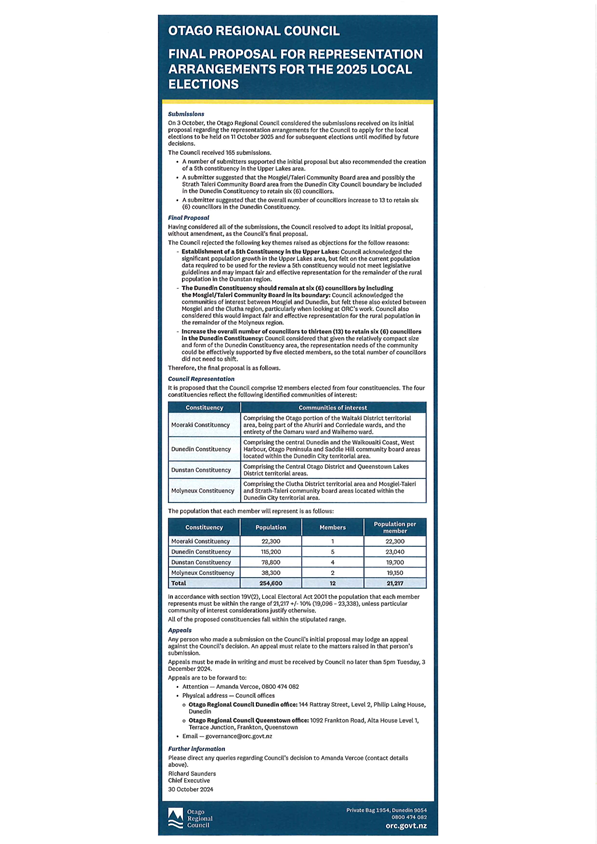
|

|
Council
25 November 2024
|
Director Vacancy in Dunedin City Holdings Limited
Department: Civic
EXECUTIVE SUMMARY
1 The
Dunedin City Holdings Ltd (DCHL) Board is made up of five directors, with one
position currently vacant. The vacancy arose following the expiry of the
term of Mr Richard Thomson’s position on the Board on 30 June
2024.
2 Council’s
“Procedure for the Appointment and Remuneration of Directors of
Dunedin City Holdings Ltd” (the Procedure) sets out the recruitment
process for appointing new directors. A copy of the Procedure is at
Attachment A.
3 This
report seeks approval to commence the process for recruiting and appointing a
new director for DCHL.
RECOMMENDATIONS
That the Council:
a) Approves commencing
the recruitment process for a new Dunedin City Holdings Ltd director, to fill
the existing vacancy.
b) Notes that if
approved, recommendations for a new director will be presented to Council for a
decision on the appointment.
BACKGROUND
4 A
vacancy on the Board of DCHL arose following the expiry of Mr Thomson’s
term as a Board member on 30 June 2024.
5 At
its meeting on 7 August 2024, a report was presented to the Finance and Council
Controlled Organisations Committee, recommending that DCHL operate with four
directors until the review of DCHL and its associated companies is
completed.
6 The
DCHL Chair of the Board has now requested that although the reviews of the
companies have not been completed, a fifth director be appointed, to ensure the
Board has all the skills needed to effectively undertake its role.
DISCUSSION
7 Under
the Procedure, DCC is responsible for the appointment of Directors to
DCHL. On becoming aware of a director vacancy, the Mayor and CEO
will consult with Councillors to consider the combined profile of other
directors and identify the skills, knowledge, background, and experience
required by the DCC from the vacant position (Clause 5.1.2.2 of the
Procedure).
8 The
skills matrix of DCHL directors is being updated, to identify specific skills
that should be sought from a new director.
9 The
Procedure provides that a DCC Advisory Group comprising the Mayor (or nominee),
Chair of the Finance and CCO Committee, the CEO and General Manager Finance and
Commercial (our Chief Financial Officer), along with the Chair of the DCHL
Board, engages an independent recruitment agency to assist with the recruitment
process.
10 It
is proposed that Simon Telfer of Stimulus NZ be engaged to commence the
recruitment process in early 2025, following the identification of the skills
sought.
11 A
recommending report will then be presented to Council to make a decision on the
appointment of a new director.
OPTIONS
12 The
Mayor, CEO and Chair of DCHL will hold a workshop with Councillors to identify
the skills required from a new director.
13 The
DCC Advisory Group will then work with Simon Telfer to identify suitable
candidates and conduct interviews before bringing a paper to Council.
NEXT STEPS
14 If
approved, Simon Telfer will be engaged to commence the recruitment process.
Signatories
|
Author:
|
Sharon Bodeker - Special Projects Manager
|
|
Authoriser:
|
Sandy Graham - Chief Executive Officer
|
Attachments
|
|
Title
|
Page
|
|
⇩a
|
Procedure for the
Appointment and Remuneration of Directors of Dunedin City Holdings Ltd
|
235
|
|
SUMMARY OF CONSIDERATIONS
|
|
Fit with purpose of Local Government
This decision enables democratic local
decision making and action by, and on behalf of communities.
|
|
Fit with strategic framework
|
|
Contributes
|
Detracts
|
Not applicable
|
|
Social Wellbeing Strategy
|
☐
|
☐
|
✔
|
|
Economic Development Strategy
|
☐
|
☐
|
✔
|
|
Environment Strategy
|
☐
|
☐
|
✔
|
|
Arts and Culture Strategy
|
☐
|
☐
|
✔
|
|
3 Waters Strategy
|
☐
|
☐
|
✔
|
|
Future Development Strategy
|
☐
|
☐
|
✔
|
|
Integrated Transport Strategy
|
☐
|
☐
|
✔
|
|
Parks and Recreation Strategy
|
☐
|
☐
|
✔
|
|
Other strategic projects/policies/plans
|
☐
|
☐
|
✔
|
This decision has no direct impact on the Strategic
Framework. Group companies do however contribute to the framework as
described in their Statements of Intent.
|
|
Māori Impact Statement
There has been no engagement with Māori, although the
criteria for appointment of Directors to the Group companies include
consideration of the need or opportunity to increase knowledge of tikanga
Māori at the governance level in the companies.
|
|
Sustainability
There are no implications for sustainability.
|
|
Zero carbon
There
are no zero carbon implications.
|
|
LTP/Annual Plan / Financial Strategy /Infrastructure
Strategy
There are no implications for the 9 year plan, Annual
Plan, Financial Strategy, or Infrastructure Strategy.
|
|
Financial considerations
There are no financial implications.
|
|
Significance
This decision is considered to be of low significance in
terms of the Council’s Significance and Engagement Policy.
|
|
Engagement – external
There has been no external engagement outside of the DCHL
Board.
|
|
Engagement - internal
There has been no internal engagement.
|
|
Risks: Legal / Health and Safety etc.
There are no identified risks.
|
|
Conflict of Interest
There are no known conflicts of interest.
|
|
Community Boards
There are no implications for Community Boards.
|
|

|
Council
25 November 2024
|
Appointment of additional member to the Hearings Committee
Department: Civic
EXECUTIVE SUMMARY
1 The
purpose of the report is to seek approval of the appointment of Cr Kevin
Gilbert as a member of the Hearings Committee.
RECOMMENDATIONS
That the Council:
a) Decides whether to appoint of Cr Kevin Gilbert
as a member of the Hearings Committee to consider Resource Management Act 1991.
BACKGROUND
2 The
Hearings Committee considers and makes recommendations and decisions on a range
of matters including Resource Management Act 1991 (RMA) matters. In order
to be appointed on to a panel considering RMA matters, members must have
successfully completed RMA training.
3 Cr
Gilbert has completed the RMA training and is now eligible to be appointed.
4 As
this is an administrative report there is no summary of considerations.
NEXT STEPS
5 If
appointed, the Committee Structure and Delegations Manual will be updated.
Signatories
|
Author:
|
Clare Sullivan - Manager Governance
|
|
Authoriser:
|
Robert West - General Manager Corporate Services
|
Attachments
There are no attachments for
this report.
|

|
Council
25 November 2024
|
Submission on Improving Efficiency in the Inspections
Process
Department: Customer and Regulatory
EXECUTIVE SUMMARY
1 This
report seeks approval of a draft Dunedin City Council (DCC) submission to the
Ministry of Business Innovation and Employment (MBIE) consultation on improving
efficiency in the inspections process (the consultation). A draft cover letter
for the submission is attached as Attachment A. The draft DCC submission, using
MBIE’s template for this consultation, is attached as Attachment B. The
consultation document is attached as Attachment C.
2 MBIE
is seeking feedback on a range of options to increase the uptake of remote
building inspections, with the aim of improving efficiency and productivity in
the building inspection process.
3 MBIE
is seeking feedback on the following options:
· Option
One: Review remote inspection guidance, address failure rates and/or publish
wait times (non-regulatory).
· Option
Two: Require building consent authorities to have the systems and capability to
conduct remote inspections.
· Option
Three: Require building consent authorities to use remote inspections as
the default approach to conducting inspections.
· Option
Four: (complementary option): Create a new offence to deter deceptive
behaviour.
4 The
DCC submission speaks to each of the options, which it supports overall with
the exception of the third option. The consultation also seeks feedback on
increasing the use of Accredited Organisations (Building) to undertake
inspections.
5
The consultation opened on 2 October 2024 and
closes on 29 November 2024.
6 Taituarā
is submitting on the consultation. The DCC’s draft submission aligns with
its draft submission.
RECOMMENDATIONS
That the Council:
a) Approves the draft
Dunedin City Council submission, with any amendments, to the Ministry for
Business Innovation and Employment on Improving Efficiency in the Inspections
Process.
b) Authorises the Chief
Executive to make any minor editorial amendments to the submission.
c) Notes that the Mayor
or delegate would speak to any hearings in regard to the submission.
BACKGROUND
7 The
DCC is the Building Consent Authority (BCA) for Dunedin City. Only registered
BCAs are permitted to perform
consenting and certifying functions in terms of the Building Act 2004.
8 Currently, less than 10% of the DCC’s building
inspections are done remotely. Examples of remote inspections include buildings
being built in other regions, such as relocatable houses which will be moved to
Dunedin City. These inspections are undertaken via live video stream. In other
cases, a remote inspection is undertaken when the work is almost completed and
can be seen it to be of a high standard, a photograph may be deemed sufficient
for final sign-off. This can also apply in the case of minor remedial work; for
example, installation of a smoke alarm.
9 The
DCC’s Building Inspectors are required to hold an appropriate Level 6
diploma qualification, which is a point of difference with most other
tradespeople. The implications that implementing the proposals may have on the
loss of expertise and a skilled workforce is addressed in the draft submission.
10 DCC
Building Inspectors who have undertaken remote inspections using live video
stream found the process difficult, time consuming, and had low confidence in
the accuracy of the inspection.
11 Feedback
from DCC Building Inspectors notes that while remote inspections provide
savings in travel time, the actual inspections often taking longer than a
face-to-face inspection.
12 The
DCC has received feedback from some tradespeople that they prefer face-to-face
inspections and do not want to participate in remote inspections. The DCC notes
that more experienced tradespeople are less likely to be comfortable with the
technology and communication modes involve in remote building inspections.
13 The
DCC notes that a benefit of face-to-face inspections is the opportunity to
provide education, support and information sharing with tradespeople and
building owners.
Consultation context:
14 This
consultation as part of wider package of Building and Construction sector
reforms being undertaken by central government, some of which have also been
opened for consultation.
15 The
DCC submitted to MBIE on the “Making it Easier to Build Granny
Flats” consultation in August 2024, and intends to submit again when the
associated legislation is introduced. DCC staff are preparing a technical
submission on the Building Code fire safety review, which is due to MBIE by 6
December 2024.
DISCUSSION
The
Dunedin City Council Submission16 The DCC notes that Option One: Review remote inspection
guidance, address failure rates and/or publish wait times, is a simple suggestion that provides benefits
with little or no additional costs to BCAs.
17 In
regard to Option Two, requiring building consent
authorities to have the systems and capability to conduct remote inspections,
the DCC takes the view that all BCAs should have systems and capacity to conduct
remote inspections, and notes that many BCAs already do have these in place.
18
The DCC does not support Option Three, requiring building consent
authorities to use remote inspections as the default approach to conducting
inspections. Confirming that building work
complies with the building code and building consent has a direct bearing on
the satisfactory performance of buildings and the potential liability of BCAs.
If remote inspections became the default, DCC would need to clarify what this
would mean for its insurance cover profile given our perceived increased risk.
19 The
DCC is concerned that Option Three opens the possibility that remote building
inspections may be implemented in legislation as a default, as the DCC would
not want to be obligated to do this.
20 The DCC believes
that the BCA should be able to determine how best to manage inspections and the
associated risks on behalf of ratepayers, given the current risk and liability
on BCAs and local authorities. As the BCA for Dunedin City, it is the
DCC’s role to manage risk and this option does not allow for any
discretion or autonomy.
21 The DCC agrees with the proposal in Option Four, creating
a new offence to deter deceptive behaviour during a remote inspection and give
building consent authorities more confidence to inspect remotely. However, the
proposed offence would require proof of deceptive intent and does not address
merely poorly executed works carried out honestly. The submission also
acknowledges the difficulty in proving an offence has occurred when
building work is often built-in or covered up. The DCC also notes that there
may be limited council uptake due to the time and resources required to
investigate and prosecute this type of offence.
22 In
regard to Option Four, the DCC submission re-emphasises that BCAs should be able to determine how best to manage
inspections and the associated risks on behalf of ratepayers given the current
risk and liability on BCAs and local authorities; hence, its preference for face-to
face inspections.
23 The DCC proposes an additional option that the requirement
to undertake inspections with a maximum timeframe be incorporated into the
Building Act 2004, similar to how it includes a 20-day time limit on granting
Building Consents.
24 The
DCC submission includes suggestions for inspections which may be suited to
being conducted remotely, such as installing insulation, site location, and
block work.
25 The
DCC’s position is that a number of inspections should never be undertaken
remotely, including: ground bearing capacity; cladding; pile foundation;
framing preline; completion inspections for complex projects; and inspections
for certificates for public use and acceptance.
Increasing the Use of Accredited Organisations
(Building) to Undertake Inspections
26 The DCC’s position, as detailed in the draft
submission, is that it would support contracting Accredited Organisations
(Building) to undertake inspections if liability is removed for councils, and
the organisations are able to get insurance cover. Historically this has been one of the factors
that caused private building control authorities to cease trading.
27 The
DCC submission notes it has contracted services in the past and found that the
arrangement generated nearly as much work as it saved. There are also considerable
costs when contracting private profit-making entities.
28 The
DCC submission identifies the following risks with contracting Accredited
Organisations (Building) to undertake inspections:
· loss of the skilled
DCC workforce
· less control over quality
and consistency of inspections undertaken
· difficulty resolving issues
when the DCC and or accredited organisations disagree with each
other’s process or inspection findings
· possible reputational risk
to DCC due to negligence by the other party.
29 The
DCC submission notes that the average industry skill level of Licensed Building
Practitioners and Authorised Plumbers contributes to high inspection failure
rates experienced by most BCAs. Therefore, at minimum, DCC seeks a requirement
for a continuing competency assessment regime similar to the assessment process
that is already in place for BCA staff.
OPTIONS
Option One – Recommended Option
30 Approve
the DCC submission to MBIE on the Improving efficiency in the inspections
process consultation.
Advantages
· Opportunity for
the DCC to advocate in its role as the Building Consent Authority for Dunedin
City.
· Opportunity for
the DCC to express its views about proposals that impact on the building and
construction system in Ōtepoti Dunedin.
Disadvantages
· There are no
identified disadvantages.
Option Two – Status Quo
31 Do
not approve the DCC submission to MBIE on the Improving efficiency in the
inspections process consultation.
Advantages
· There are no
identified advantages.
Disadvantages
· Missed opportunity
for the DCC to advocate in its role as the Building Consent Authority for
Dunedin City.
· Missed opportunity
for the DCC to express its views about proposals that impact on the building
and construction system in Ōtepoti Dunedin.
NEXT STEPS
32 If the
submission is approved staff will submit it, with any amendments, to the
Ministry for Business Innovation and Employment by 29 November 2024.
Signatories
|
Author:
|
Neil McLeod - Principal Advisor – Building Services
|
|
Authoriser:
|
Paul Henderson - General Manager Customer and Regulatory
(Acting)
|
Attachments
|
|
Title
|
Page
|
|
⇩a
|
Cover letter DCC
submission on Improving efficiency in the inspections process
|
252
|
|
⇩b
|
Draft DCC submission on
Improving efficiency in the inspection process
|
255
|
|
⇩c
|
Consultation document
for Improving efficiency in the inspections process
|
273
|
|
SUMMARY OF CONSIDERATIONS
|
|
Fit with purpose of Local Government
This decision promotes the social,
economic, and environmental well-being of communities in the present and for
the future.
|
|
Fit with strategic framework
|
|
Contributes
|
Detracts
|
Not applicable
|
|
Social Wellbeing Strategy
|
✔
|
☐
|
☐
|
|
Economic Development Strategy
|
✔
|
☐
|
☐
|
|
Environment Strategy
|
✔
|
☐
|
☐
|
|
Arts and Culture Strategy
|
☐
|
☐
|
✔
|
|
3 Waters Strategy
|
☐
|
☐
|
✔
|
|
Future Development Strategy
|
✔
|
☐
|
☐
|
|
Integrated Transport Strategy
|
☐
|
☐
|
✔
|
|
Parks and Recreation Strategy
|
☐
|
☐
|
✔
|
|
Other strategic projects/policies/plans
|
☐
|
☐
|
☐
|
There is a strategic fit with the
Zero Carbon Policy, and Te Taki Haruru – Māori Strategic Framework.
|
|
Māori Impact Statement
Te Taki Haruru, the DCC’s Māori Strategic
Framework, includes the principle of Autaketake and the values of tapu and
noa, which provide an element of safety over an activity or resource.
|
|
Sustainability
Proposals in the consultation have potential implications
for sustainability, and the DCC’s commitment to its Zero Carbon Policy.
|
|
LTP/Annual Plan / Financial Strategy /Infrastructure
Strategy
There are no implications for current levels of service
and/or performance measures.
|
|
Financial considerations
There are no financial implications
|
|
Significance
This decision is considered low in terms of the
Council’s Significance and Engagement Policy.
|
|
Engagement – external
|
|
Engagement - internal
This submission has been prepared by staff from the
Building Services team, including Senior Building Inspectors, and the Legal
and Corporate Policy teams.
|
|
Risks: Legal / Health and
Safety etc.
Confirming that building work
complies with the Building Code and building consent has a direct bearing on
the satisfactory performance of buildings and the potential liability of
BCAs. If remote inspections became the default, DCC
would need to clarify what this would mean for its insurance cover profile
given our perceived increased risk.
|
|
Conflict of Interest
There is no conflict of
interest.
|
|
Community Boards
|

|

|
Council
25 November 2024
|
Proposed Event Road Closures
Department: Transport
EXECUTIVE SUMMARY
1 The
DCC has received temporary road closure applications relating to the following
events:
a) Graduation
Parades
b) Community
Christmas Event – Lanark Street Cul-de-sac
c) Filming
d) Veteran
Car Run
e) Waitangi
Day Celebrations
f) Weet-Bix
Kids TRYathlon
2 This
report recommends that Council approves the temporary closure of the affected
roads.
RECOMMENDATIONS
That the Council:
a) Resolves to close the
roads detailed below (pursuant to Section 319, Section 342, and Schedule 10
clause 11(e) of the Local Government Act 1974 (LGA 1974)):
i) Graduation
Parades
Note:
Graduation times are the same time for each day specified below.
|
Saturday, 7 December 2024
AND
Wednesday, 11 December 2024
AND
Saturday, 14 December 2024
|
11.00am to 11.30am
|
· Great King Street, between Frederick Street and
Albany Street (parade starts at 11:30 from Great King Street)
|
|
11.10am to 12.15pm (approx.)
|
· Frederick Street, between Great King Street and
George Street
· George Street, between Frederick Street and Moray
Place
|
|
11.10am to 12.30pm
|
· Moray Place, between George Street and Upper Stuart
Street
· Filleul Street, between Moray Place and St Andrew
Street
|
ii) Community
Christmas Event – Lanark Street Cul-de-sac
Note: Contingency date is 15 December
2024.
|
8 December 2024
|
1.00pm to 9.00pm
|
· Lanark Street cul-de-sac, from Irvine Street to end
|
iii) Filming
Note: Only one of the days below will be
closed for this activity.
|
ONE of the following dates:
Sunday, 12 January 2025
OR
Sunday, 19 January 2025
OR
Sunday, 26 January 2025
OR
Sunday, 2 February 2025
|
1.00am to 6.00am
|
· Princes Street, between Jetty Street and Rattray Street
· Liverpool Street, between Princes Street and Bond
Street
· Water Street, between Princes Street and Bond Street
· Rattray Street and Queens Gardens, between Princes
Street and Crawford Street
· Dowling Street, between Princes Street and SH1
· Burlington Street, between Moray Place and SH1
· Bond Street, between Rattray Street and Water Street
· Vogel Street, between Queens Gardens and Water
Street
· Stuart Street, between SH1 Cumberland Street and SH1
Castle Street
|
iv) Veteran Car Run
|
Saturday, 25 January 2025
|
9.00am to 12.00pm
|
· The Octagon Central Carriageway
|
v) Waitangi Day Celebrations
|
Thursday, 6 February 2025
|
9.00am to 4.00pm
|
· The Octagon Central Carriageway, between Princes
Street and George Street
|
i) Weet-Bix
Kids TRYathlon
Lane
(half road) closures will be in place on the following roads in Mosgiel for the
cycle course part of the above event:
|
Sunday, 2 March 2025
|
6.30am to 1.30pm
|
· Factory Road, from High Street to Church Street
· High Street, from Factory Road to Green Street
· Green Street, from Church Street to High Street
· Church Street, from Factory Street to Green Street
|
BACKGROUND
3 Council’s
Dunedin Festival and Events Plan supports the goal of a successful city with a
diverse, innovative, and productive economy and a hub for skill and
talent.
4 The
areas proposed to be used for these events are legal roads and can therefore be
temporarily closed to normal traffic if statutory temporary road closure
procedures are followed. The procedures are set out in Section 319 of the LGA
1974 and give Council the power to stop or close any road (or part of a road)
within the parameters of Section 342 and Schedule 10 of the LGA 1974 (Schedule
10 is included as Attachment A).
5 These
procedures include:
· Consultation
with the New Zealand Transport Authority Waka Kotahi and the Police.
· Public
notice being given of the proposal to close any road (or part of a road), and public
notice of a decision to close the road.
· Council
being satisfied that traffic is not likely to be unreasonably impeded.
6 A
resolution of Council is required where a proposal to temporarily close a road
relates to public functions.
7 Council
is required to give public notice of its decision. This notice will be
published after this meeting and prior to the event, if approved.
DISCUSSION
Consultation
and Notification
8 The
Police and the New Zealand Transport Authority Waka Kotahi have no objections
to the proposed road closures.
9 On
Saturday, 19 October 2024 and Wednesday, 20 November 2024, the proposed
temporary road closures were advertised in the Otago Daily Times (Attachments B
and C) with a deadline for feedback.
10 The
event organisers contacted those considered affected prior to submitting their
application, and no objections were received.
11 Schedule 10
clause 11(e) states a road cannot be closed more than 31 days in the
aggregate in any one year. This limit will not be exceeded by the
approval of the proposed temporary road closures.
Traffic Impacts
12 The
event locations of these events have had identical road closures for the same,
or similar event(s) in prior years without causing unreasonable delays to the
travelling public.
13 Emergency
services and public transport services will be managed through the temporary
traffic management process.
14 The
Temporary Traffic Management Plan process ensures that other issues such as
temporary relocation of certain parking (e.g. taxi, mobility and Authorised
Vehicles Only) are managed.
OPTIONS
15 Note
any amendment to this report’s recommendations cannot be implemented
without further consultation with the affected parties, New Zealand Transport
Agency Waka Kotahi, the Police, and verifying that traffic impacts are
acceptable.
Option One – Recommended Option
16 That
the Council closes the sections of road as recommended in this report.
Advantages
· Roads
can be closed, and the event will be able to proceed.
· The
closures will assist in realising the economic, social, and cultural benefits
associated with the events.
Disadvantages
· There
will be temporary loss of vehicular access through the closed areas. However,
there are detours available, and safety can be assured using temporary traffic
management.
Option Two – Status Quo
17 That
the Council decides not to close the roads in question.
Advantages
· There
would be no detour required for the travelling public, and the roads would be
able to be used as normal.
Disadvantages
· The
events would not be able to go ahead, and the benefits of the events would be
lost.
NEXT STEPS
18 Should
the resolution be made to temporarily close the roads, Council staff will
accept the temporary traffic management plans that have been received for the
events and notify the public of the closures.
Signatories
|
Authoriser:
|
Jeanine Benson - Group Manager Transport
Scott MacLean - General Manager, Climate and City Growth
|
Attachments
|
|
Title
|
Page
|
|
⇩a
|
Local Government Act
1974, Schedule 10
|
304
|
|
⇩b
|
ODT Advert - 19 October
2024
|
309
|
|
⇩c
|
ODT Advert - 20
November 2024
|
310
|
|
SUMMARY
OF CONSIDERATIONS
|
|
Fit with purpose of Local Government
This decision promotes the social
well-being of communities in the present and for the future.
|
|
Fit with strategic framework
|
|
Contributes
|
Detracts
|
Not applicable
|
|
Social Wellbeing Strategy
|
✔
|
☐
|
☐
|
|
Economic Development Strategy
|
✔
|
☐
|
☐
|
|
Environment Strategy
|
☐
|
☐
|
✔
|
|
Arts and Culture Strategy
|
✔
|
☐
|
☐
|
|
3 Waters Strategy
|
☐
|
☐
|
✔
|
|
Future Development Strategy
|
☐
|
☐
|
✔
|
|
Integrated Transport Strategy
|
☐
|
☐
|
✔
|
|
Parks and Recreation Strategy
|
☐
|
☐
|
✔
|
|
Other strategic projects/policies/plans
|
✔
|
☐
|
☐
|
Events contribute to the Strategic Framework. Events
contribute to the Economic Development Strategy, the Social Wellbeing
Strategy. There is a Festival and Events Plan 2018-2023.
|
|
Māori Impact Statement
Mana whenua have not been directly engaged with in
relation to these road closures.
|
|
Sustainability
There are no implications for sustainability.
|
|
LTP/Annual Plan / Financial Strategy /Infrastructure
Strategy
There are no implications, as the decision is a regulatory
one and there are no direct costs to Council.
|
|
Financial considerations
There are no financial implications. The cost of the
proposed road closure is not a cost to Council.
|
|
Significance
This decision is considered low in terms of the
Council’s Significance and Engagement Policy.
|
|
Engagement – external
There has been external engagement (as required by the LGA
1974), with the Police and New Zealand Transport Agency Waka Kotahi. Affected
parties were notified and provided a time period for feedback.
|
|
Engagement - internal
There has been engagement with DCC Events and
Transport. There is support for the events to proceed.
|
|
Risks: Legal / Health and Safety etc.
There are no identified risks should the recommended
resolution be made.
|
|
Conflict of Interest
There are no known conflicts of interest.
|
|
Community Boards
There are no implications for Community Boards.
|
|

|
Council
25 November 2024
|
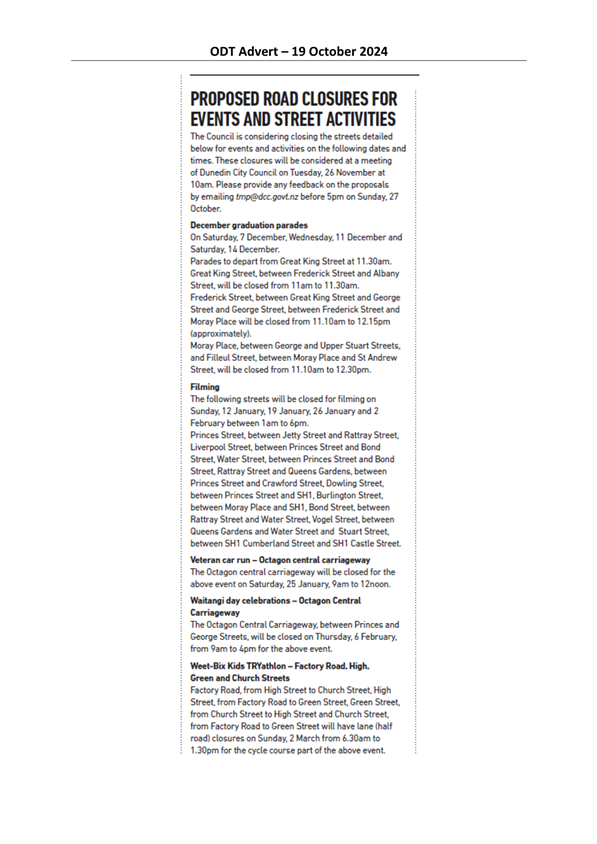
|

|
Council
25 November 2024
|

|

|
Council
25 November 2024
|
Local Water Done Well - Decision on Model Shortlist for
Water Services Delivery Plan
Department: Legal Services
EXECUTIVE SUMMARY
1 Council
is required to submit a Water Services Delivery Plan (WSDP) to the Secretary
for Local Government by 3 September 2025.
2 A
key content requirement of the WSDP is “the anticipated or proposed model
or arrangements for delivering water services (including whether the
territorial authority is likely to enter into a joint arrangement)”
(Model). An implementation plan for delivering the Model must also be
included in the WSDP.
3 Timeframes
are constrained in delivering the WSDP as shown in the timeline prepared by
staff (Attachment A) (Timeline).
4 Legislation
requires Council to consider specific options when deciding on the Model.
This includes existing delivery and a water services council-controlled
organisation (WSCCO). However, Council is also able to identify other
additional options.
5 The
purpose of this Report is to:
a) Update
Council on the Timeline and process involved in preparing the WSDP,
particularly relating to the Model.
b) Provide
Council with a long list of possible Model options and external analysis
received on the long list to date.
c) Recommend
to Council they decide on a short list of options for the Model (Short List)
and direct staff to arrange further detailed analysis on the options under the
Short List.
d) Recommend to
Council that the Short List includes three base models (in-house delivery,
single CCO and regional multi-council CCO) and any optional add-on(s) subject
to further analysis.
e) Signal
that there will be a subsequent report in early 2025 asking Council to make a
“decision in principle” on the Model, subject to public
consultation.
f) Update
Council on further engagement with other territorial authorities and Mana
Whenua.
RECOMMENDATIONS
That the Council:
a) Decides to
shortlist three base models (in-house delivery, single CCO and
regional multi-council CCO) and any optional add-on(s) subject to further
analysis.
b) Directs staff to arrange further analysis on the shortlisted
options selected.
c) Directs staff to report back to
Council in early 2025 to enable a decision in principle on the Model proposal
and alternative model(s) that Council will consult on.
BACKGROUND
Local Water Done Well
6 The
Government continues to progress the three-stage process to enabling the Local
Water Done Well reform programme (LWDW).
7 The
first stage of LWDW saw the repeal of legislation relating to water services
entities in February 2024.
8 The
second stage of LWDW was implemented with the passing of the Local Government
(Water Services Preliminary Arrangements) Act 2024 (Preliminary Act) on 2
September 2024. As a result of the Preliminary Act, Council is now
required to prepare and submit a WSDP to the Secretary for Local Government by
3 September 2025.
9 The
third stage of LWDW is expected to be the introduction of the Local Government
Water Services Bill (December Bill) in December 2024 with possible enactment in
mid-2025. The December Bill is intended to provide the enduring settings
going forward for LWDW including the framework for economic regulation as well
as the more detailed powers and duties for service delivery models.
10 Guidance
on the future water services delivery system was released by the DIA on 8 August
2024. This was based on the LWDW Cabinet decisions announced by the
Minister of Local Government in August 2024. Further guidance was also
released by the DIA on 3 September 2024, specifically in relation to WSDPs
and provides a template for Council to develop the WSDP content. Some of
the key factsheets and summaries have been attached at Attachment B and further
detail is available on the DIA website at https://www.dia.govt.nz/Water-Services-Policy-and-Legislation
(Guidance).
11 However,
it is important to note that the Guidance will be subject to amendment as the
December Bill proceeds through the parliamentary process. The December
Bill may not be enacted until mid-2025 yet Council is required to proceed with
decisions to enable delivery of the WSDP by 3 September 2025.
Water Service Delivery Plan
12 Preparing
the WSDP requires technical and rigorous analysis. This will involve
significant work by staff.
13 The
WSDP requires information on the Model including:
a) the
anticipated or proposed model or arrangements for delivering water services
(including whether Council is likely to enter a joint arrangement or will continue
to deliver water services alone);
b) summary
of consultation undertaken as part of developing the Model in the WSDP; and
c) an
implementation plan for delivering the Model (Guidance indicates that the
implementation plan requires information on process, commitment, timeframes,
and milestones).
14 Note
if Council decided to enter a joint arrangement with another territorial
authority they could choose to prepare and submit a joint WSDP.
15 Council
is required by law to give effect to the proposals or undertakings relating to
the future delivery of water services specified in the WSDP. Not doing so
could be a ground for appointing a Crown facilitator.
16 There
is an opportunity to amend a WSDP within a specified timeframe if the proposed
amendments are significant and necessary due to exceptional circumstances.
17 A
staff LWDW Working Group has been established to coordinate the delivery of the
WSDP.
18 To
continue preparing the WSDP, staff seek direction from Council on a Short List
of potential Models. Staff will undertake detailed analysis of the shortlisted
Models and will report back to Council early next year so that Council can
select which Models it wants to consult on and which Model “in
principle” is its preferred Model (subject to consultation).
Decision Making and Consultation on the Model
19 The
Preliminary Act presents an alternative process that Council must use for
decision making and consultation on the Model.
20 Council
is not required to comply with the corresponding requirement in the Local
Government Act 2002 (LGA 2002) where an alternative process under the
Preliminary Act applies.
Decision Making
21 The
Preliminary Act requires decision making relating to the Model to identify both
of the following two options for delivering water services:
a) Remaining
with the existing approach for delivering water services; and
b) Establishing,
joining, or amending (as the case may be) the WSCCO or the joint local
government arrangement.
Note: For the purposes of this
Report the above two options are called the “Legally Required
Options”.
22 Council
may also identify additional options for delivering water services and must
assess the advantages and disadvantages of all options identified.
Consultation
23 Council
is only required to consult once but may decide to undertake further
consultation before deciding on a Model.
24 Given
Council did not adopt an LTP in 2024, the Preliminary Act provides that Council
can combine consultation on both the LTP 2025-2034, and the Model.
25 As
noted in the ISCOM Report on 17 September 2024, there is merit in combining the
timing of the LTP consultation with the timing of the consultation on the WSDP.
The mechanics of whether the consultation documents should be combined as one
consultation document or two will be assessed in the report to Council early
next year.
Information Requirements for
Consultation
26 During
consultation, Council must make the following information publicly available:
|
The
proposal, an explanation of the proposal and the reasons for the proposal.
|
|
An analysis
of the reasonably practicable options (including the proposal) which must be
the two options referred to above under decision making.
|
|
How
proceeding (or not) with the proposal is likely to affect DCC’s rates,
debt, levels of service and water services charges.
|
|
Community
implications (if joint) and accountability/monitoring arrangements (if assets
transferred).
|
|
Any other
relevant implications of the proposal that the authority considers will be of
interest to the public.
|
27 If
a council is required to amend its LTP to give effect to a Model, a council is
not required to consult on the proposal if it:
a) has
already consulted its community in relation to the proposal;
b) is
satisfied that its community has a good understanding of the implications of
the proposal; and
c) is
satisfied that it understands its community’s views on the proposal.
28 Council
is required to consult with Mana Whenua under both section 77(1)(c) and section
81 of the LGA 2002 given both references are included under section 60 of
the Preliminary Act. Further, section 14(1)(d) of the LGA 2002 also
provides that a local authority should provide opportunities for Māori to
contribute to its decision-making processes.
Timeline and Process
29 Council’s
current Timeline for adopting the WSDP, including process for making a decision
on the Model is provided at Attachment A. The Timeline is subject to
amendment as required by further Government direction or legislation.
30 DIA’s
implementation roadmap for LWDW (including for Council
Water Service Delivery Arrangements) is shown at Attachment C.
31 To
date, staff have presented on the WSDP (including on possible Model options) as
below:
· ISCOM
on 17 September 2024 (outlining the WSDP requirements and process) (ISCOM
Report).
· Council
Workshop on 3 October 2024 (Possible Models/Arrangements).
· Council
Workshop on 23 October 2024 (LWDW Review).
32 This
Report is limited to providing information on the Long List of possible Model
options to aid a decision on a Short List. This Report does not discuss
other content required under the WSDP or future water delivery settings except
where discussed as part of the analysis on possible Model options.
33 For
further detail on other content requirements under the WSDP, refer to both the
ISCOM Report dated 17 September 2024 and Guidance.
34 For
further information as to what is likely expected in the December Bill refer
also to the DIA website. Staff anticipate that there will be an
opportunity to submit on the future settings once the December Bill has been
introduced.
Engagement with other Territorial Authorities
35 As
discussed in the ISCOM Report, an Otago/Southland LWDW Working Group (Regional
Working Group) was formed in April 2024. The Regional Working Group was
overseen by the Chief Executive Officers of each council and reported to the
Otago/Southland Mayoral Forum.
36 The
Regional Working Group has now substantially completed its scope of work to
investigate:
· Regional
collaboration opportunities.
· Regional
delivery models.
· National
collaboration opportunities.
37 Morrison
Low was appointed by the Regional Working Group to assess regional delivery
models suitable for the Otago and Southland regions. The assessment
followed The Treasury – Te Tai Ōhanga Better Business Case
methodology to ascertain investment objectives and critical success factors which
were used to refine to a short list of regional delivery model options and
assess their relative merits and drawbacks.
38 The
Regional Working Group’s regional delivery model findings were presented
to the Local Government Zone 6 Council on 1 November 2024. The Regional
Working Group shortlisted options and findings are discussed further below in
this Report.
39 Otago
councils are currently in the process of considering options for WSDPs.
At the time of writing none have made a decision about their preferred
option. All councils will be considering papers between now and the first
week in December 2024. Staff understand that a combined CCO is an option that
is favoured by some of the councils while others are looking at options where
they continue to deliver water services in their own right. Staff are in
contact with their counterparts at the other authorities and will update
Councillors once the preferences of other territorial authorities are
known.
Engagement with Mana Whenua
40 Engagement
with Mana Whenua on the Model to date has been focused through the Regional
Working Group and ISCOM activities and includes:

41 It
is anticipated that further engagement with Te Pae Māori will be
undertaken in December 2024.
DISCUSSION
Model Options – Introduction
42 It
is expected that the December Bill will enable the establishment of new
financially separate water organisations. The Guidance states further
that “Councils will be able to continue to be able to deliver water
services directly (such as through inhouse business units), however they will
also be able to establish new water organisations that are more financially and
operationally independent of councils”.
43 The
Guidance further states councils will be able to design their own alternative
delivery arrangements if these arrangements meet the minimum requirements set
out in the legislation.
44 Possible
Model options (already presented to Council in Workshops) include those models
described in:
a) DIA
Guidance — model options anticipated to be introduced to law in the
December Bill (refer Attachment D) (DIA Models);
b) Morrison
Low Report dated 24 October 2024 as commissioned by the Regional Working Group
(refer Attachment E) (Regional Options); and
c) Simpson
Grierson analysis dated 11 July 2024 – outlining other possible options (refer
Attachment F).
45 The
Model options presented within the above documents are together referred to in
this Report as the “Long List”. However, note that the Long
List may also include any other option that Council adopts if it meets minimum
requirements and is otherwise legally compliant.
46 Given
the constraints in the Timeline and resource required to provide further
detailed analysis, staff now recommend that Council analyse the Long List and
decide on a Short List. Further initial information on the Long List is
provided below.
47 In
analysing the Long List, Council must consider the implications of the:
a) minimum
requirements (likely introduced in the December Bill); and
b) Legally
Required Options (but Council may also identify additional options).
48 Given
the Legally Required Options, staff provide some initial comparative analysis
on three base models (in-house delivery, single CCO and multi-council CCO).
Despite the further comparison of these three base models, all options are
available for Council to consider. Council may request further analysis
from staff on any other option.
Minimum Requirements – Summary
49 Guidance
indicates that the December Bill will establish a framework that requires
minimum requirements are met by all water service providers (including in-house
delivery). Additional requirements for those forming water organisations
and consumer-trust models are also likely to apply.
50 While
still subject to amendment during the legislative process, staff would not
expect major amendment to the underlying principles of the minimum requirements
given the detailed Guidance to date and the expected reliance by all
territorial authority processes to date.
Water Service Provider
51 A
water service “provider” means all forms of local government
providers including councils that continue with direct (in-house) delivery.
Irrespective of what Model is chosen by Council these minimum requirements need
to be met and significant change would be required even to an in-house model.
Therefore, this Report refers to this option as “in-house” delivery
rather than “status quo”.
52 Further
detail on each of the minimum requirements for all water services providers is
given below but an initial summary is shown in the below table (copied from the
Guidance):

Water Organisation
53 The
term “water organisation” refers to a separate organisation that
Council may establish to provide water services and does not include in-house
delivery.
54 Additional
legislative requirements are likely to apply if forming a “water
organisation”. Guidance suggests these could affect the
organisation’s ownership, governance and structural arrangements and
include:
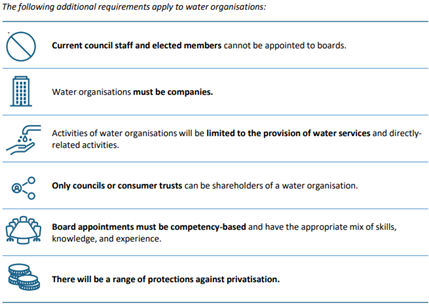
55 Further
requirements will also likely apply if a consumer trust-owned water
organisation is adopted. Refer to page 6 of the Guidance at Attachment B.
56 The
Guidance indicates that an exemption may be able to be applied for on a
case-by-case basis through an Order in Council from the following requirements:
· Water
organisations must be companies;
· Activities
to be limited to the provision of water services and directly related
activities; and
· Only
councils or consumer trusts can be shareholders of a water organisation
(however, still ensuring no form of privatisation is permitted).
Minimum Requirements – Further Detail
Regulation
57 Guidance
indicates that the December Bill will include regulatory settings to ensure
water service providers will be subject to economic, environmental and water
quality regulation including the following:
|
Economic
regulation and consumer protection
|
1 Economic
regulation tools available to the Commerce Commission include:
· Information disclosure, revenue thresholds, financial
ringfencing, quality standards and performance requirements, price-quality
regulation.
2 Consumer
protection tools available to the Commerce Commission include:
· Complaints regulations, dispute resolution
regulations, guidelines on service quality codes; and a mandatory service
quality code.
3 Economic
regulation regime will be risk-based and flexible. Based on information
supplied in WSDP and information disclosure requirements, the regulator will
be able to set individual requirements for certain providers and common
regulations where appropriate.
4 Economic
regulation will apply to drinking water and wastewater services and will
provide flexibility to include stormwater services at a later date if
necessary.
5 Cost
of the regulator due to providing economic regulation of water services, will
be funded through a levy on local water services providers.
DIA Guidance Factsheet
Link Economic regulation and consumer protection
|
|
Drinking
water regulation
|
1 Changes
aim to reduce the cost and burden for drinking water suppliers associated
with complying with the Water Services Act 2021. Changes are designed
to improve the efficiency and effectiveness of the drinking water regulatory
regime and the approach Taumata Arowai takes to regulating.
2 Propose
to reduce regulatory burden on small suppliers, by excluding ‘shared
domestic supplies’ serving 25 consumers or fewer from regulation.
Higher risk community supplies (such as community halls and marae) would not
be covered by this exclusion.
3 Amend
legislation to refer to ‘Water Services Authority – Taumata
Arowai’.
4 Changes
to provide clarity around how to give effect to Te Mana o te Wai.
DIA Guidance Factsheet
Link Drinking water quality regulation
|
58 Likely
timing of the new regulatory settings are set out in the DIA Implementation
Roadmap for LWDW including environmental regulation for wastewater, stormwater
and infrastructure (refer Attachment C).
Planning and Accountability
Framework
59 The
Guidance indicates the following three core documents will make up the new planning
and accountability framework:
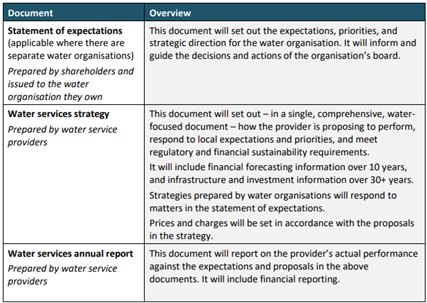
60 In
addition, water service providers will be required to develop standalone
financial statements for all water services (drinking water, wastewater,
stormwater, and aggregated water services). These statements will
separate water services charges, expenses and liabilities from other council
activities.
61 Councils
that continue to deliver water services in-house will prepare a water services
strategy and associated annual report instead of including extensive information
on water services in their general LTP, infrastructure strategy, financial
strategy and annual report.
62 For
more detailed information refer to the DIA Guidance Factsheet (Planning and
accountability for local government water services) (refer Attachment B).
Financially Sustainable
63 A
WSDP needs an explanation of how revenue from and delivery of water services
will be separated from other functions and activities. Further, an
explanation of how Council proposes to ensure delivery of water services will
be financially sustainable by 30 June 2028.
64 The
Guidance states that ringfencing requires that:
a) Water
revenues be spent on water services; and
b) Water
services charges and expenses be transparent and accountable.
65 The
Preliminary Act defines ‘financially sustainable’, in relation to a
council’s delivery of water services, as:
a) The
revenue applied to the council’s delivery of those water services is
sufficient to ensure the council’s long-term investment in delivering
water services; and
b) The
council is financially able to meet all regulatory standards and requirements
for the council’s delivery of those water services.
66 The
Guidance suggests three components to assessing financial sustainability:
a) Revenue
sufficiency – is there sufficient revenue to cover the costs (including
servicing debt) of water services delivery?
b) Investment
sufficiency – is the projected level of investment sufficient to meet
regulatory requirements and provide for growth?
c) Financing
sufficiency – are funding and finance arrangements sufficient to meet
investment requirements?
67 The
Guidance makes further recommendations about how councils can demonstrate
ringfencing. It also provides further information about financial
sustainability as well as providing a template for financial projections and a
financial sustainability test (See DIA link Guidance
for preparing Water Services Delivery Plans).
Requirement to act
consistently with Statutory Objectives
68 It
is expected that the December Bill will set out a list of statutory objectives
that will apply to all water service providers.
69 Guidance
also suggests there will be additional statutory objectives that apply to water
organisations, such as those listed above under minimum requirements for water
organisations.
70 Further
analysis of the statutory objectives will be required by staff when the
December Bill is introduced.
Protections against
Privatisation
71 Guidance
states that the December Bill will likely include the following statutory
protections:
· Only
local authorities and/or consumer trusts will be permitted to own shares in a
water organisation.
· Provisions
that prevent:
i) water
infrastructure assets from being used as security for any purpose;
ii) divestment
of ownership or other interest in a water service except to another local government
organisation or water organisation; and
iii) loss
of control of, sale, or other form of disposal of the significant
infrastructure necessary for providing water services in its region or
district, unless, in doing so, the local authority or water organisation
retains its capacity to meet its obligations.
· Shares
in water organisations cannot give any right, title or interest in the assets,
security, debts, or liabilities of the entity, and would not be able to be sold
or transferred.
· Water
organisations that involve consumer trusts will require additional provisions
to ensure ownership interests cannot be transferred.
Long List – Model Options
DIA Models
72 The
DIA Models outlined in the Guidance (and as described to Council in the ISCOM
Report) are shown in the table below:
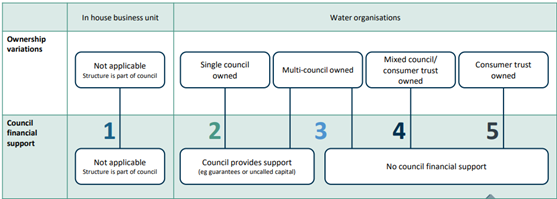
73 An
overview of the DIA models is provided below, and more information can be found
in the Guidance (refer Attachment B). Further comparative analysis
including some advantages and disadvantages (as provided and inferred from
external analysis) on the first three of these models is also shown later in
this Report:
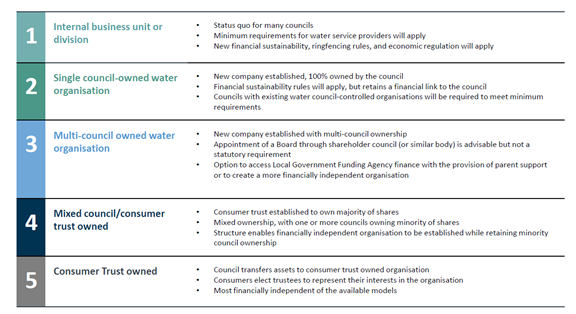
Otago Southland Regional
Working Group
74 As
referred to above, the Regional Working Group commissioned a report by Morrison
Low to develop a first principles approach to identify the range of pathways
and the short list of options for service delivery in the two regions.
75 Five
strategic objectives were developed by the Regional Working Group and overseen
by Chief Executives and endorsed by Mayors across the regions. The
endorsed objectives were:
a) To
deliver three waters services in a way that reflects the importance of water to
the health of our residents, visitors, environment and economy.
b) To
deliver three waters services that sustainably respond to change in population,
economic activity and climate change.
c) To
deliver three waters services through a model that is responsive to the local
needs of our communities.
d) To
provide efficient and effective services through a model that supports robust
decision making and the development of enduring capability and capacity.
e) To
ensure that three waters are delivered through a model that is enduring and
financially sustainable.
76 The
Regional Options that were assessed in the Morrison Low Report against the
strategic objectives were:
a) Status
Quo: Councils continue with existing delivery models.
b) Joint
Contracts: Councils enter joint contracts for core services such as
engineering services, asset management services or laboratories.
c) Shared
Services Entity: Establishing a formal entity for shared services,
including those that could be included in joint contracts. The entity may
employ its own staff and would likely include a broader suite of shared
services than a joint contracts model.
d) Management
CCO: A CCO responsible for most elements of water services delivery.
Each council would continue to set its own charges, manage its own debt, and
agree a three waters budget.
e) Multi-Council
Water Services Entity (Otago Southland WSE): A single entity responsible
for all elements of water services delivery. Councils would not own
assets, set charges or manage their own debt. Arrangements could be
agreed around the approach to harmonising prices or ringfencing some
debt.
77 The
Morrison Low Report also states that the Regional Working Group considered many
other options within their wider analysis including a joint committee,
community owned cooperative/trust, delivery through a regional council,
memorandum of understanding, shared arrangement, joint venture, multiple CCOs
or entities and a consumer trust. These options did not make the Regional
Working Group’s short list based on a review of compliance against the
agreed strategic objectives.
78 In
essence, Morrison Low considered that:
a) There
is a compelling case for changing the water services delivery model in Otago
and Southland; and
b) There
are clear benefits for the Otago and Southland Regions to establish an Otago
Southland Water Services Entity.
79 Full
analysis of the Regional Options are provided in the Morrison Low Report
(Attachment E).
Other Possible Model Options
80 As
shown in the Simpson Grierson Advice dated 11 July 2024 (Attachment F), other
Model options could include:
a) Management
CCO – separate CCO company to manage and deliver water services with
ownership of the water assets remaining with the Council (refer page 15 of
Attachment F).
b) Non-Charitable
Trust – independent legal entity established through a trust deed
with the power to own, hold and operate the water services assets (refer page
18 of Attachment F).
c) Joint
Committee – committee between participating councils to own, operate
and manage the water assets and services subject to the LGA 2002 framework,
without separate legal status (refer page 20 of Attachment F).
d) Charitable
Trust (Non-CCO) – independent legal entity established through a
trust deed with the power to own, hold and operate the relevant assets (refer
page 22 of Attachment F).
e) Council-owned
company (COC) – legally separate council owned company to perform
full breadth of water services, including ownership of all water assets,
revenues and liabilities. Not controlled by Council (refer page 24 of
Attachment F).
f) Limited
Partnership – established to perform full breadth of water services,
to be managed by a company appointed a general partner (refer page 26 of
Attachment F).
g) Statutory
Body – Parliament passes legislation which establishes the water
entity and sets out its scope and objectives, governance framework and
decision-making principles (refer page 28 of Attachment F).
81 Further
detail on each of these models (as well as other Models under the Long List) is
available at Attachment F.
82 Note
that the Guidance was not available as at the date of the Simpson Grierson
advice so some of the questions still posed in the advice by Simpson Grierson
may now have some further direction. For example, the Guidance now
discusses possible exemption of most new water organisations to income tax
given they are not primarily engaged in commercial activities with a
profit-making objective and will be owned by councils and consumer
trusts. If required, further consideration of tax implications on any
Short List can be arranged by staff.
83 Simpson
Grierson also considered other models such as a non-CCTO Charitable Trust, a
Port Company/Energy Company Model and an Incorporated Society however dismissed
these as viable options so didn’t include these in their analysis.
Base Models and Add Ons
84 In
analysing the Long List, staff recommend that Council classify some of the
options as base models and some as add-on(s) (that could be added to a base
model) as shown in the table below. This may simplify the decision to
adopt a Short List.
85 It
could be that Council shortlist some base models in addition to identifying
add-on(s) that they may be interested in pursuing further subject to further
analysis. The options presented by staff in this Report are presented on
this basis.
86 Staff
understand from the DIA that an “add-on” could be described in a
Council’s Implementation Plan as an option that is still being
pursued. However, it is important to note that the base model needs to
show financial sustainability within the legislated timeframe in any event.
|
BASE MODELS
|
+
(optional)
|
ADD-ON(S)
|
|
In-House
Delivery
|
Management Contract
(several variations including those as described below)
|
|
Single CCO
|
|
Multi-Council
CCO (regional or other)
|
Management
CCO (regional)
|
|
Mixed
council/consumer trust owned
|
Joint
Contracts
|
|
Consumer Trust
Owned
|
Shared
Services
|
|
Charitable/Non-Charitable
Trust
|
Joint
Committee
|
|
Council-Owned
Company
|
|
|
Limited Partnership
|
|
|
Statutory
Body
|
|
87 There
are several variations on the management contract “add-on” option
that could be analysed further. Some of these are included in the diagram
below including management contracts between:
a) DCC
and another entity e.g., an existing DCC entity (this management contract would
effectively be an “add-on” to the in-house delivery base model).
This could realise efficiencies by utilising existing skill sets but may not
allow access to increased leverage.
b) DCC and a new
asset owning DCC CCO (this management contract would effectively be an
“add-on” to the WSCCO base model). This is expected to allow the
access to increased LGFA leverage.
c) New
asset owning DCC CCO and another entity e.g., existing DCC CCO (this management
contract would effectively be an “add-on” to the WSCCO base model)
– This is expected to allow access to increased LGFA leverage.

Comparative Analysis of Possible Base Models
88 As
mentioned above, Council is required to include the Legally Required Options as
part of its consultation document. Given this requirement, staff have
provided below a summary of the key elements (including some advantages and
disadvantages provided and inferred by external analysis) on both the in-house
delivery model and single CCO models.
89 Further
comparison has also been provided on the regional multi-council base model
given this model can also satisfy the WSCCO requirement by law and
additionally, is the key recommendation from the Morrison Low Report (discussed
further below). While further information is provided on the regional
multi-council base model the decision to proceed further with this option is
subject to regional participating councils resolving to proceed to go ahead.
90 Staff
have not provided further analysis on the remaining two DIA Models involving
consumer trusts. However, further detail on these is provided in the
Guidance (refer Attachment B). Some advantages of the consumer trust
model are competency-based boards comprising professional directors and a
single focus on setting the direction and delivery of water services.
Some disadvantages include possible complications setting statements of
expectations (for a mixed council consumer trust model) or possibly no direct
influence on setting statements of expectation (where issued by a consumer
trust).
91 As
mentioned above, in any event, Council still has all options (base models and
add-on(s)) available to direct staff to arrange further analysis.
In-House/Internal Business
Unit

|
Ownership
|
· Part of Council.
· No new organisation established.
|
|
Governance
|
Responsible to Council
through mechanisms under LGA 2002
|
|
Strategic Direction
|
Council prepares a
Water Services Strategy
|
|
Accountability
|
· Act consistently with statutory
objectives.
· Water business unit reports to
Council.
· Council prepares separate annual
reporting and audited financial statements.
· Subject to economic regulation.
|
|
Borrowing
|
Borrowing undertaken by
Council e.g., by LGFA with water activity groups meeting their share of
financing costs.
|
|
Balance Sheet Treatment
|
On balance sheet
|
|
Revenue
|
Continues through
combination of general/targeted rates and financial/development contributions.
|
|
Advantages
|
· Local knowledge and close
connection to communities.
· No need for Statement of
Expectations.
· Avoids initial establishment costs
(although templates anticipated in the December Bill will likely lessen
costs).
· Avoids debate with other councils
about asset condition, cross-subsidisation, etc.
|
|
Disadvantages
|
· Debt limit for Council remains at
280% (1 July 2025) (current 285%) as opposed to water organisation which can
have 500% debt to revenue.
· Lacks single focus on delivering
water services.
· More layers of Council decision
making than legally independent structures — potentially an issue with
higher regulation, ring fencing, etc.
· Less commercial or nimble/agile due
to compliance with LGA and not being a separate legal entity.
· Possibility of no specialist
expertise at governance level (but could be obtained through
committees/subcommittees).
· In-house entity more subject to
politics of the day.
· Fails to capture scale benefits and
access to specific expertise.
· Less attractive as a specialised
entity to attract specialist staff.
· Less connected nationally and
internationally with peer organisations therefore hindering the modernisation
of service opportunities and tailoring of the operating model to suit
customer experience expectations.
|
Single CCO

|
Ownership
|
· Limited liability company 100%
owned by Council-Ownership arrangements and rights set out in constitution.
|
|
Governance
|
· Council appoints and removes board
members.
· Governed by independent,
professional directors who are responsible for all operational and financial
decisions.
|
|
Strategic Direction
|
· Shareholding council issues
Statement of Expectations.
· Water organisation prepares Water
Services Strategy.
|
|
Accountability
|
· Water organisation must act
consistently with statutory objectives.
· Reports regularly to shareholders
on performance (e.g., quarterly).
· Must produce annual report
containing audited financial statements.
· Subject to economic regulation.
|
|
Borrowing
|
Borrowing via Council
from LGFA directly supported by Council guarantee or uncalled capital.
|
|
Balance Sheet Treatment
|
On balance sheet
|
|
Revenue
|
December Bill to
include ability to assess, set and collect water services charges and ability
to identify which ratepayers to be charged for water services, as well as
allow use of development contribution regime.
|
|
Advantages
|
· LGFA will support leverage up to
equivalent of 500 percent of operating revenues.
· Corporate structure and governance:
o Single focus on setting direction
and overseeing delivery of water services.
o Competency-based board comprising
professional directors.
o Appointments committee ensures
relevant perspectives brought to director appointment process (flexibility to
appoint mana whenua, community or consumer representatives).
o Directors’ duties (including
under Companies Act 1993) apply.
· Must give effect to statement of
expectations (if consistent with CCO’s purpose and statutory
objectives) but otherwise less subject to politics of the day.
· Accountability to council shareholder
via regular reporting and annual reporting.
· Potentially more agile than
in-house as not subject to full LGA and largely independent, less
decision-making delays as less layers. Quicker response to market
fluctuations and managing operational risks.
· More attractive to staff as a
specialised entity and less barriers to potentially modernise the customer
experience.
|
|
Disadvantages
|
· Fails to capture scale benefits
including access to expertise (as opposed to multi council).
· Accountability to consumers for
service delivery potentially blurred if CCO not asset-owning.
|
Multi-Council CCO
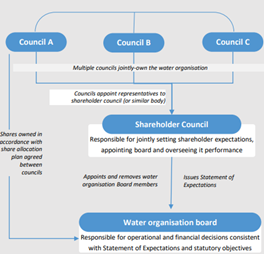
|
Ownership
|
· Limited liability company with
share allocation agreed between shareholding councils.
· Councils jointly approve
Constitution.
|
|
Governance
|
· Shareholder Council established to
appoint and remove board members.
· Governed by independent,
professional directors who are responsible for all operational and financial
decisions.
|
|
Strategic Direction
|
· Parent councils jointly issue Statement
of Expectations.
· Water organisation prepares a Water
Services Strategy.
|
|
Accountability
|
· Water organisation must act
consistently with statutory objectives.
· Reports regularly to shareholders
on performance (e.g., quarterly).
· Must produce annual report
containing audited financial statements.
· Subject to economic regulation.
|
|
Borrowing/Balance
Sheet Treatment
|
· Borrows via LGFA if parent council
provides guarantee and satisfies LGFA lending requirements / Contingent
liability (impact on council credit rating depends on council and water
organisation revenue and debt).
· Can borrow from banks and/or
capital markets without council support, subject to achieving investment
grade credit rating (challenging for some regions) / Contingent liability
(unlikely to impact council credit rating).
|
|
Revenue
|
December Bill to
include ability to assess, set and collect water services charges and ability
to identify which ratepayers to be charged for water services as well as
allow use of development contribution regime.
|
|
Advantages
|
· LGFA will support leverage up to
equivalent of 500 percent of operating revenues (assuming still meet
qualifying criteria for LGFA).
· Corporate structure and governance:
o Largely the same as for single
council CCO (However, added complexity of shareholder council).
· Must give effect to statement of
expectations (if consistent with CCO’s purpose and statutory
objectives) but otherwise less subject to politics of the day.
· Accountability to council
shareholders via regular reporting and annual reporting. Sets own
budgets and controls risk plus accountable to communities.
· Increased scale, potentially
covering entire regions, may attract higher quality directors and staff (e.g.
Watercare).
· Less layers/barriers to modernising
the customer experience.
|
|
Disadvantages
|
· Added complexity of shareholder
council plus possible difficulties in prioritisation of investment.
· Multi-council ownership could
complicate decision-making for setting statement of expectations.
· Accountability to consumers for
service delivery potentially blurred if CCO not asset-owning.
|
Morrison Low Report
Recommendation
92 As
shown below, the Morrison Low Report recommends the multi-council option.
However, some data limitations exist as was found under the previous
Governments’ model by the previous National Transition Unit of the
DIA. Should Council decide to proceed further with this option this is
also subject to any participating councils proceeding.
93 Conclusions
set out in the Morrison Low Report as commissioned by the Regional Working
Group (refer Attachment E) include:
“Demonstrates that
there are clear benefits for the Otago and Southland regions to establish an
Otago Southland WSE to provide three waters services to its communities in the
future.
The benefits of such an
arrangement will be experienced in a relatively short time frame for many
communities; three waters charges are expected to be lower by 2036 for up to
84% of the regions’ population through an Otago Southland WSE than under
the existing service delivery model. More importantly, these benefits are
likely to be enduring, with 30 year modelling indicating that future
generations will also be financially better off under an Otago Southland Water
Service Entity.
For those communities where
the financial benefits of an Otago Southland Water Service Entity are not as
great, there may be opportunities to transition at a slower pace than other
councils. This may include entering into contractual arrangements with an
Otago Southland WSE to provide professional services, the extent and scope of
which may be able to be increased over time.”
OPTIONS
94 Staff
present the following four options for Council to consider for a Short List:
a) Option
One – Shortlist three base models (and add-on(s) if required)
i) Shortlist
three base models — In-House Delivery, Single CCO, and
Regional Multi Council CCO (subject to other participants proceeding further);
and
ii) Optional
add-on(s) subject to further analysis.
b) Option
Two – Shortlist two base models (and add-on(s) if required)
i) Shortlist
two base models – In-House Delivery and Single CCO; and
ii) Optional
add-on(s) subject to further analysis.
c) Option
Three – Shortlist two base models (and add-on(s) if required)
i) Shortlist
two base models – In-House Delivery and Regional Multi Council CCO
(subject to other participants proceeding further); and
ii) Optional
add-on(s) subject to further analysis.
d) Option
Four – No shortlist.
95 While
staff have developed the above four options based primarily on the Legally
Required Options, Council is able to include in addition to Option One, Two or
Three, any other legally compliant base model.
96 In
addition to the decision on the base model, staff have also presented the
option to include “add-on(s)” to a base model. Add-ons would be
subject to further analysis by staff and further consideration by Council.
97 Staff
are recommending the Shortlist be a maximum of two or three base models given
resource and time constraints in arranging further analysis to meet the timings
shown in the Timeline.
Option One – Recommended – Shortlist Three Base
Models – In-House Delivery, Single CCO, and Regional Multi Council CCO
(subject to other participants proceeding further), with the option, of any
add-on(s) subject to further analysis.
98 Under
this option, Council would:
a) Shortlist
three base models:
i) In-house
Delivery;
ii) Single
CCO; and
iii) Regional
Multi-Council CCO.
b) Include any optional “add-on(s)” subject to further
analysis.
c) Direct
staff to arrange further detailed analysis on three base models (particularly
financial analysis) and any optional add-on(s) to report further to Council in
early 2025.
Advantages
· Efficient
and more manageable – Less staff time/resources to analyse three options
(as compared with the long list).
· Allows
staff to focus on the shortlist in detail.
· More
options available for the decision in principle in early 2025.
· Preserves
Council’s ability to progress any negotiations/discussions with other
local authorities. This is important given that other local authorities are
also yet to finalise their shortlist for consultation.
· This
option is prudent from a process perspective.
Disadvantages
· Requires
more staff time/resource in arranging further analysis and assessing a regional
multi-Council CCO is potentially complex.
· Regional
Multi-Council CCO subject to other participants willingness to proceed.
Option Two – Shortlist Two Base Models –
In-House Delivery and Single CCO with the option, of any add-on(s) subject to
further analysis.
99 Under
this option, Council would:
a) Shortlist
two base models:
i) In-house
Delivery; and
ii) Single
CCO.
b) Include
any optional “add-on(s)” subject to further analysis.
c) Direct
staff to arrange further detailed analysis on both base models (particularly
financial analysis) and any optional add-on(s) to report further to Council in
early 2025.
Advantages
· Efficient
and more manageable — Less staff time/resource to analyse two options.
· The
two base Models under this option do not rely on the willingness or otherwise
of other participants.
Disadvantages
· Limits
options.
· It
is arguably too early in the process to remove the Regional Multi-Council CCO
as an option, particularly given the Morrison Low report.
Option Three – Shortlist Two Base Models –
In-House Delivery and Regional Multi Council CCO (subject to other participants
proceeding further) with the option, of any add-on(s) subject to further
analysis.
100 Under
this option, Council would:
a) Shortlist
two base models:
i) In-house
Delivery; and
ii) Regional
Multi-Council CCO.
b) Include
any optional “add-on(s)” subject to further analysis.
c) Direct
staff to arrange further detailed analysis on both base models (particularly
financial analysis) and any optional add-on(s) to report further to Council in
early 2025.
Advantages
· Efficient
and more manageable — Less staff time/resource to analyse two options.
Disadvantages
· Limits
options.
· Regional
Multi-Council CCO subject to other participants willingness to proceed.
· It
is arguably too early in the process to remove the Single CCO as an option.
Option Four – No Short List
101 Under
this option, Council would:
a) Not
short list any particular model keeping all options on table for a decision in
principle in early 2025.
b) Direct
staff to arrange further detailed analysis on all possible models (particularly
financial analysis) to report further to Council on in early 2025.
Advantages
· More
options available for the decision in principle in early 2025.
Disadvantages
· Requires
significantly more staff time/resource in arranging further analysis.
· Unlikely
to be feasible to provide detailed analysis on all the long list options. Will
require time to be spent on options that Council potentially has no interest in
pursuing.
· Potentially
difficult to achieve legislated timeframes and provide analysis.
· Regional
Multi-Council CCO subject to other participants willingness to proceed.
NEXT STEPS
102 Staff
will:
a) Arrange
and undertake further detailed analysis (particularly financial analysis) on
whatever Short List options Council decide.
b) Report
back to full Council in early 2025 with further analysis on the Short List
options identified.
c) Continue
discussions with other parties including Mana Whenua to enable Council to make
future decisions on the proposed Model.
Signatories
|
Author:
|
Nadia McKenzie - In-House Legal Counsel
Karilyn Canton - Chief In-House Legal Counsel
|
|
Authoriser:
|
David Ward - General Manager, 3 Waters and Transition
Sandy Graham - Chief Executive Officer
|
Attachments
|
SUMMARY OF CONSIDERATIONS
|
|
Fit with purpose of Local Government
This report enables democratic local
decision making and action by, and on behalf of communities and promotes the
social, economic environmental and cultural well-being of communities in the
present and for the future.
|
|
Fit with strategic framework
|
|
Contributes
|
Detracts
|
Not applicable
|
|
Social Wellbeing Strategy
|
☐
|
☐
|
✔
|
|
Economic Development Strategy
|
✔
|
☐
|
☐
|
|
Environment Strategy
|
✔
|
☐
|
☐
|
|
Arts and Culture Strategy
|
☐
|
☐
|
✔
|
|
3 Waters Strategy
|
✔
|
☐
|
☐
|
|
Future Development Strategy
|
✔
|
☐
|
☐
|
|
Integrated Transport Strategy
|
☐
|
☐
|
✔
|
|
Parks and Recreation Strategy
|
☐
|
☐
|
✔
|
|
Other strategic projects/policies/plans
|
✔
|
☐
|
☐
|
This report has been prepared with reference to the
Dunedin strategic framework.
|
|
Māori Impact Statement
Council is required to consult with Mana Whenua under both
sections 77(1)(c) and section 81 of the LGA 2002 given both references are
included under section 60 of the Preliminary Act. Further section
14(1)(d) of the LGA 2002 also provides that a local authority should provide
opportunities for Māori to contribute to its decision-making processes.
The report highlights engagement to date.
|
|
Sustainability
Financial sustainability of local government water
services is a key objective of the Government’s ‘Local Water Done
Well’ policy. The Preliminary Act is designed to implement this
policy and ensure delivery of water services is financially sustainable.
|
|
LTP/Annual Plan / Financial Strategy /Infrastructure
Strategy
There are significant implications for the LTP and Annual
Plan, and the associated documents. This will be discussed further in a
subsequent report.
|
|
Financial considerations
Financial implications relating to the Model will be
provided in detail in a subsequent report.
|
|
Significance
The matters discussed in this report are considered high
in terms of the Council’s Significance and Engagement Policy. Any
water services delivery models will be the subject of public consultation.
|
|
Engagement – external
There will be engagement with other territorial
authorities and mana whenua.
|
|
Engagement — internal
Staff from Legal, 3 Waters, and the Executive Leadership
Team have contributed to this report.
|
|
Risks: Legal / Health and Safety etc.
There are no identified risks related to this report.
|
|
Conflict of Interest
There are no known conflicts of interest.
|
|
Community Boards
There are no specific implications for Community Boards,
although the LWDW reform will affect all areas.
|
|

|
Council
25 November 2024
|
Resolution to Exclude the
Public
That the Council excludes
the public from the following part of the proceedings of this meeting (pursuant
to the provisions of the Local Government Official Information and Meetings Act
1987) namely:
|
General subject of the matter to be considered
|
Reasons
for passing this resolution in relation to each matter
|
Ground(s) under
section 48(1) for the passing of this resolution
|
Reason for Confidentiality
|
|
C1
Confirmation of the Confidential Minutes of Ordinary Council meeting -
30 October 2024 - Public Excluded
|
S7(2)(a)
The
withholding of the information is necessary to protect the privacy of natural
persons, including that of a deceased person.
S7(2)(g)
The
withholding of the information is necessary to maintain legal professional
privilege.
S7(2)(h)
The
withholding of the information is necessary to enable the local authority to
carry out, without prejudice or disadvantage, commercial activities.
S7(2)(i)
The
withholding of the information is necessary to enable the local authority to
carry on, without prejudice or disadvantage, negotiations (including
commercial and industrial negotiations).
|
.
|
|
|
C2
Waste Futures - Commercial Matters
|
S7(2)(g)
The
withholding of the information is necessary to maintain legal professional
privilege.
S7(2)(h)
The
withholding of the information is necessary to enable the local authority to
carry out, without prejudice or disadvantage, commercial activities.
S7(2)(i)
The
withholding of the information is necessary to enable the local authority to
carry on, without prejudice or disadvantage, negotiations (including
commercial and industrial negotiations).
|
S48(1)(a)
The public conduct of
the part of the meeting would be likely to result in the disclosure of
information for which good reason for withholding exists under section 7.
|
|
|
C3
Major Event Proposal
|
s48(1)(d)
Check
to make report confidential.
|
s48(1)(d)
The exclusion of the
public from the part of the meeting is necessary to enable the local
authority to deliberate in private on its decision or recommendation.
|
Securing this event
will be competitive and the report's financial details are therefore
sensitive. If disclosed publically, the risk of being outbid and
hindering the success of securing co-funding will increase..
|
|
C4
South Dunedin Library and Community Complex Leasing Options Report
|
S7(2)(b)(ii)
The
withholding of the information is necessary to protect information where the
making available of the information would be likely unreasonably to prejudice
the commercial position of the person who supplied or who is the subject of
the information.
|
S48(1)(a)
The public conduct of
the part of the meeting would be likely to result in the disclosure of
information for which good reason for withholding exists under section 7.
|
|
|
C5
Better Off Funding - Reallocation
|
S7(2)(a)
The
withholding of the information is necessary to protect the privacy of natural
persons, including that of a deceased person.
S7(2)(b)(ii)
The
withholding of the information is necessary to protect information where the
making available of the information would be likely unreasonably to prejudice
the commercial position of the person who supplied or who is the subject of
the information.
|
S48(1)(a)
The public conduct of
the part of the meeting would be likely to result in the disclosure of
information for which good reason for withholding exists under section 7.
|
|
|
C6
Better Off Funding - Department of Internal Affairs Agreement
|
S7(2)(a)
The
withholding of the information is necessary to protect the privacy of natural
persons, including that of a deceased person.
S7(2)(b)(ii)
The
withholding of the information is necessary to protect information where the
making available of the information would be likely unreasonably to prejudice
the commercial position of the person who supplied or who is the subject of
the information.
|
S48(1)(a)
The public conduct of
the part of the meeting would be likely to result in the disclosure of
information for which good reason for withholding exists under section 7.
|
|
|
C7
Notice of Motion - Enterprise Dunedin
|
S7(2)(i)
The
withholding of the information is necessary to enable the local authority to carry
on, without prejudice or disadvantage, negotiations (including commercial and
industrial negotiations).
|
S48(1)(a)
The public conduct of
the part of the meeting would be likely to result in the disclosure of
information for which good reason for withholding exists under section 7.
|
|
This resolution is made in
reliance on Section 48(1)(a) of the Local Government Official Information and
Meetings Act 1987, and the particular interest or interests protected by
Section 6 or Section 7 of that Act, or Section 6 or Section 7 or Section 9 of
the Official Information Act 1982, as the case may require, which would be
prejudiced by the holding of the whole or the relevant part of the proceedings
of the meeting in public are as shown above after each item.

























































































































